Diversity Management in the Workplace
VerifiedAdded on 2019/09/26
|56
|14775
|170
Literature Review
AI Summary
The provided content discusses workplace diversity, providing insights from various sources including Forbes, HR Council, Human Services.gov.au, and other academic journals. The articles cover topics such as leadership support for workplace diversity, the importance of cultural diversity in the workplace, strategies for managing diversity, and the role of inclusive leadership. The content also touches on the benefits of diversity, including increased group performance and improved innovation. Furthermore, it highlights the need for leaders to adapt their style to manage diversity effectively.
Contribute Materials
Your contribution can guide someone’s learning journey. Share your
documents today.
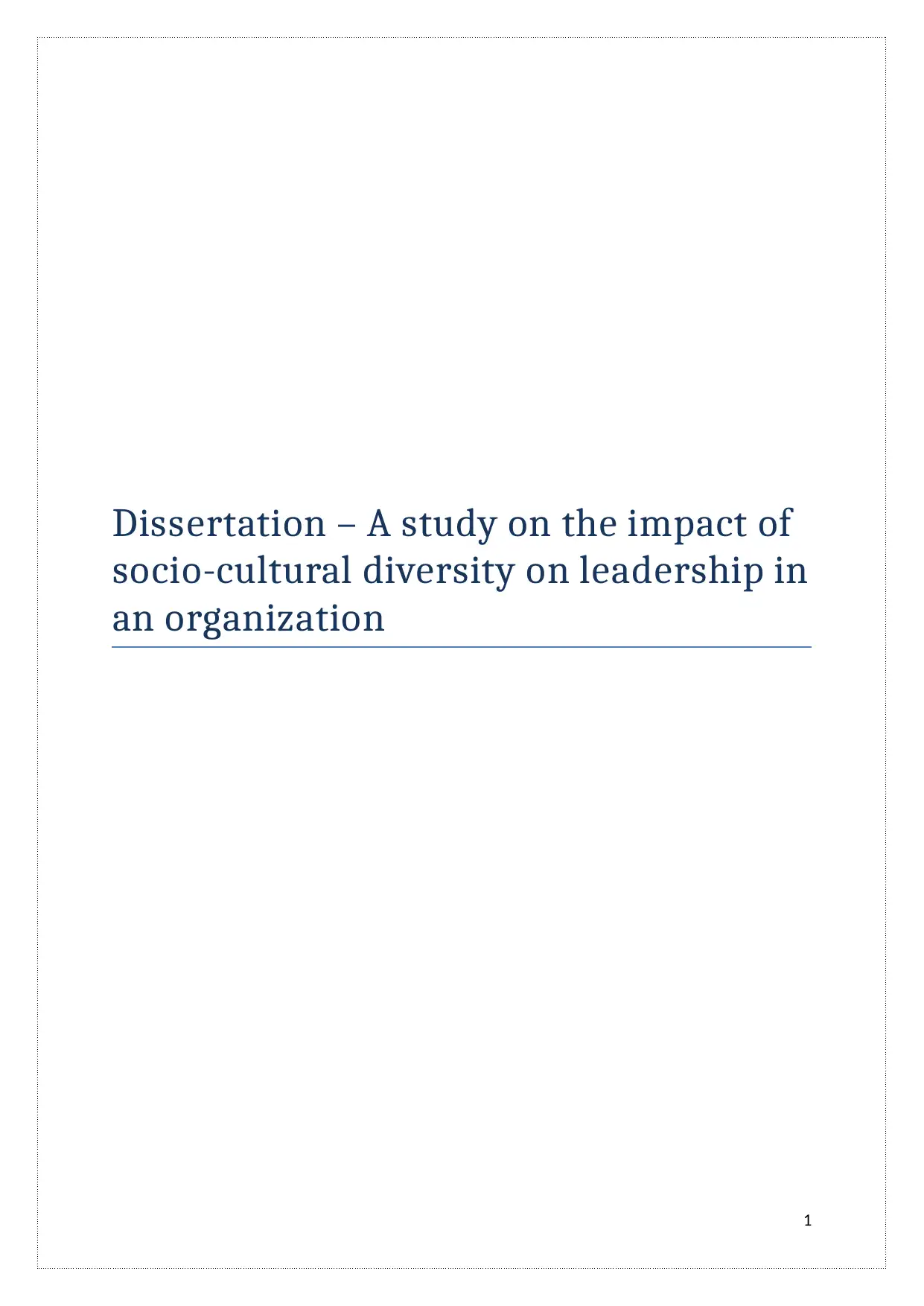
Dissertation – A study on the impact of
socio-cultural diversity on leadership in
an organization
1
socio-cultural diversity on leadership in
an organization
1
Secure Best Marks with AI Grader
Need help grading? Try our AI Grader for instant feedback on your assignments.

Abstract
In today’s business world, every organization is striving hard to attract and
retain the best of talents, as it is now clear, that it is the human resources who make
or break the organization. Workforce diversity is one such very eminent concept, and
it is the imperative for every organization to bring in and manage diversity in its work
settings. It was the aim of this paper, to understand how diversity in the form of
socio-cultural aspects impacts the organization’s leadership and other operations.
Diageo Plc was chosen as the target organization on which the primary research
was conducted. Diageo was selected, as it is one of the most diverse companies of
today – having presence in more than 180 countries and employing more than
30,000 individuals.
Primary research and secondary research were conducted. Secondary
research in the form of literature review was done, where journals, articles, books
and studies conducted by large corporate were analyzed and the findings presented.
Primary research was done in two modes – qualitative research and quantitative
research on the management executives and employees of Diageo. It was found
that, diversity impacts leadership, and it is inclusive leadership which helps in the
sustenance and improvement of such diversity in the work settings of Diageo Plc.
2
In today’s business world, every organization is striving hard to attract and
retain the best of talents, as it is now clear, that it is the human resources who make
or break the organization. Workforce diversity is one such very eminent concept, and
it is the imperative for every organization to bring in and manage diversity in its work
settings. It was the aim of this paper, to understand how diversity in the form of
socio-cultural aspects impacts the organization’s leadership and other operations.
Diageo Plc was chosen as the target organization on which the primary research
was conducted. Diageo was selected, as it is one of the most diverse companies of
today – having presence in more than 180 countries and employing more than
30,000 individuals.
Primary research and secondary research were conducted. Secondary
research in the form of literature review was done, where journals, articles, books
and studies conducted by large corporate were analyzed and the findings presented.
Primary research was done in two modes – qualitative research and quantitative
research on the management executives and employees of Diageo. It was found
that, diversity impacts leadership, and it is inclusive leadership which helps in the
sustenance and improvement of such diversity in the work settings of Diageo Plc.
2
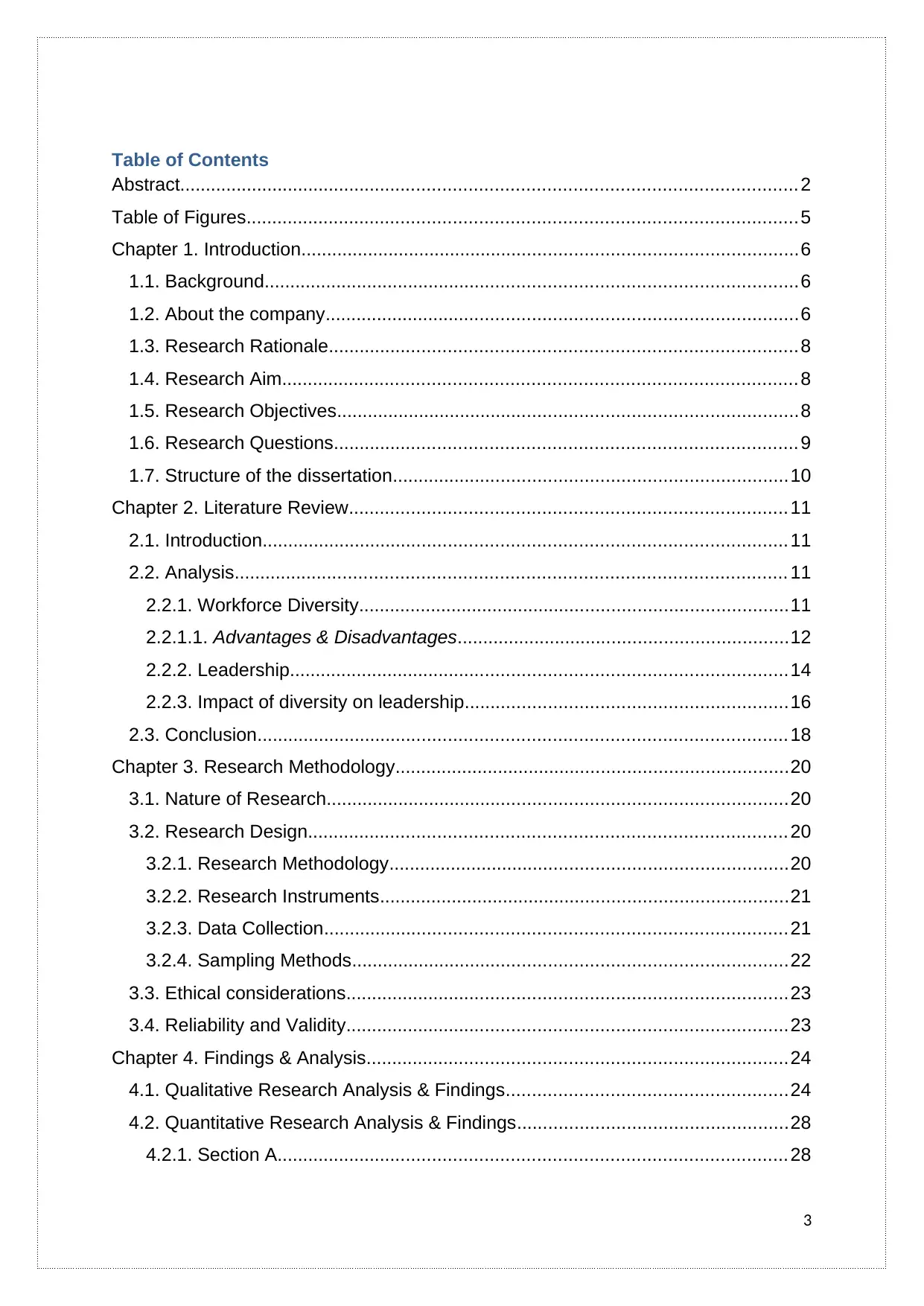
Table of Contents
Abstract....................................................................................................................... 2
Table of Figures..........................................................................................................5
Chapter 1. Introduction................................................................................................6
1.1. Background.......................................................................................................6
1.2. About the company...........................................................................................6
1.3. Research Rationale..........................................................................................8
1.4. Research Aim................................................................................................... 8
1.5. Research Objectives.........................................................................................8
1.6. Research Questions......................................................................................... 9
1.7. Structure of the dissertation............................................................................10
Chapter 2. Literature Review.................................................................................... 11
2.1. Introduction.....................................................................................................11
2.2. Analysis.......................................................................................................... 11
2.2.1. Workforce Diversity...................................................................................11
2.2.1.1. Advantages & Disadvantages................................................................12
2.2.2. Leadership................................................................................................14
2.2.3. Impact of diversity on leadership..............................................................16
2.3. Conclusion......................................................................................................18
Chapter 3. Research Methodology............................................................................20
3.1. Nature of Research.........................................................................................20
3.2. Research Design............................................................................................ 20
3.2.1. Research Methodology.............................................................................20
3.2.2. Research Instruments...............................................................................21
3.2.3. Data Collection.........................................................................................21
3.2.4. Sampling Methods....................................................................................22
3.3. Ethical considerations.....................................................................................23
3.4. Reliability and Validity.....................................................................................23
Chapter 4. Findings & Analysis.................................................................................24
4.1. Qualitative Research Analysis & Findings......................................................24
4.2. Quantitative Research Analysis & Findings....................................................28
4.2.1. Section A.................................................................................................. 28
3
Abstract....................................................................................................................... 2
Table of Figures..........................................................................................................5
Chapter 1. Introduction................................................................................................6
1.1. Background.......................................................................................................6
1.2. About the company...........................................................................................6
1.3. Research Rationale..........................................................................................8
1.4. Research Aim................................................................................................... 8
1.5. Research Objectives.........................................................................................8
1.6. Research Questions......................................................................................... 9
1.7. Structure of the dissertation............................................................................10
Chapter 2. Literature Review.................................................................................... 11
2.1. Introduction.....................................................................................................11
2.2. Analysis.......................................................................................................... 11
2.2.1. Workforce Diversity...................................................................................11
2.2.1.1. Advantages & Disadvantages................................................................12
2.2.2. Leadership................................................................................................14
2.2.3. Impact of diversity on leadership..............................................................16
2.3. Conclusion......................................................................................................18
Chapter 3. Research Methodology............................................................................20
3.1. Nature of Research.........................................................................................20
3.2. Research Design............................................................................................ 20
3.2.1. Research Methodology.............................................................................20
3.2.2. Research Instruments...............................................................................21
3.2.3. Data Collection.........................................................................................21
3.2.4. Sampling Methods....................................................................................22
3.3. Ethical considerations.....................................................................................23
3.4. Reliability and Validity.....................................................................................23
Chapter 4. Findings & Analysis.................................................................................24
4.1. Qualitative Research Analysis & Findings......................................................24
4.2. Quantitative Research Analysis & Findings....................................................28
4.2.1. Section A.................................................................................................. 28
3
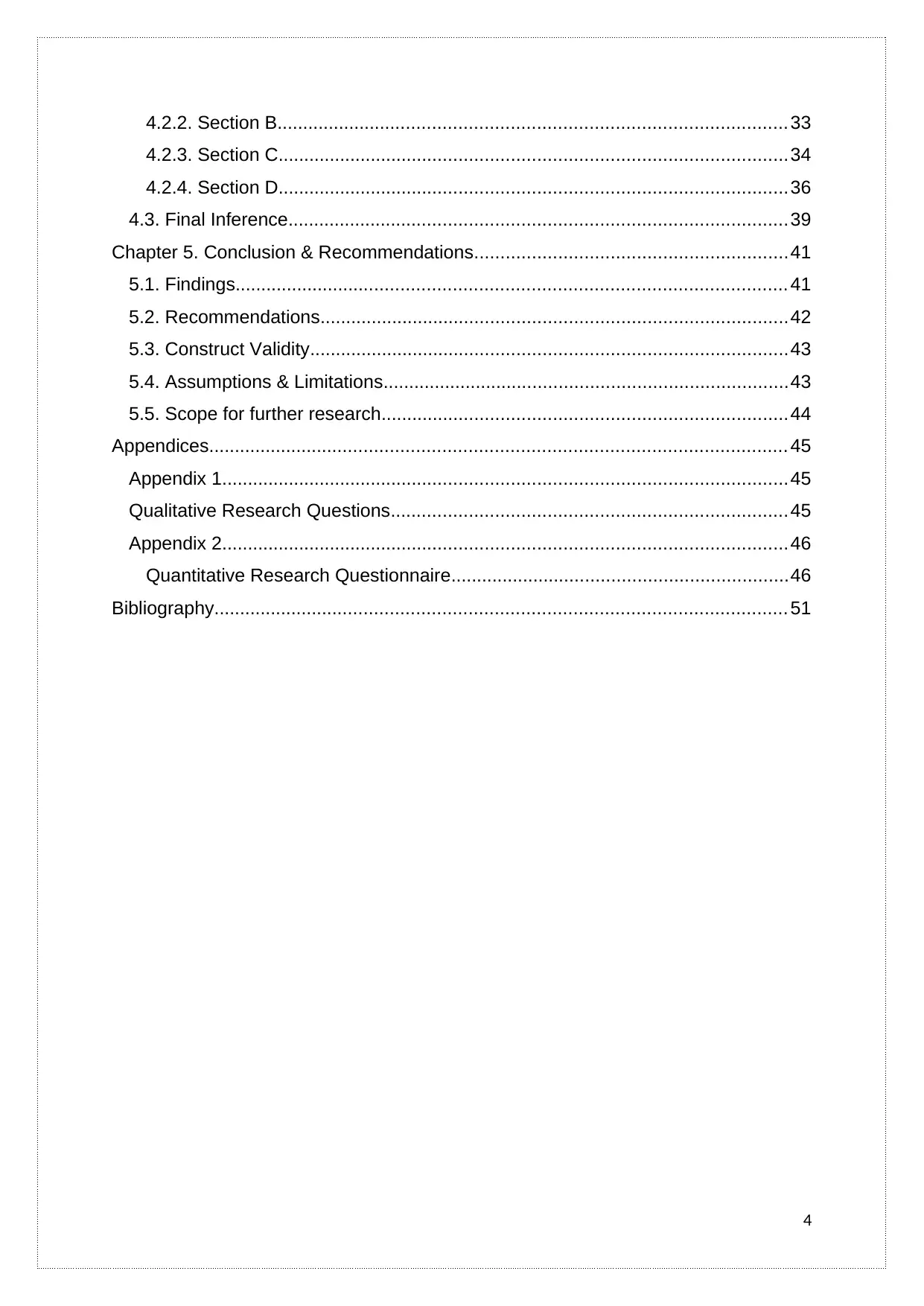
4.2.2. Section B.................................................................................................. 33
4.2.3. Section C..................................................................................................34
4.2.4. Section D..................................................................................................36
4.3. Final Inference................................................................................................39
Chapter 5. Conclusion & Recommendations............................................................41
5.1. Findings.......................................................................................................... 41
5.2. Recommendations..........................................................................................42
5.3. Construct Validity............................................................................................43
5.4. Assumptions & Limitations..............................................................................43
5.5. Scope for further research..............................................................................44
Appendices............................................................................................................... 45
Appendix 1.............................................................................................................45
Qualitative Research Questions............................................................................45
Appendix 2.............................................................................................................46
Quantitative Research Questionnaire.................................................................46
Bibliography.............................................................................................................. 51
4
4.2.3. Section C..................................................................................................34
4.2.4. Section D..................................................................................................36
4.3. Final Inference................................................................................................39
Chapter 5. Conclusion & Recommendations............................................................41
5.1. Findings.......................................................................................................... 41
5.2. Recommendations..........................................................................................42
5.3. Construct Validity............................................................................................43
5.4. Assumptions & Limitations..............................................................................43
5.5. Scope for further research..............................................................................44
Appendices............................................................................................................... 45
Appendix 1.............................................................................................................45
Qualitative Research Questions............................................................................45
Appendix 2.............................................................................................................46
Quantitative Research Questionnaire.................................................................46
Bibliography.............................................................................................................. 51
4
Secure Best Marks with AI Grader
Need help grading? Try our AI Grader for instant feedback on your assignments.

Table of Figures
Figure 1 - Gender Distribution of the QR2 Respondents..........................................26
Figure 2 - Age Distribution of the QR2 Respondents................................................27
Figure 3 - Total Work Experience of the QR2 Respondents.....................................27
Figure 4 - Total Association / Work Experience of the QR2 Respondents with Diageo
Plc............................................................................................................................. 28
Figure 5 - Knowledge about Workforce Diversity......................................................28
Figure 6 - Company supports Diversity & Inclusion..................................................29
Figure 7 - Adequate Initiatives present in the company for supporting diversity and
inclusion.................................................................................................................... 29
Figure 8 - Impact of Workforce Diversity...................................................................30
Figure 9 - Challenges which arise when diversity is not managed adequately.........31
Figure 10 -Important aspects of organization to bring about diversity and inclusion. 32
Figure 11 - Diageo Plc has adequate diversity policies.............................................32
Figure 12 - The leadership policies of Diageo are effective in bringing about diversity
and inclusion............................................................................................................. 33
Figure 13 - Advantages of leadership at Diageo Plc.................................................33
Figure 14 - Whether diversity impacts leadership.....................................................34
Figure 15 - Impact of Diversity on Leadership...........................................................35
Figure 16 - Whether leadership at Diageo Plc needs improvement..........................35
5
Figure 1 - Gender Distribution of the QR2 Respondents..........................................26
Figure 2 - Age Distribution of the QR2 Respondents................................................27
Figure 3 - Total Work Experience of the QR2 Respondents.....................................27
Figure 4 - Total Association / Work Experience of the QR2 Respondents with Diageo
Plc............................................................................................................................. 28
Figure 5 - Knowledge about Workforce Diversity......................................................28
Figure 6 - Company supports Diversity & Inclusion..................................................29
Figure 7 - Adequate Initiatives present in the company for supporting diversity and
inclusion.................................................................................................................... 29
Figure 8 - Impact of Workforce Diversity...................................................................30
Figure 9 - Challenges which arise when diversity is not managed adequately.........31
Figure 10 -Important aspects of organization to bring about diversity and inclusion. 32
Figure 11 - Diageo Plc has adequate diversity policies.............................................32
Figure 12 - The leadership policies of Diageo are effective in bringing about diversity
and inclusion............................................................................................................. 33
Figure 13 - Advantages of leadership at Diageo Plc.................................................33
Figure 14 - Whether diversity impacts leadership.....................................................34
Figure 15 - Impact of Diversity on Leadership...........................................................35
Figure 16 - Whether leadership at Diageo Plc needs improvement..........................35
5
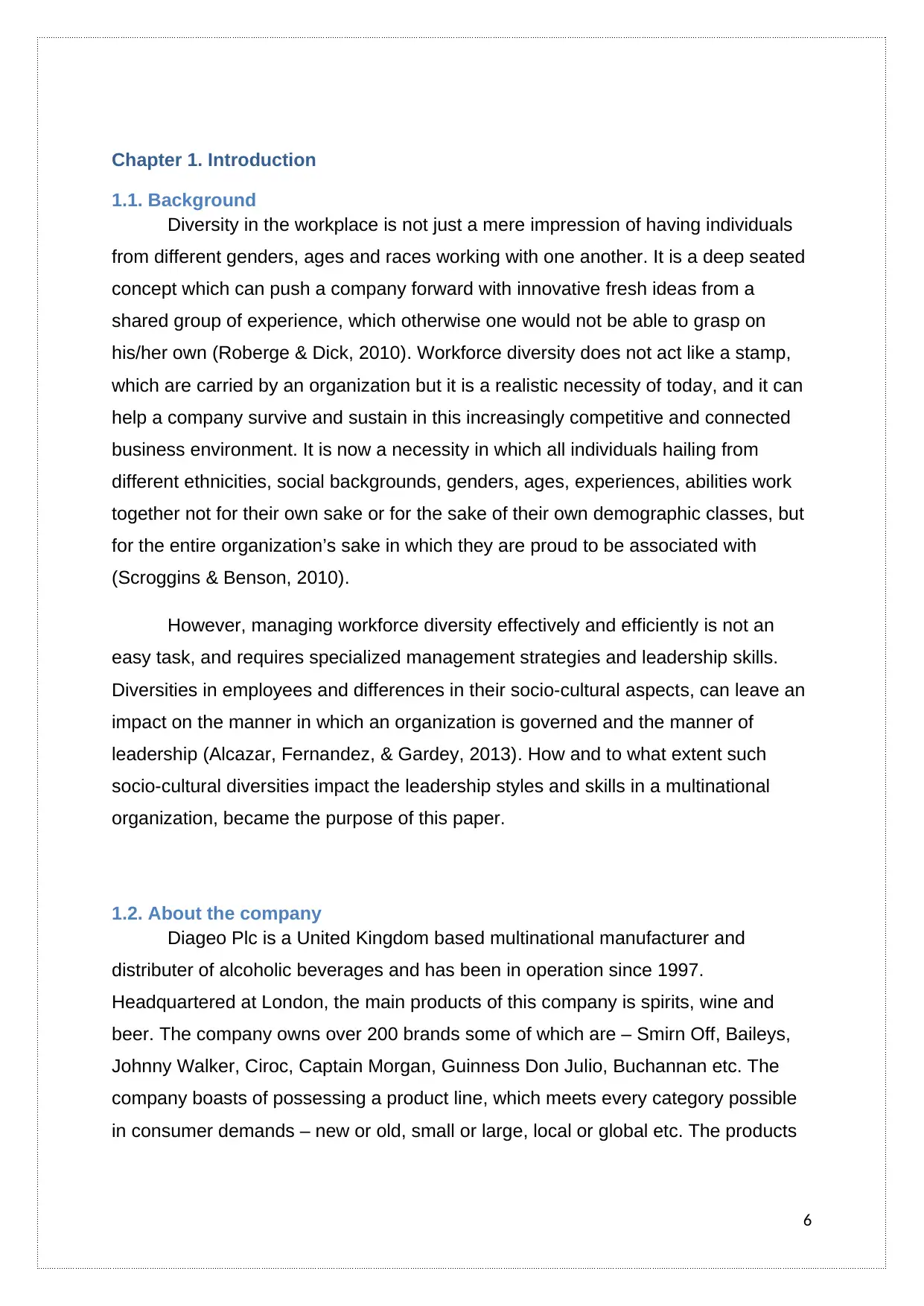
Chapter 1. Introduction
1.1. Background
Diversity in the workplace is not just a mere impression of having individuals
from different genders, ages and races working with one another. It is a deep seated
concept which can push a company forward with innovative fresh ideas from a
shared group of experience, which otherwise one would not be able to grasp on
his/her own (Roberge & Dick, 2010). Workforce diversity does not act like a stamp,
which are carried by an organization but it is a realistic necessity of today, and it can
help a company survive and sustain in this increasingly competitive and connected
business environment. It is now a necessity in which all individuals hailing from
different ethnicities, social backgrounds, genders, ages, experiences, abilities work
together not for their own sake or for the sake of their own demographic classes, but
for the entire organization’s sake in which they are proud to be associated with
(Scroggins & Benson, 2010).
However, managing workforce diversity effectively and efficiently is not an
easy task, and requires specialized management strategies and leadership skills.
Diversities in employees and differences in their socio-cultural aspects, can leave an
impact on the manner in which an organization is governed and the manner of
leadership (Alcazar, Fernandez, & Gardey, 2013). How and to what extent such
socio-cultural diversities impact the leadership styles and skills in a multinational
organization, became the purpose of this paper.
1.2. About the company
Diageo Plc is a United Kingdom based multinational manufacturer and
distributer of alcoholic beverages and has been in operation since 1997.
Headquartered at London, the main products of this company is spirits, wine and
beer. The company owns over 200 brands some of which are – Smirn Off, Baileys,
Johnny Walker, Ciroc, Captain Morgan, Guinness Don Julio, Buchannan etc. The
company boasts of possessing a product line, which meets every category possible
in consumer demands – new or old, small or large, local or global etc. The products
6
1.1. Background
Diversity in the workplace is not just a mere impression of having individuals
from different genders, ages and races working with one another. It is a deep seated
concept which can push a company forward with innovative fresh ideas from a
shared group of experience, which otherwise one would not be able to grasp on
his/her own (Roberge & Dick, 2010). Workforce diversity does not act like a stamp,
which are carried by an organization but it is a realistic necessity of today, and it can
help a company survive and sustain in this increasingly competitive and connected
business environment. It is now a necessity in which all individuals hailing from
different ethnicities, social backgrounds, genders, ages, experiences, abilities work
together not for their own sake or for the sake of their own demographic classes, but
for the entire organization’s sake in which they are proud to be associated with
(Scroggins & Benson, 2010).
However, managing workforce diversity effectively and efficiently is not an
easy task, and requires specialized management strategies and leadership skills.
Diversities in employees and differences in their socio-cultural aspects, can leave an
impact on the manner in which an organization is governed and the manner of
leadership (Alcazar, Fernandez, & Gardey, 2013). How and to what extent such
socio-cultural diversities impact the leadership styles and skills in a multinational
organization, became the purpose of this paper.
1.2. About the company
Diageo Plc is a United Kingdom based multinational manufacturer and
distributer of alcoholic beverages and has been in operation since 1997.
Headquartered at London, the main products of this company is spirits, wine and
beer. The company owns over 200 brands some of which are – Smirn Off, Baileys,
Johnny Walker, Ciroc, Captain Morgan, Guinness Don Julio, Buchannan etc. The
company boasts of possessing a product line, which meets every category possible
in consumer demands – new or old, small or large, local or global etc. The products
6
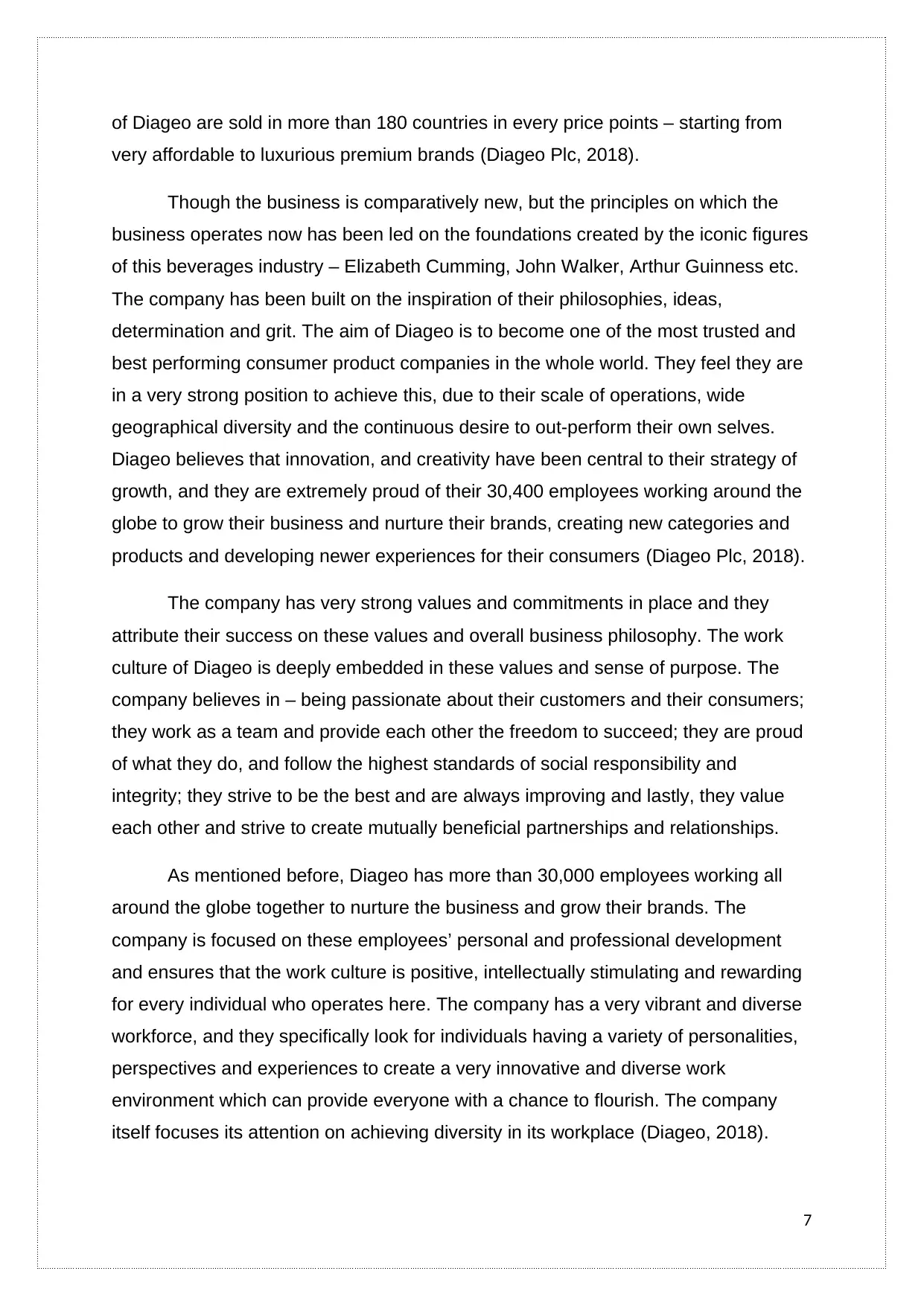
of Diageo are sold in more than 180 countries in every price points – starting from
very affordable to luxurious premium brands (Diageo Plc, 2018).
Though the business is comparatively new, but the principles on which the
business operates now has been led on the foundations created by the iconic figures
of this beverages industry – Elizabeth Cumming, John Walker, Arthur Guinness etc.
The company has been built on the inspiration of their philosophies, ideas,
determination and grit. The aim of Diageo is to become one of the most trusted and
best performing consumer product companies in the whole world. They feel they are
in a very strong position to achieve this, due to their scale of operations, wide
geographical diversity and the continuous desire to out-perform their own selves.
Diageo believes that innovation, and creativity have been central to their strategy of
growth, and they are extremely proud of their 30,400 employees working around the
globe to grow their business and nurture their brands, creating new categories and
products and developing newer experiences for their consumers (Diageo Plc, 2018).
The company has very strong values and commitments in place and they
attribute their success on these values and overall business philosophy. The work
culture of Diageo is deeply embedded in these values and sense of purpose. The
company believes in – being passionate about their customers and their consumers;
they work as a team and provide each other the freedom to succeed; they are proud
of what they do, and follow the highest standards of social responsibility and
integrity; they strive to be the best and are always improving and lastly, they value
each other and strive to create mutually beneficial partnerships and relationships.
As mentioned before, Diageo has more than 30,000 employees working all
around the globe together to nurture the business and grow their brands. The
company is focused on these employees’ personal and professional development
and ensures that the work culture is positive, intellectually stimulating and rewarding
for every individual who operates here. The company has a very vibrant and diverse
workforce, and they specifically look for individuals having a variety of personalities,
perspectives and experiences to create a very innovative and diverse work
environment which can provide everyone with a chance to flourish. The company
itself focuses its attention on achieving diversity in its workplace (Diageo, 2018).
7
very affordable to luxurious premium brands (Diageo Plc, 2018).
Though the business is comparatively new, but the principles on which the
business operates now has been led on the foundations created by the iconic figures
of this beverages industry – Elizabeth Cumming, John Walker, Arthur Guinness etc.
The company has been built on the inspiration of their philosophies, ideas,
determination and grit. The aim of Diageo is to become one of the most trusted and
best performing consumer product companies in the whole world. They feel they are
in a very strong position to achieve this, due to their scale of operations, wide
geographical diversity and the continuous desire to out-perform their own selves.
Diageo believes that innovation, and creativity have been central to their strategy of
growth, and they are extremely proud of their 30,400 employees working around the
globe to grow their business and nurture their brands, creating new categories and
products and developing newer experiences for their consumers (Diageo Plc, 2018).
The company has very strong values and commitments in place and they
attribute their success on these values and overall business philosophy. The work
culture of Diageo is deeply embedded in these values and sense of purpose. The
company believes in – being passionate about their customers and their consumers;
they work as a team and provide each other the freedom to succeed; they are proud
of what they do, and follow the highest standards of social responsibility and
integrity; they strive to be the best and are always improving and lastly, they value
each other and strive to create mutually beneficial partnerships and relationships.
As mentioned before, Diageo has more than 30,000 employees working all
around the globe together to nurture the business and grow their brands. The
company is focused on these employees’ personal and professional development
and ensures that the work culture is positive, intellectually stimulating and rewarding
for every individual who operates here. The company has a very vibrant and diverse
workforce, and they specifically look for individuals having a variety of personalities,
perspectives and experiences to create a very innovative and diverse work
environment which can provide everyone with a chance to flourish. The company
itself focuses its attention on achieving diversity in its workplace (Diageo, 2018).
7
Paraphrase This Document
Need a fresh take? Get an instant paraphrase of this document with our AI Paraphraser
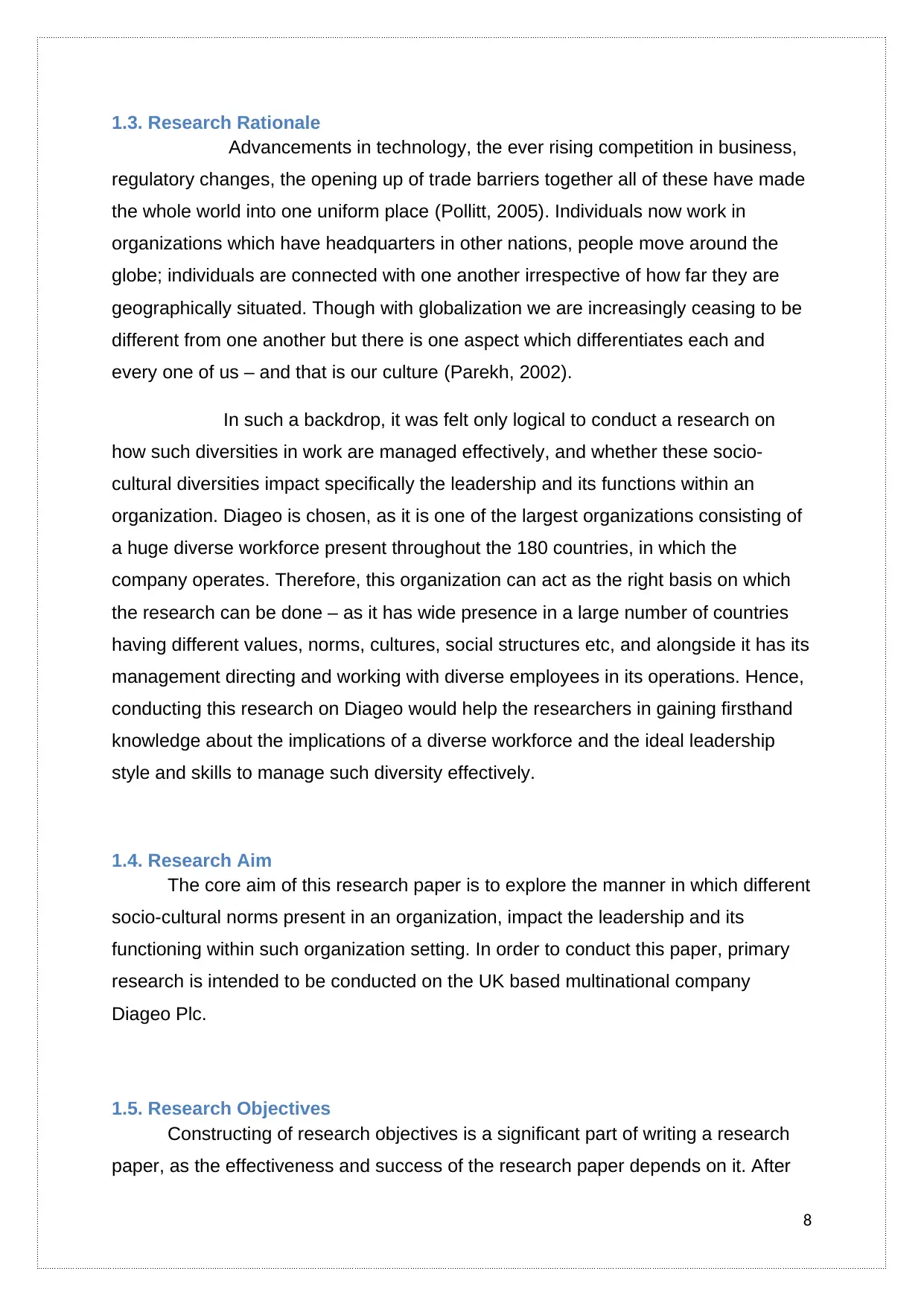
1.3. Research Rationale
Advancements in technology, the ever rising competition in business,
regulatory changes, the opening up of trade barriers together all of these have made
the whole world into one uniform place (Pollitt, 2005). Individuals now work in
organizations which have headquarters in other nations, people move around the
globe; individuals are connected with one another irrespective of how far they are
geographically situated. Though with globalization we are increasingly ceasing to be
different from one another but there is one aspect which differentiates each and
every one of us – and that is our culture (Parekh, 2002).
In such a backdrop, it was felt only logical to conduct a research on
how such diversities in work are managed effectively, and whether these socio-
cultural diversities impact specifically the leadership and its functions within an
organization. Diageo is chosen, as it is one of the largest organizations consisting of
a huge diverse workforce present throughout the 180 countries, in which the
company operates. Therefore, this organization can act as the right basis on which
the research can be done – as it has wide presence in a large number of countries
having different values, norms, cultures, social structures etc, and alongside it has its
management directing and working with diverse employees in its operations. Hence,
conducting this research on Diageo would help the researchers in gaining firsthand
knowledge about the implications of a diverse workforce and the ideal leadership
style and skills to manage such diversity effectively.
1.4. Research Aim
The core aim of this research paper is to explore the manner in which different
socio-cultural norms present in an organization, impact the leadership and its
functioning within such organization setting. In order to conduct this paper, primary
research is intended to be conducted on the UK based multinational company
Diageo Plc.
1.5. Research Objectives
Constructing of research objectives is a significant part of writing a research
paper, as the effectiveness and success of the research paper depends on it. After
8
Advancements in technology, the ever rising competition in business,
regulatory changes, the opening up of trade barriers together all of these have made
the whole world into one uniform place (Pollitt, 2005). Individuals now work in
organizations which have headquarters in other nations, people move around the
globe; individuals are connected with one another irrespective of how far they are
geographically situated. Though with globalization we are increasingly ceasing to be
different from one another but there is one aspect which differentiates each and
every one of us – and that is our culture (Parekh, 2002).
In such a backdrop, it was felt only logical to conduct a research on
how such diversities in work are managed effectively, and whether these socio-
cultural diversities impact specifically the leadership and its functions within an
organization. Diageo is chosen, as it is one of the largest organizations consisting of
a huge diverse workforce present throughout the 180 countries, in which the
company operates. Therefore, this organization can act as the right basis on which
the research can be done – as it has wide presence in a large number of countries
having different values, norms, cultures, social structures etc, and alongside it has its
management directing and working with diverse employees in its operations. Hence,
conducting this research on Diageo would help the researchers in gaining firsthand
knowledge about the implications of a diverse workforce and the ideal leadership
style and skills to manage such diversity effectively.
1.4. Research Aim
The core aim of this research paper is to explore the manner in which different
socio-cultural norms present in an organization, impact the leadership and its
functioning within such organization setting. In order to conduct this paper, primary
research is intended to be conducted on the UK based multinational company
Diageo Plc.
1.5. Research Objectives
Constructing of research objectives is a significant part of writing a research
paper, as the effectiveness and success of the research paper depends on it. After
8
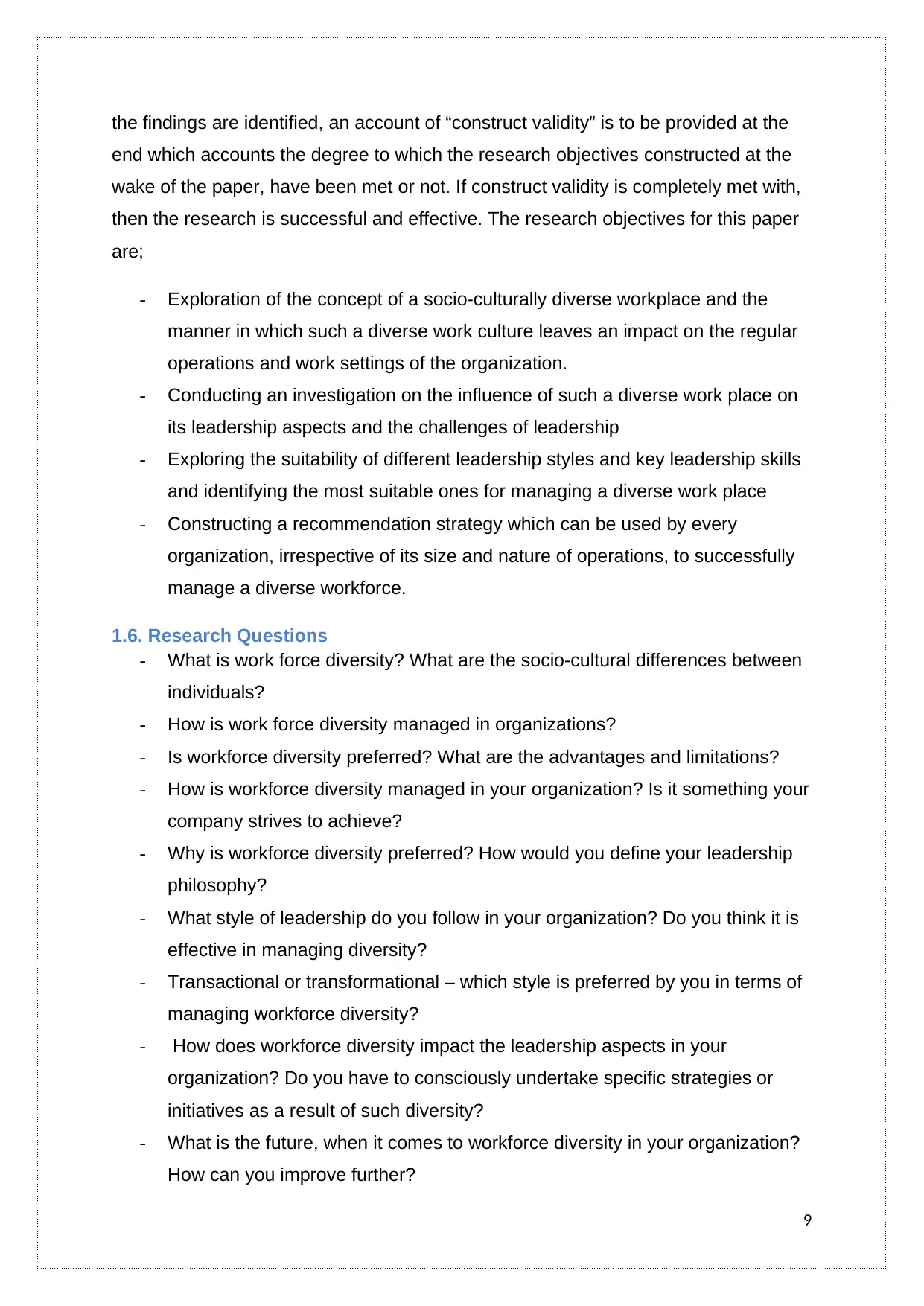
the findings are identified, an account of “construct validity” is to be provided at the
end which accounts the degree to which the research objectives constructed at the
wake of the paper, have been met or not. If construct validity is completely met with,
then the research is successful and effective. The research objectives for this paper
are;
- Exploration of the concept of a socio-culturally diverse workplace and the
manner in which such a diverse work culture leaves an impact on the regular
operations and work settings of the organization.
- Conducting an investigation on the influence of such a diverse work place on
its leadership aspects and the challenges of leadership
- Exploring the suitability of different leadership styles and key leadership skills
and identifying the most suitable ones for managing a diverse work place
- Constructing a recommendation strategy which can be used by every
organization, irrespective of its size and nature of operations, to successfully
manage a diverse workforce.
1.6. Research Questions
- What is work force diversity? What are the socio-cultural differences between
individuals?
- How is work force diversity managed in organizations?
- Is workforce diversity preferred? What are the advantages and limitations?
- How is workforce diversity managed in your organization? Is it something your
company strives to achieve?
- Why is workforce diversity preferred? How would you define your leadership
philosophy?
- What style of leadership do you follow in your organization? Do you think it is
effective in managing diversity?
- Transactional or transformational – which style is preferred by you in terms of
managing workforce diversity?
- How does workforce diversity impact the leadership aspects in your
organization? Do you have to consciously undertake specific strategies or
initiatives as a result of such diversity?
- What is the future, when it comes to workforce diversity in your organization?
How can you improve further?
9
end which accounts the degree to which the research objectives constructed at the
wake of the paper, have been met or not. If construct validity is completely met with,
then the research is successful and effective. The research objectives for this paper
are;
- Exploration of the concept of a socio-culturally diverse workplace and the
manner in which such a diverse work culture leaves an impact on the regular
operations and work settings of the organization.
- Conducting an investigation on the influence of such a diverse work place on
its leadership aspects and the challenges of leadership
- Exploring the suitability of different leadership styles and key leadership skills
and identifying the most suitable ones for managing a diverse work place
- Constructing a recommendation strategy which can be used by every
organization, irrespective of its size and nature of operations, to successfully
manage a diverse workforce.
1.6. Research Questions
- What is work force diversity? What are the socio-cultural differences between
individuals?
- How is work force diversity managed in organizations?
- Is workforce diversity preferred? What are the advantages and limitations?
- How is workforce diversity managed in your organization? Is it something your
company strives to achieve?
- Why is workforce diversity preferred? How would you define your leadership
philosophy?
- What style of leadership do you follow in your organization? Do you think it is
effective in managing diversity?
- Transactional or transformational – which style is preferred by you in terms of
managing workforce diversity?
- How does workforce diversity impact the leadership aspects in your
organization? Do you have to consciously undertake specific strategies or
initiatives as a result of such diversity?
- What is the future, when it comes to workforce diversity in your organization?
How can you improve further?
9
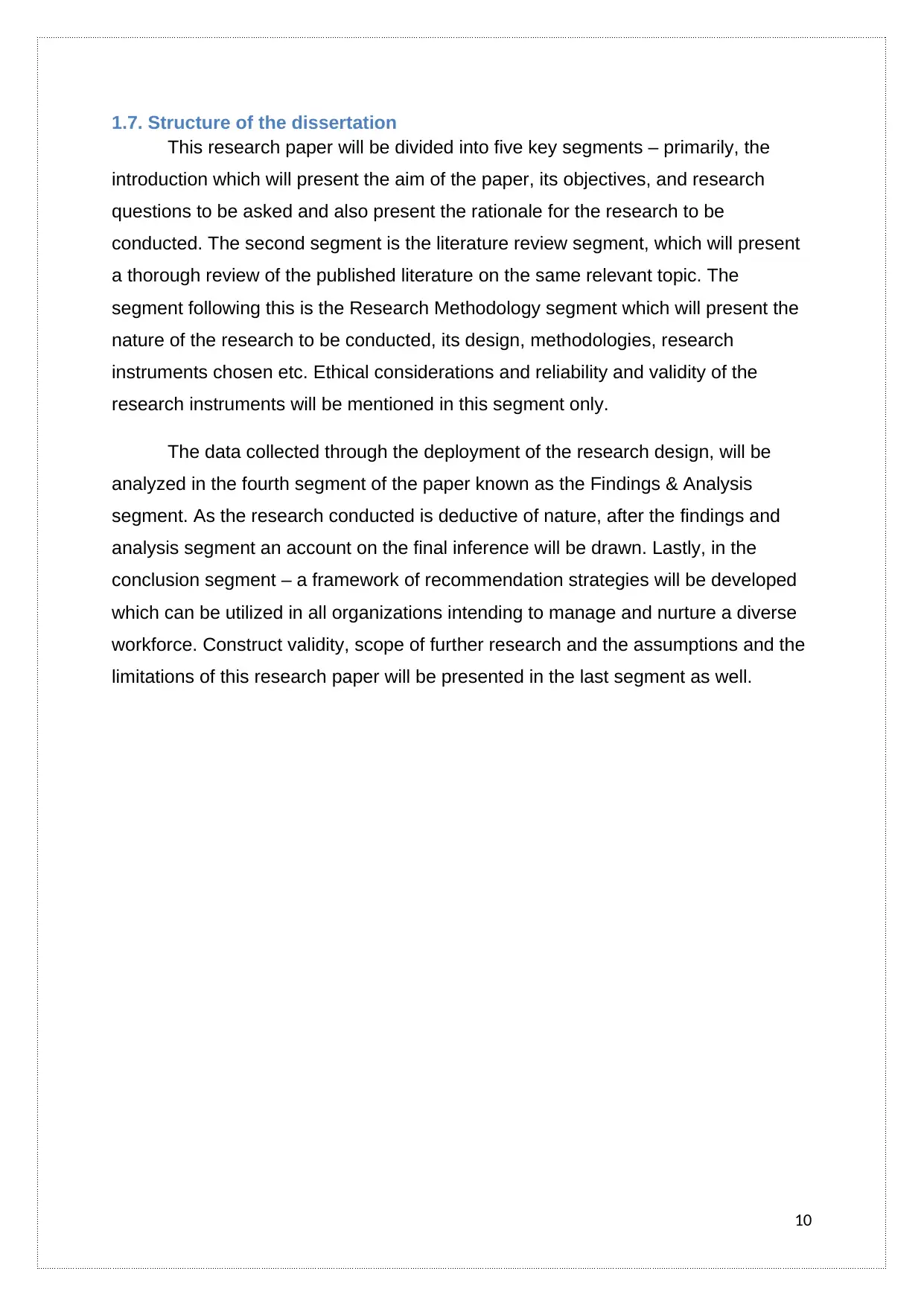
1.7. Structure of the dissertation
This research paper will be divided into five key segments – primarily, the
introduction which will present the aim of the paper, its objectives, and research
questions to be asked and also present the rationale for the research to be
conducted. The second segment is the literature review segment, which will present
a thorough review of the published literature on the same relevant topic. The
segment following this is the Research Methodology segment which will present the
nature of the research to be conducted, its design, methodologies, research
instruments chosen etc. Ethical considerations and reliability and validity of the
research instruments will be mentioned in this segment only.
The data collected through the deployment of the research design, will be
analyzed in the fourth segment of the paper known as the Findings & Analysis
segment. As the research conducted is deductive of nature, after the findings and
analysis segment an account on the final inference will be drawn. Lastly, in the
conclusion segment – a framework of recommendation strategies will be developed
which can be utilized in all organizations intending to manage and nurture a diverse
workforce. Construct validity, scope of further research and the assumptions and the
limitations of this research paper will be presented in the last segment as well.
10
This research paper will be divided into five key segments – primarily, the
introduction which will present the aim of the paper, its objectives, and research
questions to be asked and also present the rationale for the research to be
conducted. The second segment is the literature review segment, which will present
a thorough review of the published literature on the same relevant topic. The
segment following this is the Research Methodology segment which will present the
nature of the research to be conducted, its design, methodologies, research
instruments chosen etc. Ethical considerations and reliability and validity of the
research instruments will be mentioned in this segment only.
The data collected through the deployment of the research design, will be
analyzed in the fourth segment of the paper known as the Findings & Analysis
segment. As the research conducted is deductive of nature, after the findings and
analysis segment an account on the final inference will be drawn. Lastly, in the
conclusion segment – a framework of recommendation strategies will be developed
which can be utilized in all organizations intending to manage and nurture a diverse
workforce. Construct validity, scope of further research and the assumptions and the
limitations of this research paper will be presented in the last segment as well.
10
Secure Best Marks with AI Grader
Need help grading? Try our AI Grader for instant feedback on your assignments.
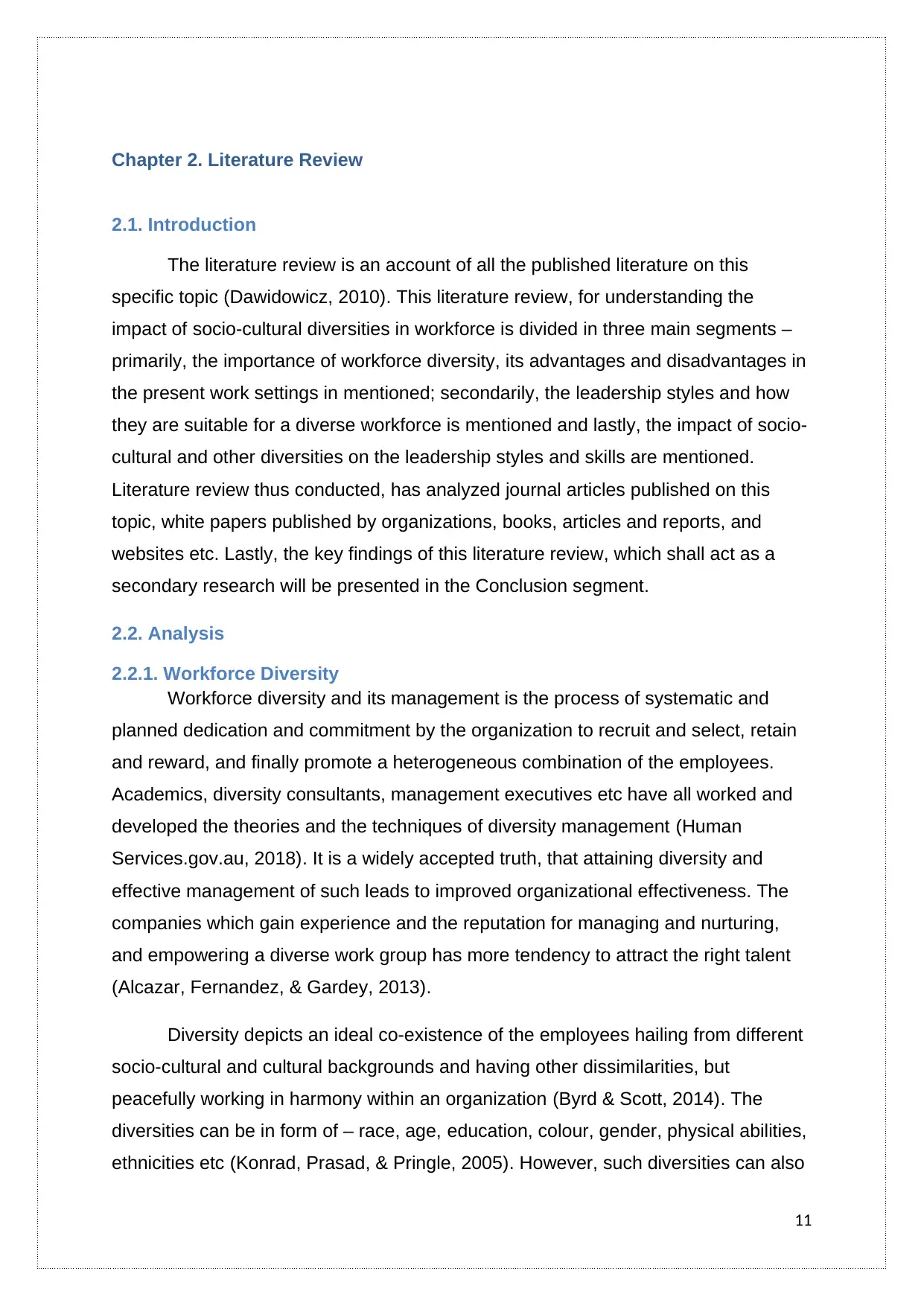
Chapter 2. Literature Review
2.1. Introduction
The literature review is an account of all the published literature on this
specific topic (Dawidowicz, 2010). This literature review, for understanding the
impact of socio-cultural diversities in workforce is divided in three main segments –
primarily, the importance of workforce diversity, its advantages and disadvantages in
the present work settings in mentioned; secondarily, the leadership styles and how
they are suitable for a diverse workforce is mentioned and lastly, the impact of socio-
cultural and other diversities on the leadership styles and skills are mentioned.
Literature review thus conducted, has analyzed journal articles published on this
topic, white papers published by organizations, books, articles and reports, and
websites etc. Lastly, the key findings of this literature review, which shall act as a
secondary research will be presented in the Conclusion segment.
2.2. Analysis
2.2.1. Workforce Diversity
Workforce diversity and its management is the process of systematic and
planned dedication and commitment by the organization to recruit and select, retain
and reward, and finally promote a heterogeneous combination of the employees.
Academics, diversity consultants, management executives etc have all worked and
developed the theories and the techniques of diversity management (Human
Services.gov.au, 2018). It is a widely accepted truth, that attaining diversity and
effective management of such leads to improved organizational effectiveness. The
companies which gain experience and the reputation for managing and nurturing,
and empowering a diverse work group has more tendency to attract the right talent
(Alcazar, Fernandez, & Gardey, 2013).
Diversity depicts an ideal co-existence of the employees hailing from different
socio-cultural and cultural backgrounds and having other dissimilarities, but
peacefully working in harmony within an organization (Byrd & Scott, 2014). The
diversities can be in form of – race, age, education, colour, gender, physical abilities,
ethnicities etc (Konrad, Prasad, & Pringle, 2005). However, such diversities can also
11
2.1. Introduction
The literature review is an account of all the published literature on this
specific topic (Dawidowicz, 2010). This literature review, for understanding the
impact of socio-cultural diversities in workforce is divided in three main segments –
primarily, the importance of workforce diversity, its advantages and disadvantages in
the present work settings in mentioned; secondarily, the leadership styles and how
they are suitable for a diverse workforce is mentioned and lastly, the impact of socio-
cultural and other diversities on the leadership styles and skills are mentioned.
Literature review thus conducted, has analyzed journal articles published on this
topic, white papers published by organizations, books, articles and reports, and
websites etc. Lastly, the key findings of this literature review, which shall act as a
secondary research will be presented in the Conclusion segment.
2.2. Analysis
2.2.1. Workforce Diversity
Workforce diversity and its management is the process of systematic and
planned dedication and commitment by the organization to recruit and select, retain
and reward, and finally promote a heterogeneous combination of the employees.
Academics, diversity consultants, management executives etc have all worked and
developed the theories and the techniques of diversity management (Human
Services.gov.au, 2018). It is a widely accepted truth, that attaining diversity and
effective management of such leads to improved organizational effectiveness. The
companies which gain experience and the reputation for managing and nurturing,
and empowering a diverse work group has more tendency to attract the right talent
(Alcazar, Fernandez, & Gardey, 2013).
Diversity depicts an ideal co-existence of the employees hailing from different
socio-cultural and cultural backgrounds and having other dissimilarities, but
peacefully working in harmony within an organization (Byrd & Scott, 2014). The
diversities can be in form of – race, age, education, colour, gender, physical abilities,
ethnicities etc (Konrad, Prasad, & Pringle, 2005). However, such diversities can also
11
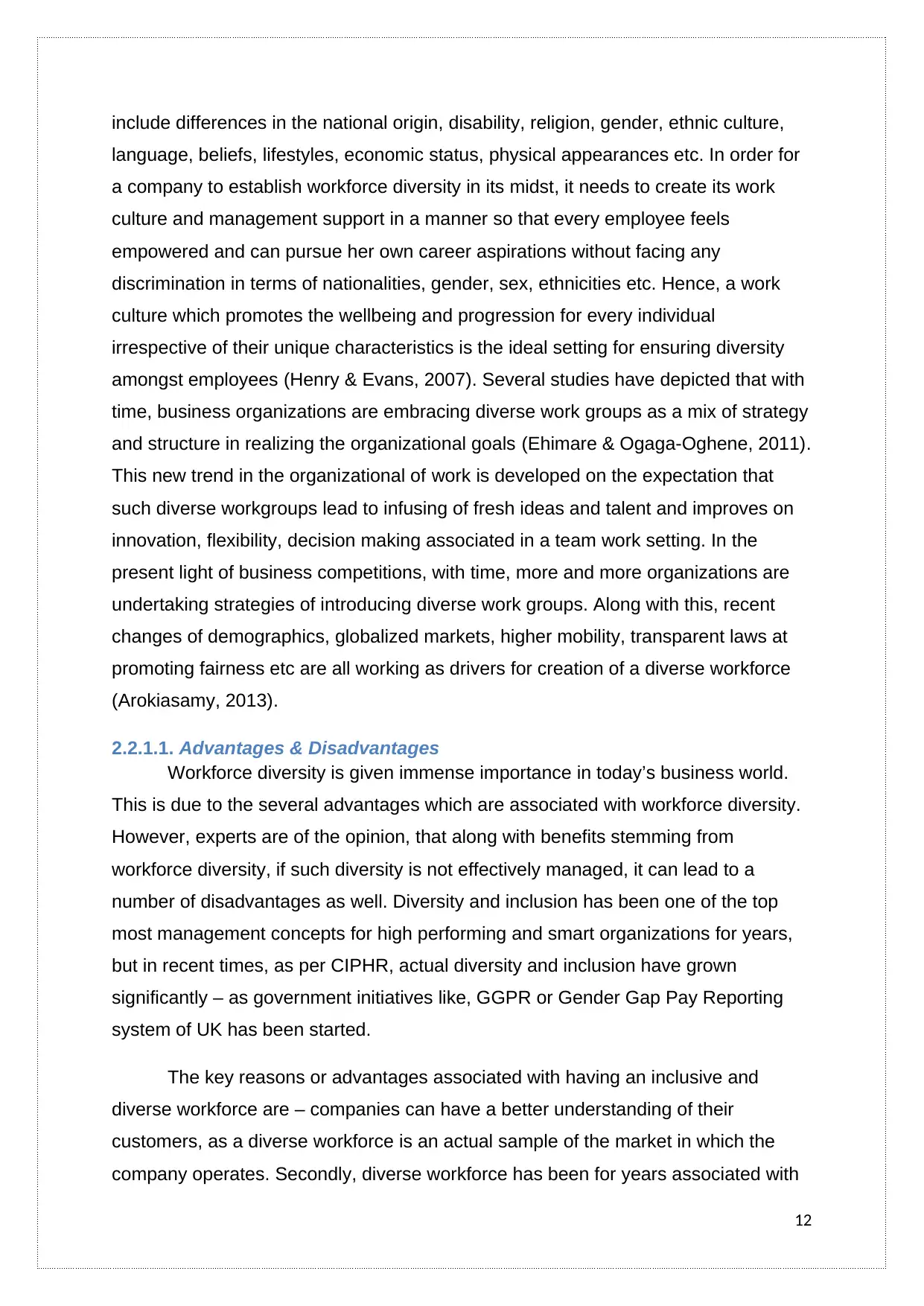
include differences in the national origin, disability, religion, gender, ethnic culture,
language, beliefs, lifestyles, economic status, physical appearances etc. In order for
a company to establish workforce diversity in its midst, it needs to create its work
culture and management support in a manner so that every employee feels
empowered and can pursue her own career aspirations without facing any
discrimination in terms of nationalities, gender, sex, ethnicities etc. Hence, a work
culture which promotes the wellbeing and progression for every individual
irrespective of their unique characteristics is the ideal setting for ensuring diversity
amongst employees (Henry & Evans, 2007). Several studies have depicted that with
time, business organizations are embracing diverse work groups as a mix of strategy
and structure in realizing the organizational goals (Ehimare & Ogaga-Oghene, 2011).
This new trend in the organizational of work is developed on the expectation that
such diverse workgroups lead to infusing of fresh ideas and talent and improves on
innovation, flexibility, decision making associated in a team work setting. In the
present light of business competitions, with time, more and more organizations are
undertaking strategies of introducing diverse work groups. Along with this, recent
changes of demographics, globalized markets, higher mobility, transparent laws at
promoting fairness etc are all working as drivers for creation of a diverse workforce
(Arokiasamy, 2013).
2.2.1.1. Advantages & Disadvantages
Workforce diversity is given immense importance in today’s business world.
This is due to the several advantages which are associated with workforce diversity.
However, experts are of the opinion, that along with benefits stemming from
workforce diversity, if such diversity is not effectively managed, it can lead to a
number of disadvantages as well. Diversity and inclusion has been one of the top
most management concepts for high performing and smart organizations for years,
but in recent times, as per CIPHR, actual diversity and inclusion have grown
significantly – as government initiatives like, GGPR or Gender Gap Pay Reporting
system of UK has been started.
The key reasons or advantages associated with having an inclusive and
diverse workforce are – companies can have a better understanding of their
customers, as a diverse workforce is an actual sample of the market in which the
company operates. Secondly, diverse workforce has been for years associated with
12
language, beliefs, lifestyles, economic status, physical appearances etc. In order for
a company to establish workforce diversity in its midst, it needs to create its work
culture and management support in a manner so that every employee feels
empowered and can pursue her own career aspirations without facing any
discrimination in terms of nationalities, gender, sex, ethnicities etc. Hence, a work
culture which promotes the wellbeing and progression for every individual
irrespective of their unique characteristics is the ideal setting for ensuring diversity
amongst employees (Henry & Evans, 2007). Several studies have depicted that with
time, business organizations are embracing diverse work groups as a mix of strategy
and structure in realizing the organizational goals (Ehimare & Ogaga-Oghene, 2011).
This new trend in the organizational of work is developed on the expectation that
such diverse workgroups lead to infusing of fresh ideas and talent and improves on
innovation, flexibility, decision making associated in a team work setting. In the
present light of business competitions, with time, more and more organizations are
undertaking strategies of introducing diverse work groups. Along with this, recent
changes of demographics, globalized markets, higher mobility, transparent laws at
promoting fairness etc are all working as drivers for creation of a diverse workforce
(Arokiasamy, 2013).
2.2.1.1. Advantages & Disadvantages
Workforce diversity is given immense importance in today’s business world.
This is due to the several advantages which are associated with workforce diversity.
However, experts are of the opinion, that along with benefits stemming from
workforce diversity, if such diversity is not effectively managed, it can lead to a
number of disadvantages as well. Diversity and inclusion has been one of the top
most management concepts for high performing and smart organizations for years,
but in recent times, as per CIPHR, actual diversity and inclusion have grown
significantly – as government initiatives like, GGPR or Gender Gap Pay Reporting
system of UK has been started.
The key reasons or advantages associated with having an inclusive and
diverse workforce are – companies can have a better understanding of their
customers, as a diverse workforce is an actual sample of the market in which the
company operates. Secondly, diverse workforce has been for years associated with
12
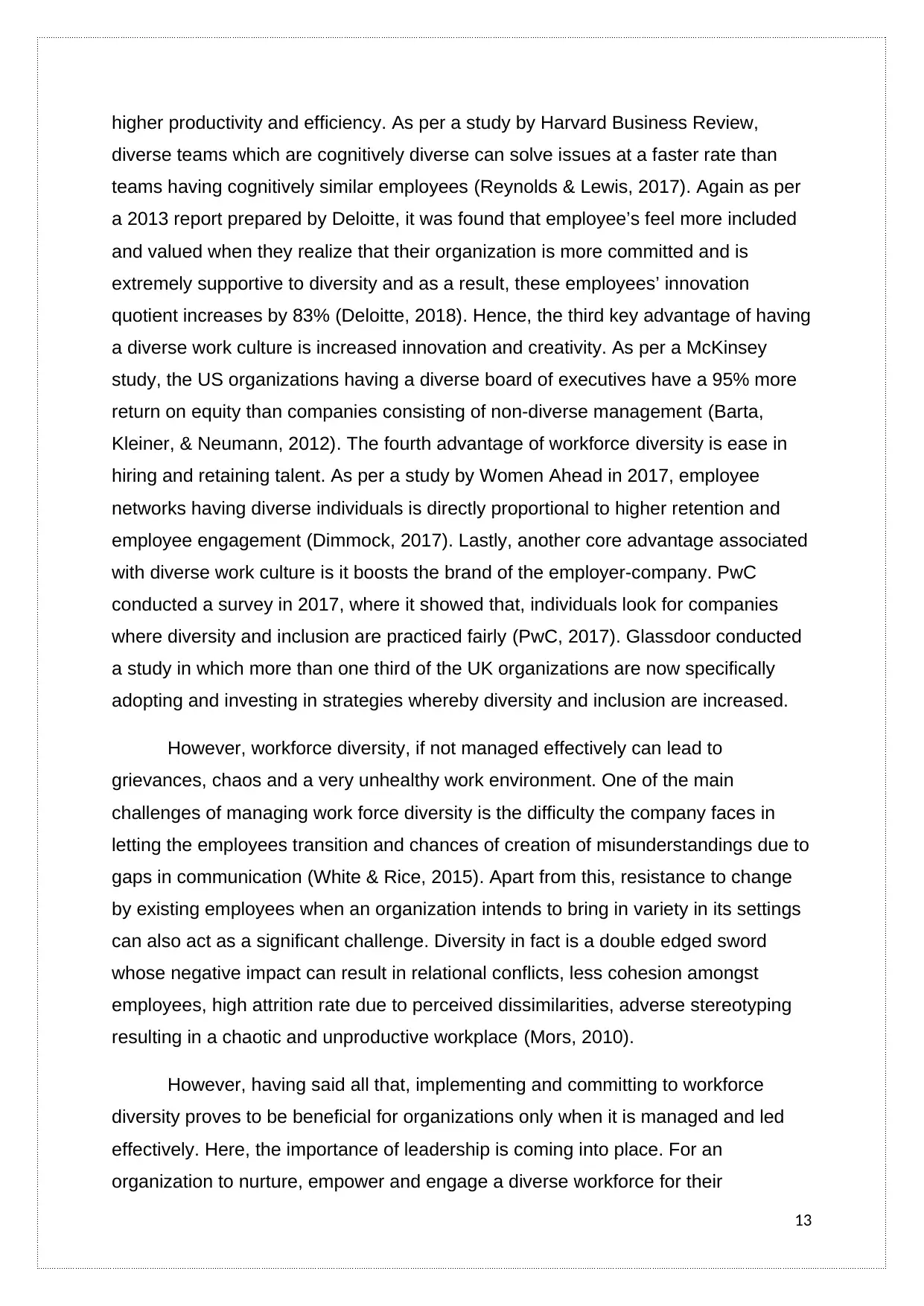
higher productivity and efficiency. As per a study by Harvard Business Review,
diverse teams which are cognitively diverse can solve issues at a faster rate than
teams having cognitively similar employees (Reynolds & Lewis, 2017). Again as per
a 2013 report prepared by Deloitte, it was found that employee’s feel more included
and valued when they realize that their organization is more committed and is
extremely supportive to diversity and as a result, these employees’ innovation
quotient increases by 83% (Deloitte, 2018). Hence, the third key advantage of having
a diverse work culture is increased innovation and creativity. As per a McKinsey
study, the US organizations having a diverse board of executives have a 95% more
return on equity than companies consisting of non-diverse management (Barta,
Kleiner, & Neumann, 2012). The fourth advantage of workforce diversity is ease in
hiring and retaining talent. As per a study by Women Ahead in 2017, employee
networks having diverse individuals is directly proportional to higher retention and
employee engagement (Dimmock, 2017). Lastly, another core advantage associated
with diverse work culture is it boosts the brand of the employer-company. PwC
conducted a survey in 2017, where it showed that, individuals look for companies
where diversity and inclusion are practiced fairly (PwC, 2017). Glassdoor conducted
a study in which more than one third of the UK organizations are now specifically
adopting and investing in strategies whereby diversity and inclusion are increased.
However, workforce diversity, if not managed effectively can lead to
grievances, chaos and a very unhealthy work environment. One of the main
challenges of managing work force diversity is the difficulty the company faces in
letting the employees transition and chances of creation of misunderstandings due to
gaps in communication (White & Rice, 2015). Apart from this, resistance to change
by existing employees when an organization intends to bring in variety in its settings
can also act as a significant challenge. Diversity in fact is a double edged sword
whose negative impact can result in relational conflicts, less cohesion amongst
employees, high attrition rate due to perceived dissimilarities, adverse stereotyping
resulting in a chaotic and unproductive workplace (Mors, 2010).
However, having said all that, implementing and committing to workforce
diversity proves to be beneficial for organizations only when it is managed and led
effectively. Here, the importance of leadership is coming into place. For an
organization to nurture, empower and engage a diverse workforce for their
13
diverse teams which are cognitively diverse can solve issues at a faster rate than
teams having cognitively similar employees (Reynolds & Lewis, 2017). Again as per
a 2013 report prepared by Deloitte, it was found that employee’s feel more included
and valued when they realize that their organization is more committed and is
extremely supportive to diversity and as a result, these employees’ innovation
quotient increases by 83% (Deloitte, 2018). Hence, the third key advantage of having
a diverse work culture is increased innovation and creativity. As per a McKinsey
study, the US organizations having a diverse board of executives have a 95% more
return on equity than companies consisting of non-diverse management (Barta,
Kleiner, & Neumann, 2012). The fourth advantage of workforce diversity is ease in
hiring and retaining talent. As per a study by Women Ahead in 2017, employee
networks having diverse individuals is directly proportional to higher retention and
employee engagement (Dimmock, 2017). Lastly, another core advantage associated
with diverse work culture is it boosts the brand of the employer-company. PwC
conducted a survey in 2017, where it showed that, individuals look for companies
where diversity and inclusion are practiced fairly (PwC, 2017). Glassdoor conducted
a study in which more than one third of the UK organizations are now specifically
adopting and investing in strategies whereby diversity and inclusion are increased.
However, workforce diversity, if not managed effectively can lead to
grievances, chaos and a very unhealthy work environment. One of the main
challenges of managing work force diversity is the difficulty the company faces in
letting the employees transition and chances of creation of misunderstandings due to
gaps in communication (White & Rice, 2015). Apart from this, resistance to change
by existing employees when an organization intends to bring in variety in its settings
can also act as a significant challenge. Diversity in fact is a double edged sword
whose negative impact can result in relational conflicts, less cohesion amongst
employees, high attrition rate due to perceived dissimilarities, adverse stereotyping
resulting in a chaotic and unproductive workplace (Mors, 2010).
However, having said all that, implementing and committing to workforce
diversity proves to be beneficial for organizations only when it is managed and led
effectively. Here, the importance of leadership is coming into place. For an
organization to nurture, empower and engage a diverse workforce for their
13
Paraphrase This Document
Need a fresh take? Get an instant paraphrase of this document with our AI Paraphraser

productivity and efficiency, effective and suitable leadership is a must (Cascio,
2018). Diversity in the workforce leaves impacts on the type of leadership to be
followed, as all styles of leadership will not be effective and can also be detrimental
for such a work culture. Therefore, choosing the right leadership style and skills is of
paramount importance. And this brings us to the second segment of this Literature
Review, that is, the suitability of leadership in a diverse work culture.
2.2.2. Leadership
Managers and organizational leaders have to possess certain attitudes and
skills, in order to effectively manage diversity. The management of diversity involves
acceptance, respect and acknowledgement (Roberge & Dick, 2010). Management
has to develop the right attitude and ethical values which will make them neutral and
treat everyone as the same (Pitts & Wise, 2010). Leaders have to understand that
they need to primarily build accountability in their system with the managers taking
responsibility for creating and nurturing diverse and inclusive work environment. It is
of crucial importance that along with top management, the intermediate managers
must also practice and be aligned with the top management in their actions (Olsen &
Martins, 2012).
As leaders, their words and actions leave a direct impact on the existence and
sustenance of workplace diversity. An effective leader has to undertake a number of
actions, in order to promote workplace diversity in his organization. These are –
primarily, time must be given and attention must be provided to the colleagues who
are pro-diversity; effective balancing must be done to help and support every
subordinate and peers; spreading of responsibilities equally amongst the
organization and adequate delegation of work must be done so that no one is left out
or a single group of individuals are given more work and all the complaints
associated with biasness and discrimination must be carefully dealt with (Agbor,
2008). Along with this, it is crucial for a leader who wants to effectively manage their
workforce diversity to take a stand whenever appropriate behaviour is displayed in
his work settings. The leader must be open and encourage communication from all
his colleagues (Amit, 2006). The leader herself/himself must be aware about the
unconscious biasness which can creep in, and when unsure must be confident to
ask for help (Gaudiano & Hunt, 2017). These are some of the aspects which are
14
2018). Diversity in the workforce leaves impacts on the type of leadership to be
followed, as all styles of leadership will not be effective and can also be detrimental
for such a work culture. Therefore, choosing the right leadership style and skills is of
paramount importance. And this brings us to the second segment of this Literature
Review, that is, the suitability of leadership in a diverse work culture.
2.2.2. Leadership
Managers and organizational leaders have to possess certain attitudes and
skills, in order to effectively manage diversity. The management of diversity involves
acceptance, respect and acknowledgement (Roberge & Dick, 2010). Management
has to develop the right attitude and ethical values which will make them neutral and
treat everyone as the same (Pitts & Wise, 2010). Leaders have to understand that
they need to primarily build accountability in their system with the managers taking
responsibility for creating and nurturing diverse and inclusive work environment. It is
of crucial importance that along with top management, the intermediate managers
must also practice and be aligned with the top management in their actions (Olsen &
Martins, 2012).
As leaders, their words and actions leave a direct impact on the existence and
sustenance of workplace diversity. An effective leader has to undertake a number of
actions, in order to promote workplace diversity in his organization. These are –
primarily, time must be given and attention must be provided to the colleagues who
are pro-diversity; effective balancing must be done to help and support every
subordinate and peers; spreading of responsibilities equally amongst the
organization and adequate delegation of work must be done so that no one is left out
or a single group of individuals are given more work and all the complaints
associated with biasness and discrimination must be carefully dealt with (Agbor,
2008). Along with this, it is crucial for a leader who wants to effectively manage their
workforce diversity to take a stand whenever appropriate behaviour is displayed in
his work settings. The leader must be open and encourage communication from all
his colleagues (Amit, 2006). The leader herself/himself must be aware about the
unconscious biasness which can creep in, and when unsure must be confident to
ask for help (Gaudiano & Hunt, 2017). These are some of the aspects which are
14
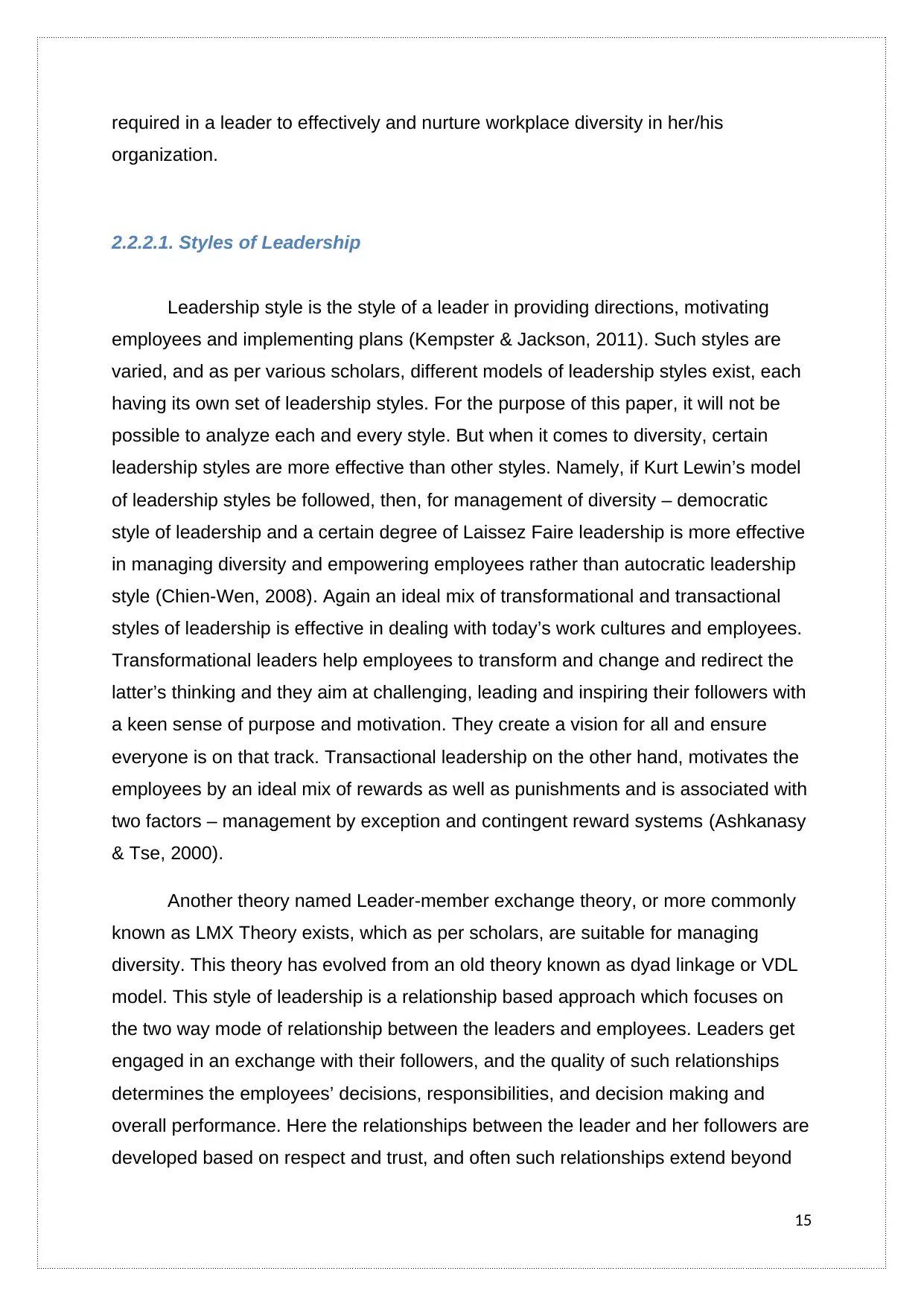
required in a leader to effectively and nurture workplace diversity in her/his
organization.
2.2.2.1. Styles of Leadership
Leadership style is the style of a leader in providing directions, motivating
employees and implementing plans (Kempster & Jackson, 2011). Such styles are
varied, and as per various scholars, different models of leadership styles exist, each
having its own set of leadership styles. For the purpose of this paper, it will not be
possible to analyze each and every style. But when it comes to diversity, certain
leadership styles are more effective than other styles. Namely, if Kurt Lewin’s model
of leadership styles be followed, then, for management of diversity – democratic
style of leadership and a certain degree of Laissez Faire leadership is more effective
in managing diversity and empowering employees rather than autocratic leadership
style (Chien-Wen, 2008). Again an ideal mix of transformational and transactional
styles of leadership is effective in dealing with today’s work cultures and employees.
Transformational leaders help employees to transform and change and redirect the
latter’s thinking and they aim at challenging, leading and inspiring their followers with
a keen sense of purpose and motivation. They create a vision for all and ensure
everyone is on that track. Transactional leadership on the other hand, motivates the
employees by an ideal mix of rewards as well as punishments and is associated with
two factors – management by exception and contingent reward systems (Ashkanasy
& Tse, 2000).
Another theory named Leader-member exchange theory, or more commonly
known as LMX Theory exists, which as per scholars, are suitable for managing
diversity. This theory has evolved from an old theory known as dyad linkage or VDL
model. This style of leadership is a relationship based approach which focuses on
the two way mode of relationship between the leaders and employees. Leaders get
engaged in an exchange with their followers, and the quality of such relationships
determines the employees’ decisions, responsibilities, and decision making and
overall performance. Here the relationships between the leader and her followers are
developed based on respect and trust, and often such relationships extend beyond
15
organization.
2.2.2.1. Styles of Leadership
Leadership style is the style of a leader in providing directions, motivating
employees and implementing plans (Kempster & Jackson, 2011). Such styles are
varied, and as per various scholars, different models of leadership styles exist, each
having its own set of leadership styles. For the purpose of this paper, it will not be
possible to analyze each and every style. But when it comes to diversity, certain
leadership styles are more effective than other styles. Namely, if Kurt Lewin’s model
of leadership styles be followed, then, for management of diversity – democratic
style of leadership and a certain degree of Laissez Faire leadership is more effective
in managing diversity and empowering employees rather than autocratic leadership
style (Chien-Wen, 2008). Again an ideal mix of transformational and transactional
styles of leadership is effective in dealing with today’s work cultures and employees.
Transformational leaders help employees to transform and change and redirect the
latter’s thinking and they aim at challenging, leading and inspiring their followers with
a keen sense of purpose and motivation. They create a vision for all and ensure
everyone is on that track. Transactional leadership on the other hand, motivates the
employees by an ideal mix of rewards as well as punishments and is associated with
two factors – management by exception and contingent reward systems (Ashkanasy
& Tse, 2000).
Another theory named Leader-member exchange theory, or more commonly
known as LMX Theory exists, which as per scholars, are suitable for managing
diversity. This theory has evolved from an old theory known as dyad linkage or VDL
model. This style of leadership is a relationship based approach which focuses on
the two way mode of relationship between the leaders and employees. Leaders get
engaged in an exchange with their followers, and the quality of such relationships
determines the employees’ decisions, responsibilities, and decision making and
overall performance. Here the relationships between the leader and her followers are
developed based on respect and trust, and often such relationships extend beyond
15
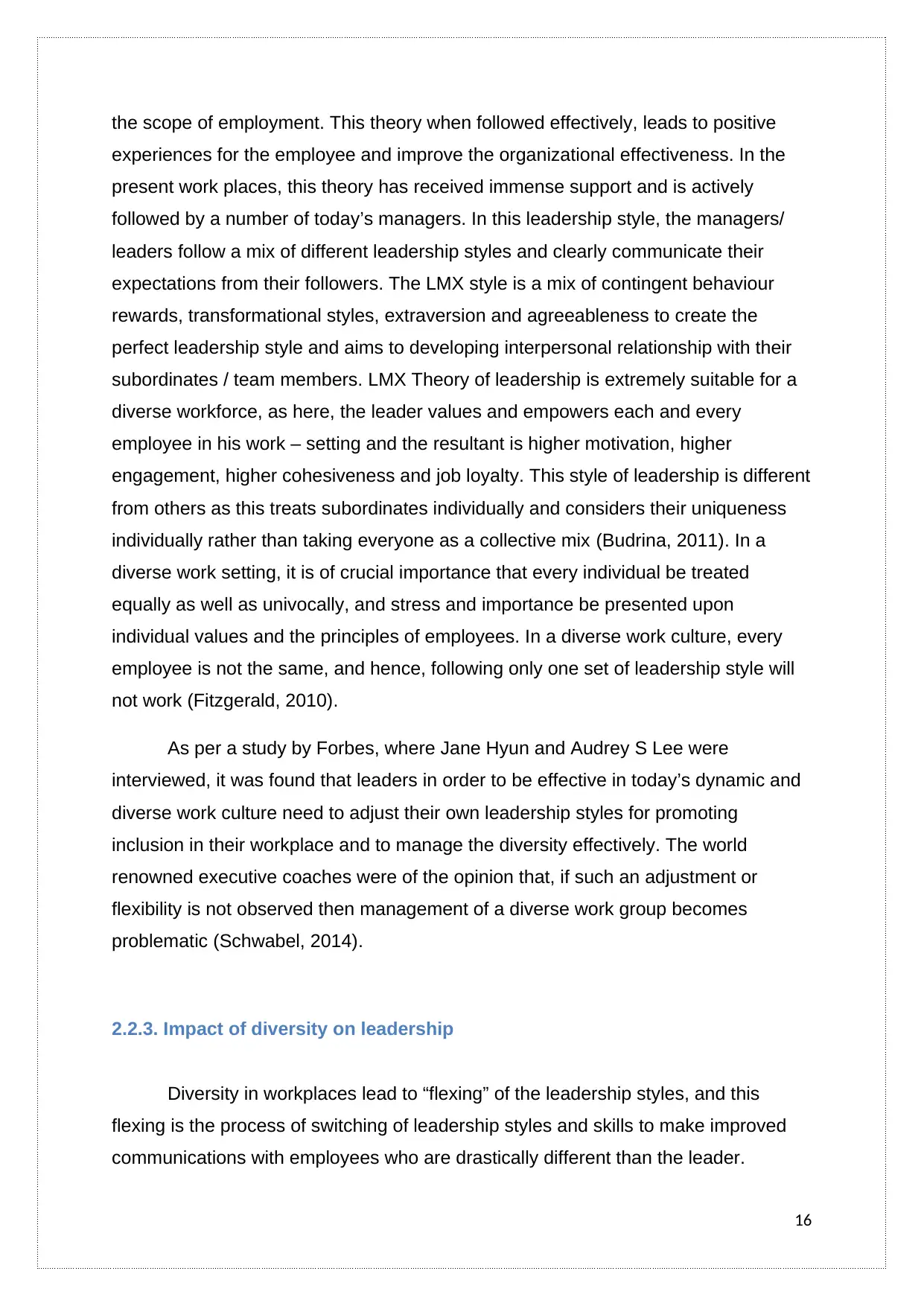
the scope of employment. This theory when followed effectively, leads to positive
experiences for the employee and improve the organizational effectiveness. In the
present work places, this theory has received immense support and is actively
followed by a number of today’s managers. In this leadership style, the managers/
leaders follow a mix of different leadership styles and clearly communicate their
expectations from their followers. The LMX style is a mix of contingent behaviour
rewards, transformational styles, extraversion and agreeableness to create the
perfect leadership style and aims to developing interpersonal relationship with their
subordinates / team members. LMX Theory of leadership is extremely suitable for a
diverse workforce, as here, the leader values and empowers each and every
employee in his work – setting and the resultant is higher motivation, higher
engagement, higher cohesiveness and job loyalty. This style of leadership is different
from others as this treats subordinates individually and considers their uniqueness
individually rather than taking everyone as a collective mix (Budrina, 2011). In a
diverse work setting, it is of crucial importance that every individual be treated
equally as well as univocally, and stress and importance be presented upon
individual values and the principles of employees. In a diverse work culture, every
employee is not the same, and hence, following only one set of leadership style will
not work (Fitzgerald, 2010).
As per a study by Forbes, where Jane Hyun and Audrey S Lee were
interviewed, it was found that leaders in order to be effective in today’s dynamic and
diverse work culture need to adjust their own leadership styles for promoting
inclusion in their workplace and to manage the diversity effectively. The world
renowned executive coaches were of the opinion that, if such an adjustment or
flexibility is not observed then management of a diverse work group becomes
problematic (Schwabel, 2014).
2.2.3. Impact of diversity on leadership
Diversity in workplaces lead to “flexing” of the leadership styles, and this
flexing is the process of switching of leadership styles and skills to make improved
communications with employees who are drastically different than the leader.
16
experiences for the employee and improve the organizational effectiveness. In the
present work places, this theory has received immense support and is actively
followed by a number of today’s managers. In this leadership style, the managers/
leaders follow a mix of different leadership styles and clearly communicate their
expectations from their followers. The LMX style is a mix of contingent behaviour
rewards, transformational styles, extraversion and agreeableness to create the
perfect leadership style and aims to developing interpersonal relationship with their
subordinates / team members. LMX Theory of leadership is extremely suitable for a
diverse workforce, as here, the leader values and empowers each and every
employee in his work – setting and the resultant is higher motivation, higher
engagement, higher cohesiveness and job loyalty. This style of leadership is different
from others as this treats subordinates individually and considers their uniqueness
individually rather than taking everyone as a collective mix (Budrina, 2011). In a
diverse work setting, it is of crucial importance that every individual be treated
equally as well as univocally, and stress and importance be presented upon
individual values and the principles of employees. In a diverse work culture, every
employee is not the same, and hence, following only one set of leadership style will
not work (Fitzgerald, 2010).
As per a study by Forbes, where Jane Hyun and Audrey S Lee were
interviewed, it was found that leaders in order to be effective in today’s dynamic and
diverse work culture need to adjust their own leadership styles for promoting
inclusion in their workplace and to manage the diversity effectively. The world
renowned executive coaches were of the opinion that, if such an adjustment or
flexibility is not observed then management of a diverse work group becomes
problematic (Schwabel, 2014).
2.2.3. Impact of diversity on leadership
Diversity in workplaces lead to “flexing” of the leadership styles, and this
flexing is the process of switching of leadership styles and skills to make improved
communications with employees who are drastically different than the leader.
16
Secure Best Marks with AI Grader
Need help grading? Try our AI Grader for instant feedback on your assignments.

Experts opine, that this “flexing” is not concerned with changing the nature of the
leader, but it is all about going beyond one’s comfort zone, to understand and
empathize with others who are different from one and also understand from where
the “diversity” is coming from. Though this sounds very easy, but in reality it is a
tough task for any leader or manager. It is natural for individuals to relate more with
people coming from similar expectations, backgrounds, perspectives and values.
Therefore, to go beyond this normal range and to consciously trying to relate with the
diverse work culture and with individual employees coming from diverse socio-
cultural backgrounds is a tough task (Schwabel, 2014). It is all about changing,
considering and understanding a totally different experience and the point of view.
Hyun and Lee are of the opinion that though it seems to be difficult but
leaders of diverse organizations must practice this flexing – the art of switching
leadership styles, and with time they will gain comfort and ease (Wassel, 2015). This
flexing will help them to develop improved relationships with employees, teams,
supervisors, colleagues and as well as customers. Hence, sticking to one specific
leadership style will not be effective in modern day organizations and depending on
the nature of the employees, teams etc leaders should modify their own styles to
relate and empathize well with others. Only then, the leaders can see the point of
view of others’ and this will help them be better at leading, at motivating, at
empowering and at engaging them (Schwabel, 2014).
When leaders in an organization are typically given the task of managing
diversity, they should primarily start with self analysis and self awareness. This will
help them to understand their own influences, backgrounds, perspectives and values
and then leaders should understand how such aspects shape the person he is and
the value he brings about in his company. Then the leader in question should be
curious about others who are present in his team / company and who are hailing
from diverse backgrounds. Questions like – how do these individuals communicate,
what impacts them, what is their own leadership styles and how it impacts the
organization, what are their differences, what are their challenges, how can they be
aligned with the system etc are questions which the leader must ask himself.
Constructive feedback must be sought and given and this shall make the employees
feel empowered and valued, and get the idea that the organization cares about them
(Kossek, et al., 2018). This promotes inclusiveness and diversity to a great extent.
17
leader, but it is all about going beyond one’s comfort zone, to understand and
empathize with others who are different from one and also understand from where
the “diversity” is coming from. Though this sounds very easy, but in reality it is a
tough task for any leader or manager. It is natural for individuals to relate more with
people coming from similar expectations, backgrounds, perspectives and values.
Therefore, to go beyond this normal range and to consciously trying to relate with the
diverse work culture and with individual employees coming from diverse socio-
cultural backgrounds is a tough task (Schwabel, 2014). It is all about changing,
considering and understanding a totally different experience and the point of view.
Hyun and Lee are of the opinion that though it seems to be difficult but
leaders of diverse organizations must practice this flexing – the art of switching
leadership styles, and with time they will gain comfort and ease (Wassel, 2015). This
flexing will help them to develop improved relationships with employees, teams,
supervisors, colleagues and as well as customers. Hence, sticking to one specific
leadership style will not be effective in modern day organizations and depending on
the nature of the employees, teams etc leaders should modify their own styles to
relate and empathize well with others. Only then, the leaders can see the point of
view of others’ and this will help them be better at leading, at motivating, at
empowering and at engaging them (Schwabel, 2014).
When leaders in an organization are typically given the task of managing
diversity, they should primarily start with self analysis and self awareness. This will
help them to understand their own influences, backgrounds, perspectives and values
and then leaders should understand how such aspects shape the person he is and
the value he brings about in his company. Then the leader in question should be
curious about others who are present in his team / company and who are hailing
from diverse backgrounds. Questions like – how do these individuals communicate,
what impacts them, what is their own leadership styles and how it impacts the
organization, what are their differences, what are their challenges, how can they be
aligned with the system etc are questions which the leader must ask himself.
Constructive feedback must be sought and given and this shall make the employees
feel empowered and valued, and get the idea that the organization cares about them
(Kossek, et al., 2018). This promotes inclusiveness and diversity to a great extent.
17

If diversity is not managed effectively it can lead to lack of engagement and
under utilization of the workforce. To only hire employees from diverse background is
superficial and does not reap any benefits if conscious initiatives are not taken to
obtain their complete engagement (Appel, Thomas, & Schmid, 2007). And with
disengaged employees, come associated problems like – low job satisfaction, low
motivation and higher employee turnover. As per a “Bureau of National Affairs”, it
was found that in United States alone, organizations lose approximate $ 11 billion
dollars per year, due to high employee turnover (Schwabel, 2014). Knowledge about
working with diverse workgroups aid companies with a competitive advantage as
diversity management is a strategic imperative which every organization needs to
leverage upon.
Power gap is another interesting aspect of leadership and plays a critical role
in leading diverse work groups. Power gap is the distance which separates a leader
from his employees (Maner & Mead, 2010). The more hierarchical the leader is in
the organization, the higher is the power gap. Closing of this gap, is required if a
leader typically intends to connect with his employees. Leaders must manage this
power gap in workplace carefully, as for employees hailing from different cultures
may have their own preferences. Some employees may prefer a higher more formal
power gap and for some employees, having a flat organization with low power gaps
with their managers can be preferred. When leaders effectively analyze each and
every employee under him, and decide their perspectives and nature, and values, it
becomes easier for the leaders to “flex” and to connect with these employees. And
with more support and connection, employees will be ready to participate fully and
will have a higher chance of improved performance and productivity. This will result
in creation of a strong employer brand and this will attract the right talent in the future
(Schwabel, 2014).
2.3. Conclusion
From the literature review thus conducted, it can be understood that workforce
diversity and inclusion is given immense importance by today’s high performing
organizations. This is due to the host of advantages associated with such diversity
and inclusion – improved performance, effective and fast problem solving, more
engaged work culture and improved innovation and creativity. However, this diversity
18
under utilization of the workforce. To only hire employees from diverse background is
superficial and does not reap any benefits if conscious initiatives are not taken to
obtain their complete engagement (Appel, Thomas, & Schmid, 2007). And with
disengaged employees, come associated problems like – low job satisfaction, low
motivation and higher employee turnover. As per a “Bureau of National Affairs”, it
was found that in United States alone, organizations lose approximate $ 11 billion
dollars per year, due to high employee turnover (Schwabel, 2014). Knowledge about
working with diverse workgroups aid companies with a competitive advantage as
diversity management is a strategic imperative which every organization needs to
leverage upon.
Power gap is another interesting aspect of leadership and plays a critical role
in leading diverse work groups. Power gap is the distance which separates a leader
from his employees (Maner & Mead, 2010). The more hierarchical the leader is in
the organization, the higher is the power gap. Closing of this gap, is required if a
leader typically intends to connect with his employees. Leaders must manage this
power gap in workplace carefully, as for employees hailing from different cultures
may have their own preferences. Some employees may prefer a higher more formal
power gap and for some employees, having a flat organization with low power gaps
with their managers can be preferred. When leaders effectively analyze each and
every employee under him, and decide their perspectives and nature, and values, it
becomes easier for the leaders to “flex” and to connect with these employees. And
with more support and connection, employees will be ready to participate fully and
will have a higher chance of improved performance and productivity. This will result
in creation of a strong employer brand and this will attract the right talent in the future
(Schwabel, 2014).
2.3. Conclusion
From the literature review thus conducted, it can be understood that workforce
diversity and inclusion is given immense importance by today’s high performing
organizations. This is due to the host of advantages associated with such diversity
and inclusion – improved performance, effective and fast problem solving, more
engaged work culture and improved innovation and creativity. However, this diversity
18
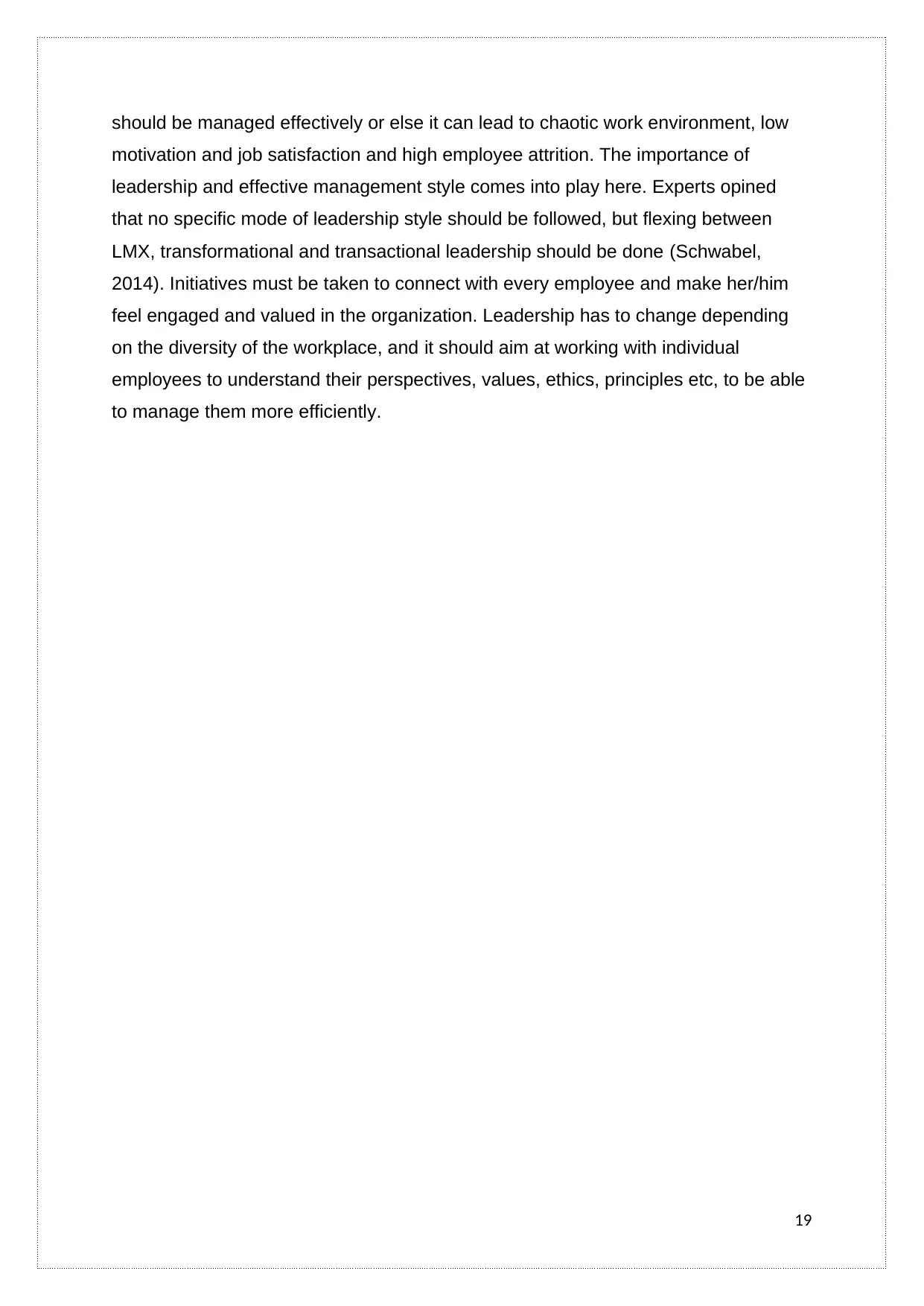
should be managed effectively or else it can lead to chaotic work environment, low
motivation and job satisfaction and high employee attrition. The importance of
leadership and effective management style comes into play here. Experts opined
that no specific mode of leadership style should be followed, but flexing between
LMX, transformational and transactional leadership should be done (Schwabel,
2014). Initiatives must be taken to connect with every employee and make her/him
feel engaged and valued in the organization. Leadership has to change depending
on the diversity of the workplace, and it should aim at working with individual
employees to understand their perspectives, values, ethics, principles etc, to be able
to manage them more efficiently.
19
motivation and job satisfaction and high employee attrition. The importance of
leadership and effective management style comes into play here. Experts opined
that no specific mode of leadership style should be followed, but flexing between
LMX, transformational and transactional leadership should be done (Schwabel,
2014). Initiatives must be taken to connect with every employee and make her/him
feel engaged and valued in the organization. Leadership has to change depending
on the diversity of the workplace, and it should aim at working with individual
employees to understand their perspectives, values, ethics, principles etc, to be able
to manage them more efficiently.
19
Paraphrase This Document
Need a fresh take? Get an instant paraphrase of this document with our AI Paraphraser
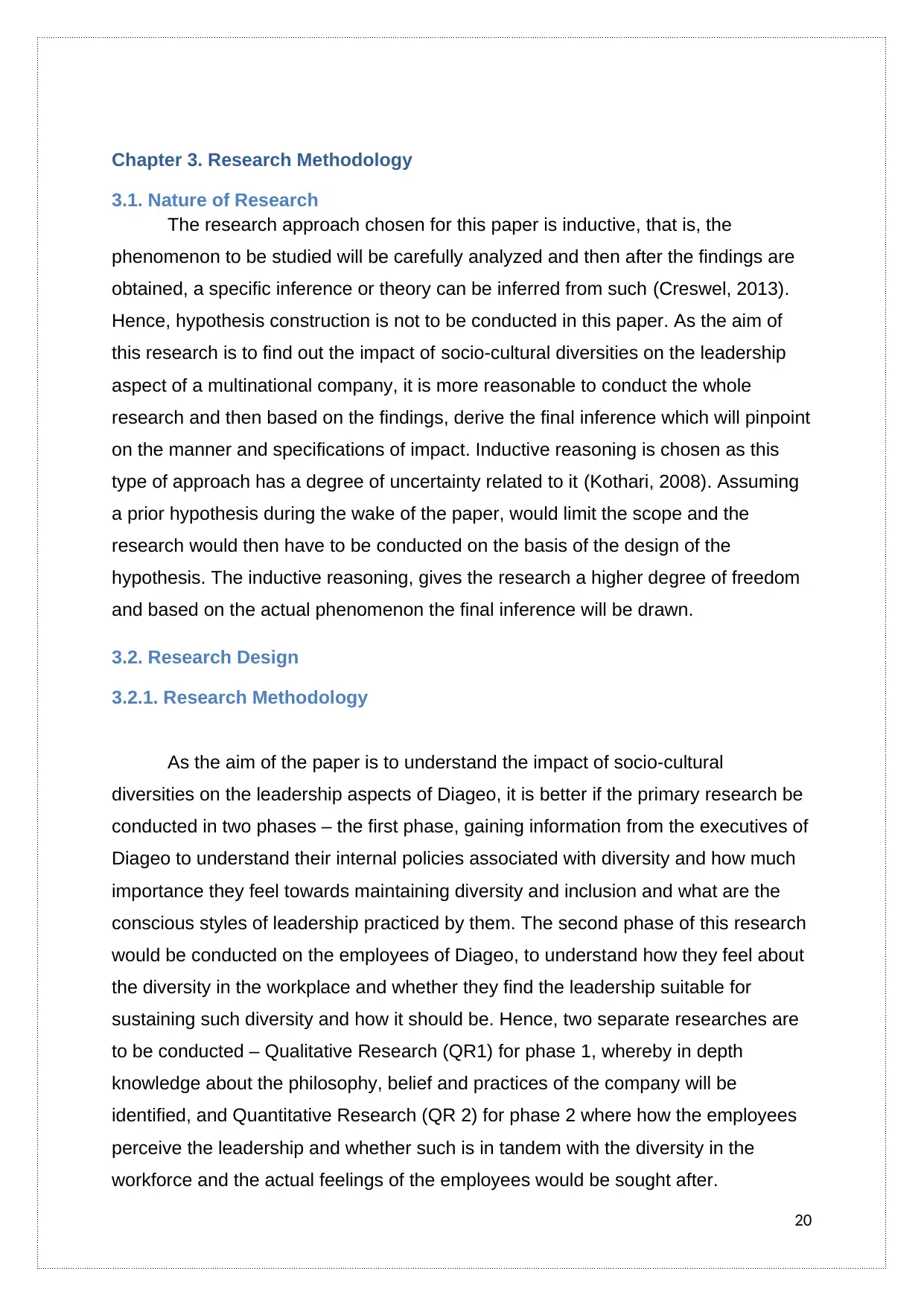
Chapter 3. Research Methodology
3.1. Nature of Research
The research approach chosen for this paper is inductive, that is, the
phenomenon to be studied will be carefully analyzed and then after the findings are
obtained, a specific inference or theory can be inferred from such (Creswel, 2013).
Hence, hypothesis construction is not to be conducted in this paper. As the aim of
this research is to find out the impact of socio-cultural diversities on the leadership
aspect of a multinational company, it is more reasonable to conduct the whole
research and then based on the findings, derive the final inference which will pinpoint
on the manner and specifications of impact. Inductive reasoning is chosen as this
type of approach has a degree of uncertainty related to it (Kothari, 2008). Assuming
a prior hypothesis during the wake of the paper, would limit the scope and the
research would then have to be conducted on the basis of the design of the
hypothesis. The inductive reasoning, gives the research a higher degree of freedom
and based on the actual phenomenon the final inference will be drawn.
3.2. Research Design
3.2.1. Research Methodology
As the aim of the paper is to understand the impact of socio-cultural
diversities on the leadership aspects of Diageo, it is better if the primary research be
conducted in two phases – the first phase, gaining information from the executives of
Diageo to understand their internal policies associated with diversity and how much
importance they feel towards maintaining diversity and inclusion and what are the
conscious styles of leadership practiced by them. The second phase of this research
would be conducted on the employees of Diageo, to understand how they feel about
the diversity in the workplace and whether they find the leadership suitable for
sustaining such diversity and how it should be. Hence, two separate researches are
to be conducted – Qualitative Research (QR1) for phase 1, whereby in depth
knowledge about the philosophy, belief and practices of the company will be
identified, and Quantitative Research (QR 2) for phase 2 where how the employees
perceive the leadership and whether such is in tandem with the diversity in the
workforce and the actual feelings of the employees would be sought after.
20
3.1. Nature of Research
The research approach chosen for this paper is inductive, that is, the
phenomenon to be studied will be carefully analyzed and then after the findings are
obtained, a specific inference or theory can be inferred from such (Creswel, 2013).
Hence, hypothesis construction is not to be conducted in this paper. As the aim of
this research is to find out the impact of socio-cultural diversities on the leadership
aspect of a multinational company, it is more reasonable to conduct the whole
research and then based on the findings, derive the final inference which will pinpoint
on the manner and specifications of impact. Inductive reasoning is chosen as this
type of approach has a degree of uncertainty related to it (Kothari, 2008). Assuming
a prior hypothesis during the wake of the paper, would limit the scope and the
research would then have to be conducted on the basis of the design of the
hypothesis. The inductive reasoning, gives the research a higher degree of freedom
and based on the actual phenomenon the final inference will be drawn.
3.2. Research Design
3.2.1. Research Methodology
As the aim of the paper is to understand the impact of socio-cultural
diversities on the leadership aspects of Diageo, it is better if the primary research be
conducted in two phases – the first phase, gaining information from the executives of
Diageo to understand their internal policies associated with diversity and how much
importance they feel towards maintaining diversity and inclusion and what are the
conscious styles of leadership practiced by them. The second phase of this research
would be conducted on the employees of Diageo, to understand how they feel about
the diversity in the workplace and whether they find the leadership suitable for
sustaining such diversity and how it should be. Hence, two separate researches are
to be conducted – Qualitative Research (QR1) for phase 1, whereby in depth
knowledge about the philosophy, belief and practices of the company will be
identified, and Quantitative Research (QR 2) for phase 2 where how the employees
perceive the leadership and whether such is in tandem with the diversity in the
workforce and the actual feelings of the employees would be sought after.
20
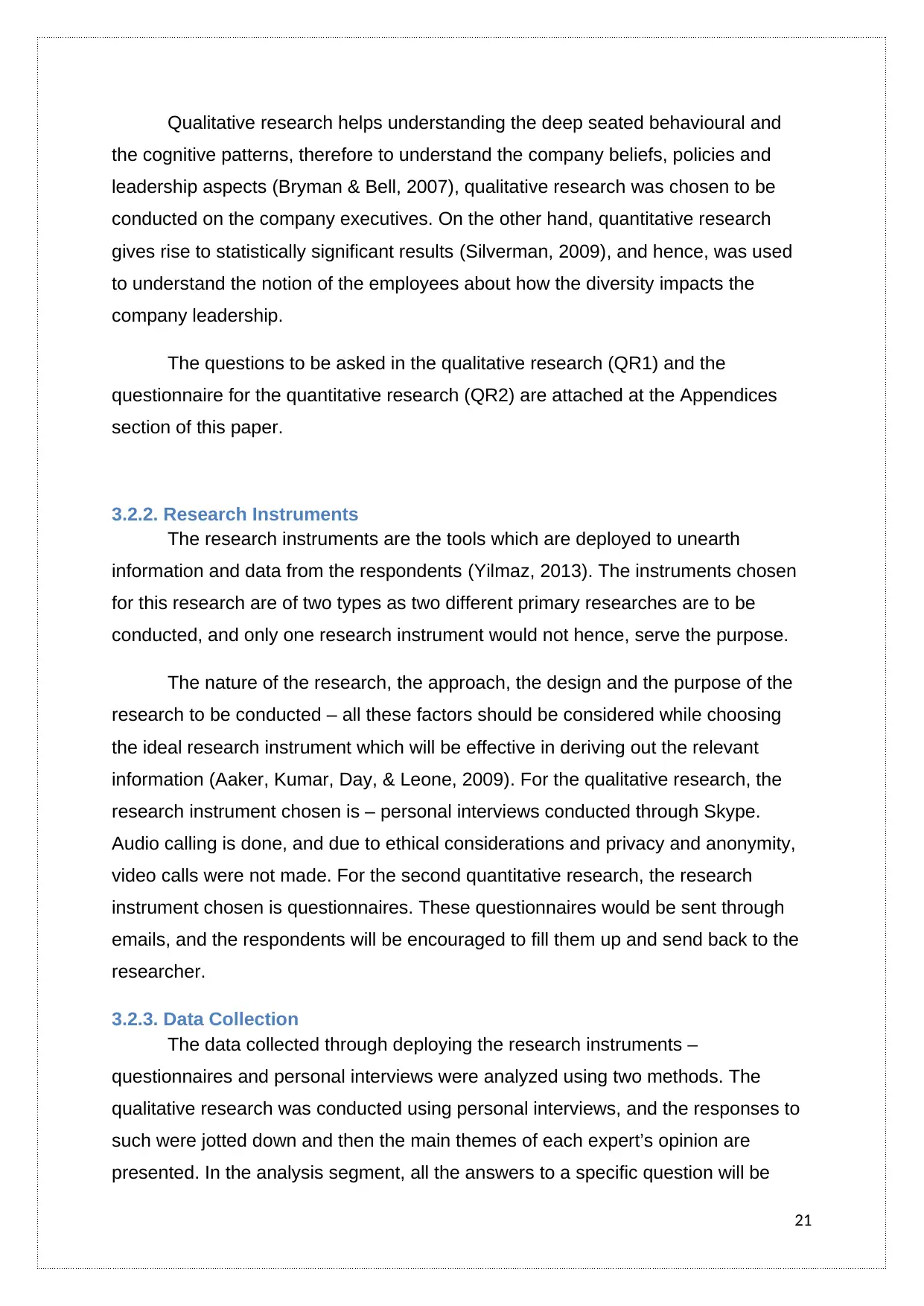
Qualitative research helps understanding the deep seated behavioural and
the cognitive patterns, therefore to understand the company beliefs, policies and
leadership aspects (Bryman & Bell, 2007), qualitative research was chosen to be
conducted on the company executives. On the other hand, quantitative research
gives rise to statistically significant results (Silverman, 2009), and hence, was used
to understand the notion of the employees about how the diversity impacts the
company leadership.
The questions to be asked in the qualitative research (QR1) and the
questionnaire for the quantitative research (QR2) are attached at the Appendices
section of this paper.
3.2.2. Research Instruments
The research instruments are the tools which are deployed to unearth
information and data from the respondents (Yilmaz, 2013). The instruments chosen
for this research are of two types as two different primary researches are to be
conducted, and only one research instrument would not hence, serve the purpose.
The nature of the research, the approach, the design and the purpose of the
research to be conducted – all these factors should be considered while choosing
the ideal research instrument which will be effective in deriving out the relevant
information (Aaker, Kumar, Day, & Leone, 2009). For the qualitative research, the
research instrument chosen is – personal interviews conducted through Skype.
Audio calling is done, and due to ethical considerations and privacy and anonymity,
video calls were not made. For the second quantitative research, the research
instrument chosen is questionnaires. These questionnaires would be sent through
emails, and the respondents will be encouraged to fill them up and send back to the
researcher.
3.2.3. Data Collection
The data collected through deploying the research instruments –
questionnaires and personal interviews were analyzed using two methods. The
qualitative research was conducted using personal interviews, and the responses to
such were jotted down and then the main themes of each expert’s opinion are
presented. In the analysis segment, all the answers to a specific question will be
21
the cognitive patterns, therefore to understand the company beliefs, policies and
leadership aspects (Bryman & Bell, 2007), qualitative research was chosen to be
conducted on the company executives. On the other hand, quantitative research
gives rise to statistically significant results (Silverman, 2009), and hence, was used
to understand the notion of the employees about how the diversity impacts the
company leadership.
The questions to be asked in the qualitative research (QR1) and the
questionnaire for the quantitative research (QR2) are attached at the Appendices
section of this paper.
3.2.2. Research Instruments
The research instruments are the tools which are deployed to unearth
information and data from the respondents (Yilmaz, 2013). The instruments chosen
for this research are of two types as two different primary researches are to be
conducted, and only one research instrument would not hence, serve the purpose.
The nature of the research, the approach, the design and the purpose of the
research to be conducted – all these factors should be considered while choosing
the ideal research instrument which will be effective in deriving out the relevant
information (Aaker, Kumar, Day, & Leone, 2009). For the qualitative research, the
research instrument chosen is – personal interviews conducted through Skype.
Audio calling is done, and due to ethical considerations and privacy and anonymity,
video calls were not made. For the second quantitative research, the research
instrument chosen is questionnaires. These questionnaires would be sent through
emails, and the respondents will be encouraged to fill them up and send back to the
researcher.
3.2.3. Data Collection
The data collected through deploying the research instruments –
questionnaires and personal interviews were analyzed using two methods. The
qualitative research was conducted using personal interviews, and the responses to
such were jotted down and then the main themes of each expert’s opinion are
presented. In the analysis segment, all the answers to a specific question will be
21
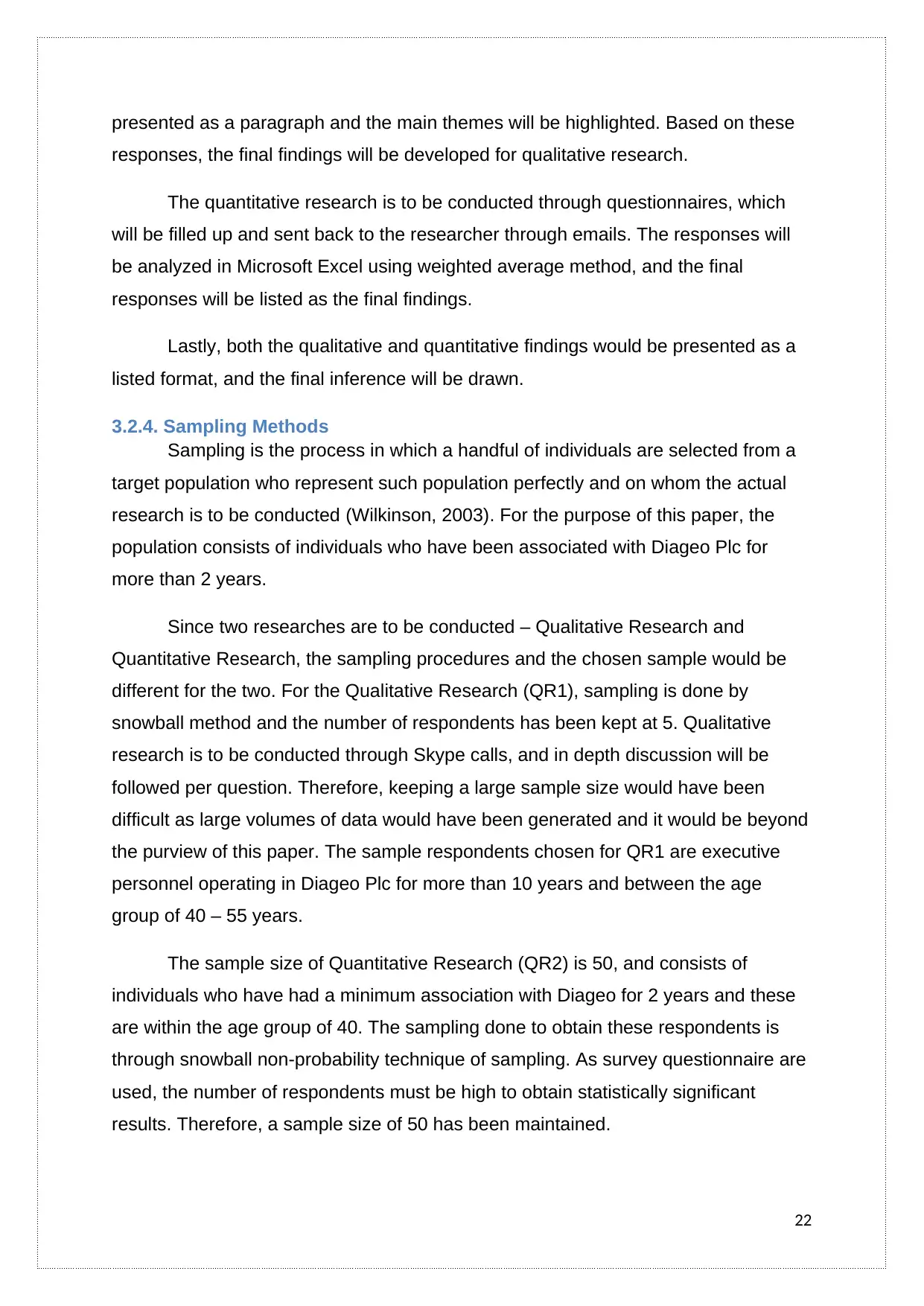
presented as a paragraph and the main themes will be highlighted. Based on these
responses, the final findings will be developed for qualitative research.
The quantitative research is to be conducted through questionnaires, which
will be filled up and sent back to the researcher through emails. The responses will
be analyzed in Microsoft Excel using weighted average method, and the final
responses will be listed as the final findings.
Lastly, both the qualitative and quantitative findings would be presented as a
listed format, and the final inference will be drawn.
3.2.4. Sampling Methods
Sampling is the process in which a handful of individuals are selected from a
target population who represent such population perfectly and on whom the actual
research is to be conducted (Wilkinson, 2003). For the purpose of this paper, the
population consists of individuals who have been associated with Diageo Plc for
more than 2 years.
Since two researches are to be conducted – Qualitative Research and
Quantitative Research, the sampling procedures and the chosen sample would be
different for the two. For the Qualitative Research (QR1), sampling is done by
snowball method and the number of respondents has been kept at 5. Qualitative
research is to be conducted through Skype calls, and in depth discussion will be
followed per question. Therefore, keeping a large sample size would have been
difficult as large volumes of data would have been generated and it would be beyond
the purview of this paper. The sample respondents chosen for QR1 are executive
personnel operating in Diageo Plc for more than 10 years and between the age
group of 40 – 55 years.
The sample size of Quantitative Research (QR2) is 50, and consists of
individuals who have had a minimum association with Diageo for 2 years and these
are within the age group of 40. The sampling done to obtain these respondents is
through snowball non-probability technique of sampling. As survey questionnaire are
used, the number of respondents must be high to obtain statistically significant
results. Therefore, a sample size of 50 has been maintained.
22
responses, the final findings will be developed for qualitative research.
The quantitative research is to be conducted through questionnaires, which
will be filled up and sent back to the researcher through emails. The responses will
be analyzed in Microsoft Excel using weighted average method, and the final
responses will be listed as the final findings.
Lastly, both the qualitative and quantitative findings would be presented as a
listed format, and the final inference will be drawn.
3.2.4. Sampling Methods
Sampling is the process in which a handful of individuals are selected from a
target population who represent such population perfectly and on whom the actual
research is to be conducted (Wilkinson, 2003). For the purpose of this paper, the
population consists of individuals who have been associated with Diageo Plc for
more than 2 years.
Since two researches are to be conducted – Qualitative Research and
Quantitative Research, the sampling procedures and the chosen sample would be
different for the two. For the Qualitative Research (QR1), sampling is done by
snowball method and the number of respondents has been kept at 5. Qualitative
research is to be conducted through Skype calls, and in depth discussion will be
followed per question. Therefore, keeping a large sample size would have been
difficult as large volumes of data would have been generated and it would be beyond
the purview of this paper. The sample respondents chosen for QR1 are executive
personnel operating in Diageo Plc for more than 10 years and between the age
group of 40 – 55 years.
The sample size of Quantitative Research (QR2) is 50, and consists of
individuals who have had a minimum association with Diageo for 2 years and these
are within the age group of 40. The sampling done to obtain these respondents is
through snowball non-probability technique of sampling. As survey questionnaire are
used, the number of respondents must be high to obtain statistically significant
results. Therefore, a sample size of 50 has been maintained.
22
Secure Best Marks with AI Grader
Need help grading? Try our AI Grader for instant feedback on your assignments.
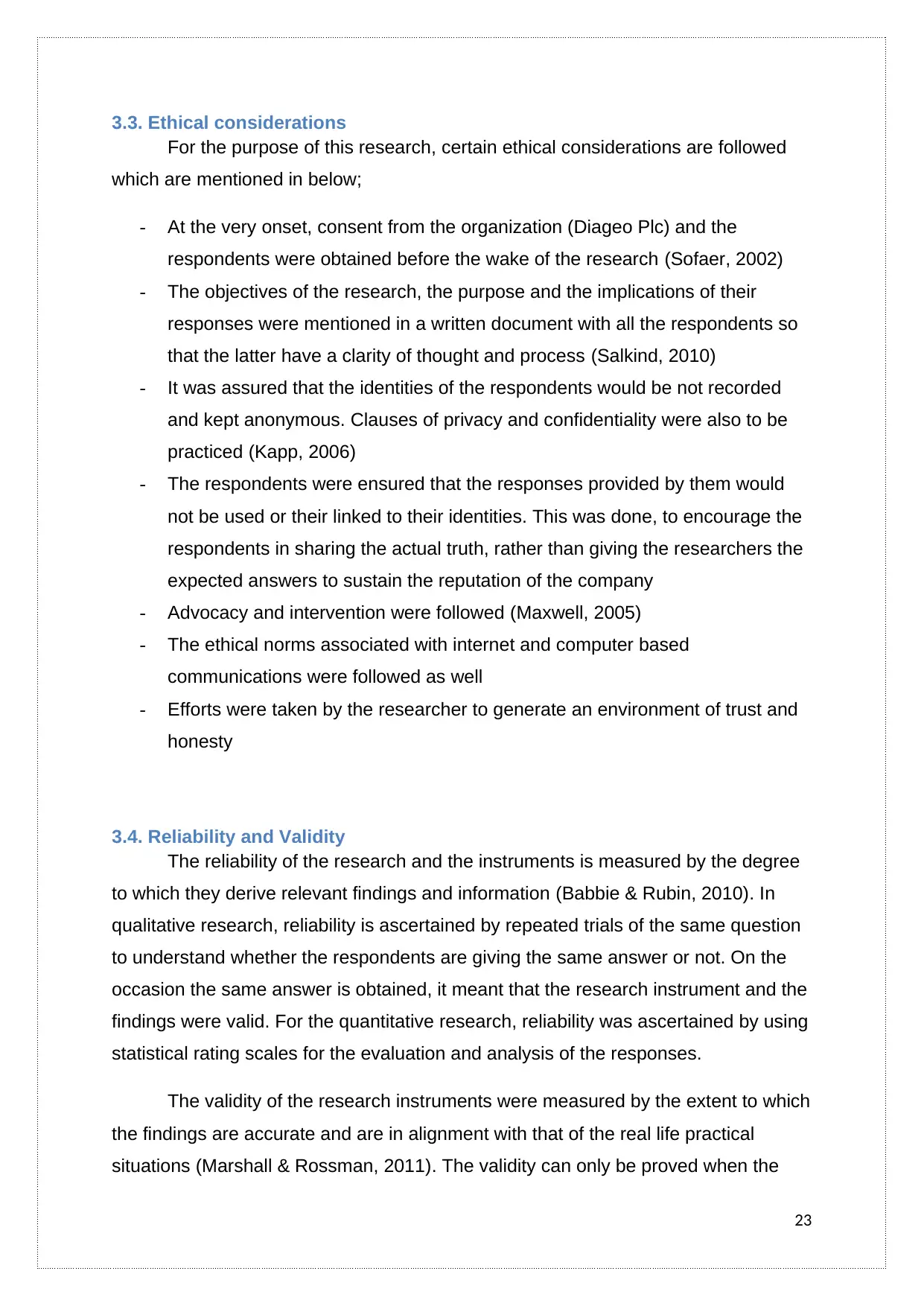
3.3. Ethical considerations
For the purpose of this research, certain ethical considerations are followed
which are mentioned in below;
- At the very onset, consent from the organization (Diageo Plc) and the
respondents were obtained before the wake of the research (Sofaer, 2002)
- The objectives of the research, the purpose and the implications of their
responses were mentioned in a written document with all the respondents so
that the latter have a clarity of thought and process (Salkind, 2010)
- It was assured that the identities of the respondents would be not recorded
and kept anonymous. Clauses of privacy and confidentiality were also to be
practiced (Kapp, 2006)
- The respondents were ensured that the responses provided by them would
not be used or their linked to their identities. This was done, to encourage the
respondents in sharing the actual truth, rather than giving the researchers the
expected answers to sustain the reputation of the company
- Advocacy and intervention were followed (Maxwell, 2005)
- The ethical norms associated with internet and computer based
communications were followed as well
- Efforts were taken by the researcher to generate an environment of trust and
honesty
3.4. Reliability and Validity
The reliability of the research and the instruments is measured by the degree
to which they derive relevant findings and information (Babbie & Rubin, 2010). In
qualitative research, reliability is ascertained by repeated trials of the same question
to understand whether the respondents are giving the same answer or not. On the
occasion the same answer is obtained, it meant that the research instrument and the
findings were valid. For the quantitative research, reliability was ascertained by using
statistical rating scales for the evaluation and analysis of the responses.
The validity of the research instruments were measured by the extent to which
the findings are accurate and are in alignment with that of the real life practical
situations (Marshall & Rossman, 2011). The validity can only be proved when the
23
For the purpose of this research, certain ethical considerations are followed
which are mentioned in below;
- At the very onset, consent from the organization (Diageo Plc) and the
respondents were obtained before the wake of the research (Sofaer, 2002)
- The objectives of the research, the purpose and the implications of their
responses were mentioned in a written document with all the respondents so
that the latter have a clarity of thought and process (Salkind, 2010)
- It was assured that the identities of the respondents would be not recorded
and kept anonymous. Clauses of privacy and confidentiality were also to be
practiced (Kapp, 2006)
- The respondents were ensured that the responses provided by them would
not be used or their linked to their identities. This was done, to encourage the
respondents in sharing the actual truth, rather than giving the researchers the
expected answers to sustain the reputation of the company
- Advocacy and intervention were followed (Maxwell, 2005)
- The ethical norms associated with internet and computer based
communications were followed as well
- Efforts were taken by the researcher to generate an environment of trust and
honesty
3.4. Reliability and Validity
The reliability of the research and the instruments is measured by the degree
to which they derive relevant findings and information (Babbie & Rubin, 2010). In
qualitative research, reliability is ascertained by repeated trials of the same question
to understand whether the respondents are giving the same answer or not. On the
occasion the same answer is obtained, it meant that the research instrument and the
findings were valid. For the quantitative research, reliability was ascertained by using
statistical rating scales for the evaluation and analysis of the responses.
The validity of the research instruments were measured by the extent to which
the findings are accurate and are in alignment with that of the real life practical
situations (Marshall & Rossman, 2011). The validity can only be proved when the
23
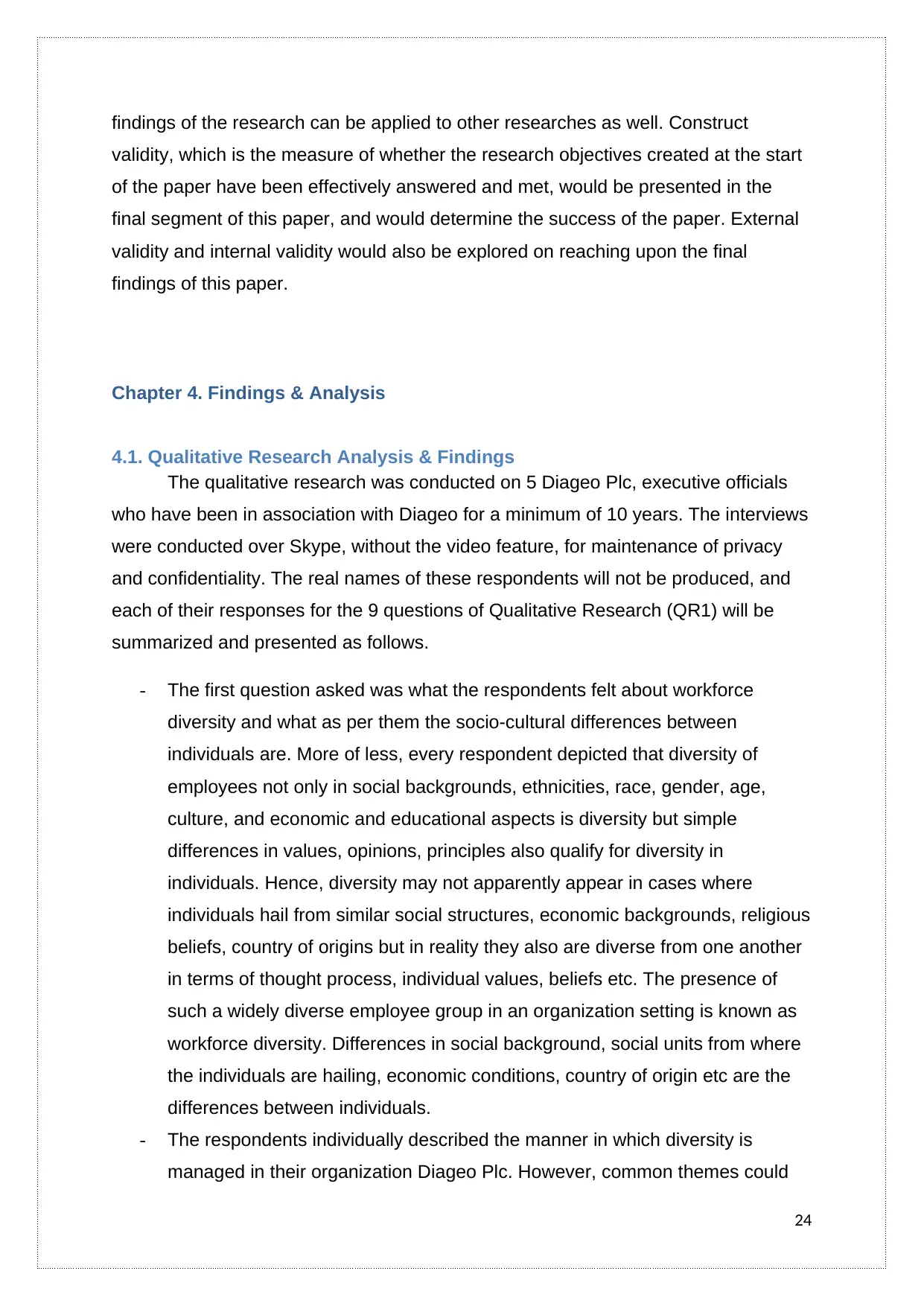
findings of the research can be applied to other researches as well. Construct
validity, which is the measure of whether the research objectives created at the start
of the paper have been effectively answered and met, would be presented in the
final segment of this paper, and would determine the success of the paper. External
validity and internal validity would also be explored on reaching upon the final
findings of this paper.
Chapter 4. Findings & Analysis
4.1. Qualitative Research Analysis & Findings
The qualitative research was conducted on 5 Diageo Plc, executive officials
who have been in association with Diageo for a minimum of 10 years. The interviews
were conducted over Skype, without the video feature, for maintenance of privacy
and confidentiality. The real names of these respondents will not be produced, and
each of their responses for the 9 questions of Qualitative Research (QR1) will be
summarized and presented as follows.
- The first question asked was what the respondents felt about workforce
diversity and what as per them the socio-cultural differences between
individuals are. More of less, every respondent depicted that diversity of
employees not only in social backgrounds, ethnicities, race, gender, age,
culture, and economic and educational aspects is diversity but simple
differences in values, opinions, principles also qualify for diversity in
individuals. Hence, diversity may not apparently appear in cases where
individuals hail from similar social structures, economic backgrounds, religious
beliefs, country of origins but in reality they also are diverse from one another
in terms of thought process, individual values, beliefs etc. The presence of
such a widely diverse employee group in an organization setting is known as
workforce diversity. Differences in social background, social units from where
the individuals are hailing, economic conditions, country of origin etc are the
differences between individuals.
- The respondents individually described the manner in which diversity is
managed in their organization Diageo Plc. However, common themes could
24
validity, which is the measure of whether the research objectives created at the start
of the paper have been effectively answered and met, would be presented in the
final segment of this paper, and would determine the success of the paper. External
validity and internal validity would also be explored on reaching upon the final
findings of this paper.
Chapter 4. Findings & Analysis
4.1. Qualitative Research Analysis & Findings
The qualitative research was conducted on 5 Diageo Plc, executive officials
who have been in association with Diageo for a minimum of 10 years. The interviews
were conducted over Skype, without the video feature, for maintenance of privacy
and confidentiality. The real names of these respondents will not be produced, and
each of their responses for the 9 questions of Qualitative Research (QR1) will be
summarized and presented as follows.
- The first question asked was what the respondents felt about workforce
diversity and what as per them the socio-cultural differences between
individuals are. More of less, every respondent depicted that diversity of
employees not only in social backgrounds, ethnicities, race, gender, age,
culture, and economic and educational aspects is diversity but simple
differences in values, opinions, principles also qualify for diversity in
individuals. Hence, diversity may not apparently appear in cases where
individuals hail from similar social structures, economic backgrounds, religious
beliefs, country of origins but in reality they also are diverse from one another
in terms of thought process, individual values, beliefs etc. The presence of
such a widely diverse employee group in an organization setting is known as
workforce diversity. Differences in social background, social units from where
the individuals are hailing, economic conditions, country of origin etc are the
differences between individuals.
- The respondents individually described the manner in which diversity is
managed in their organization Diageo Plc. However, common themes could
24
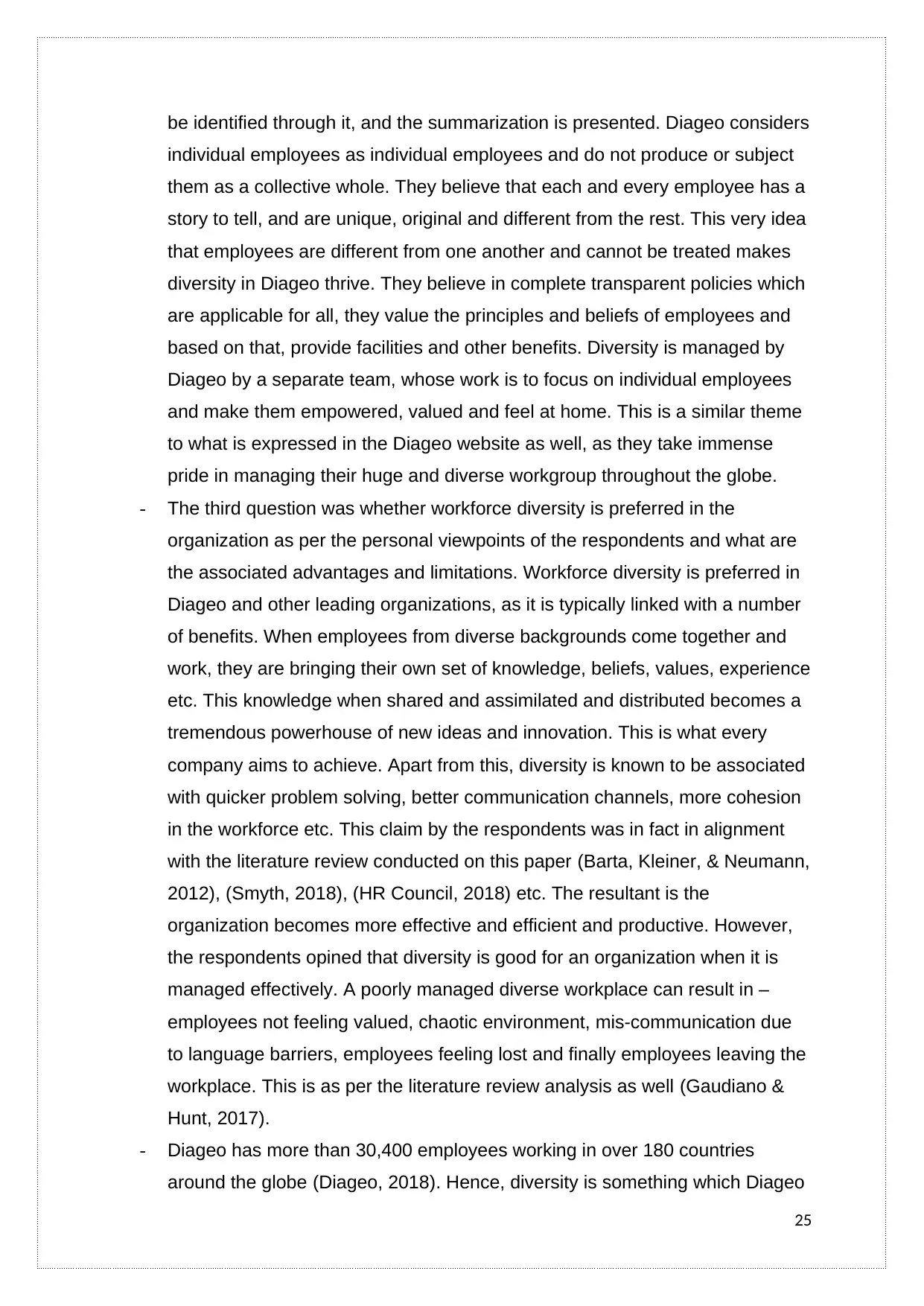
be identified through it, and the summarization is presented. Diageo considers
individual employees as individual employees and do not produce or subject
them as a collective whole. They believe that each and every employee has a
story to tell, and are unique, original and different from the rest. This very idea
that employees are different from one another and cannot be treated makes
diversity in Diageo thrive. They believe in complete transparent policies which
are applicable for all, they value the principles and beliefs of employees and
based on that, provide facilities and other benefits. Diversity is managed by
Diageo by a separate team, whose work is to focus on individual employees
and make them empowered, valued and feel at home. This is a similar theme
to what is expressed in the Diageo website as well, as they take immense
pride in managing their huge and diverse workgroup throughout the globe.
- The third question was whether workforce diversity is preferred in the
organization as per the personal viewpoints of the respondents and what are
the associated advantages and limitations. Workforce diversity is preferred in
Diageo and other leading organizations, as it is typically linked with a number
of benefits. When employees from diverse backgrounds come together and
work, they are bringing their own set of knowledge, beliefs, values, experience
etc. This knowledge when shared and assimilated and distributed becomes a
tremendous powerhouse of new ideas and innovation. This is what every
company aims to achieve. Apart from this, diversity is known to be associated
with quicker problem solving, better communication channels, more cohesion
in the workforce etc. This claim by the respondents was in fact in alignment
with the literature review conducted on this paper (Barta, Kleiner, & Neumann,
2012), (Smyth, 2018), (HR Council, 2018) etc. The resultant is the
organization becomes more effective and efficient and productive. However,
the respondents opined that diversity is good for an organization when it is
managed effectively. A poorly managed diverse workplace can result in –
employees not feeling valued, chaotic environment, mis-communication due
to language barriers, employees feeling lost and finally employees leaving the
workplace. This is as per the literature review analysis as well (Gaudiano &
Hunt, 2017).
- Diageo has more than 30,400 employees working in over 180 countries
around the globe (Diageo, 2018). Hence, diversity is something which Diageo
25
individual employees as individual employees and do not produce or subject
them as a collective whole. They believe that each and every employee has a
story to tell, and are unique, original and different from the rest. This very idea
that employees are different from one another and cannot be treated makes
diversity in Diageo thrive. They believe in complete transparent policies which
are applicable for all, they value the principles and beliefs of employees and
based on that, provide facilities and other benefits. Diversity is managed by
Diageo by a separate team, whose work is to focus on individual employees
and make them empowered, valued and feel at home. This is a similar theme
to what is expressed in the Diageo website as well, as they take immense
pride in managing their huge and diverse workgroup throughout the globe.
- The third question was whether workforce diversity is preferred in the
organization as per the personal viewpoints of the respondents and what are
the associated advantages and limitations. Workforce diversity is preferred in
Diageo and other leading organizations, as it is typically linked with a number
of benefits. When employees from diverse backgrounds come together and
work, they are bringing their own set of knowledge, beliefs, values, experience
etc. This knowledge when shared and assimilated and distributed becomes a
tremendous powerhouse of new ideas and innovation. This is what every
company aims to achieve. Apart from this, diversity is known to be associated
with quicker problem solving, better communication channels, more cohesion
in the workforce etc. This claim by the respondents was in fact in alignment
with the literature review conducted on this paper (Barta, Kleiner, & Neumann,
2012), (Smyth, 2018), (HR Council, 2018) etc. The resultant is the
organization becomes more effective and efficient and productive. However,
the respondents opined that diversity is good for an organization when it is
managed effectively. A poorly managed diverse workplace can result in –
employees not feeling valued, chaotic environment, mis-communication due
to language barriers, employees feeling lost and finally employees leaving the
workplace. This is as per the literature review analysis as well (Gaudiano &
Hunt, 2017).
- Diageo has more than 30,400 employees working in over 180 countries
around the globe (Diageo, 2018). Hence, diversity is something which Diageo
25
Paraphrase This Document
Need a fresh take? Get an instant paraphrase of this document with our AI Paraphraser
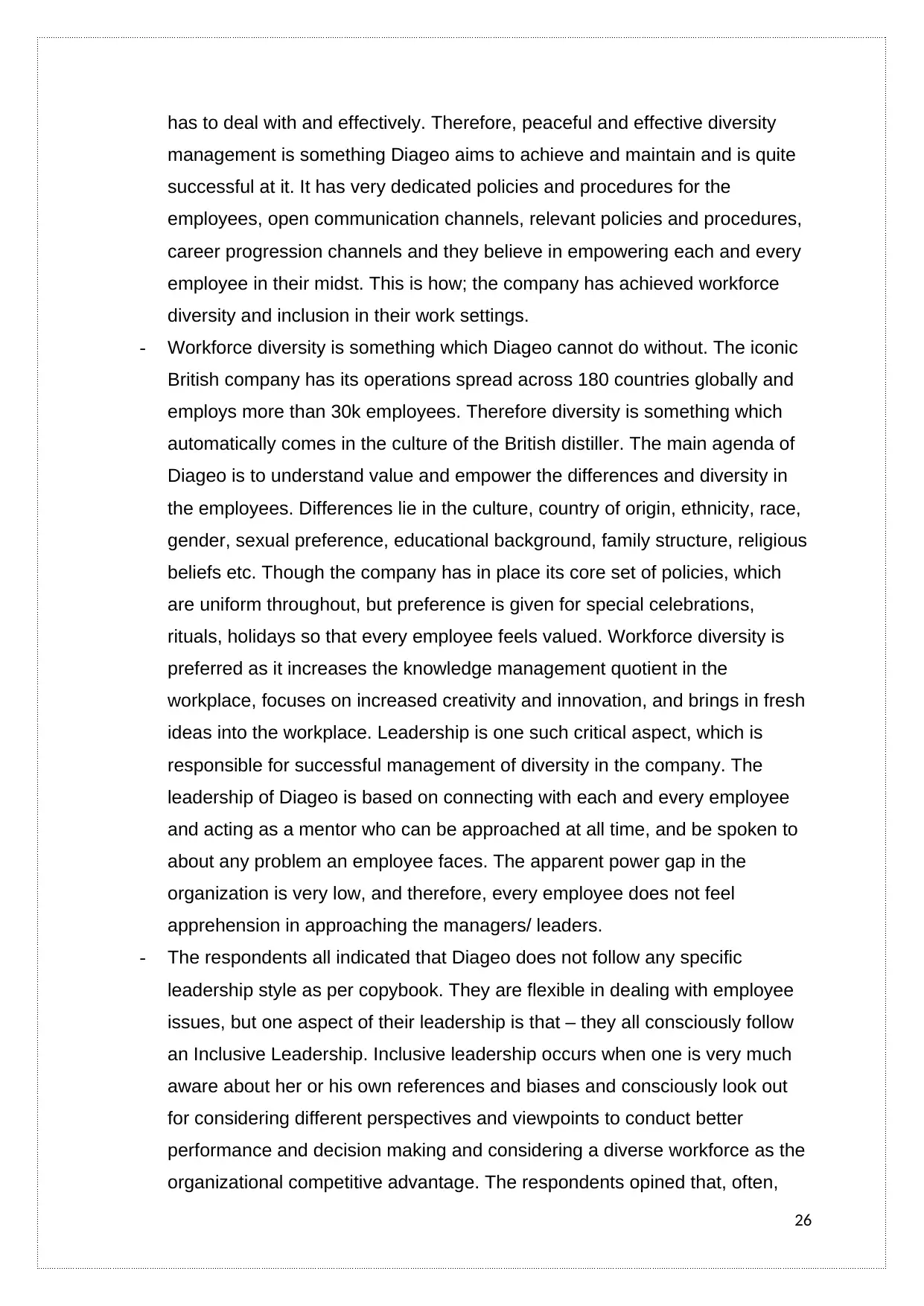
has to deal with and effectively. Therefore, peaceful and effective diversity
management is something Diageo aims to achieve and maintain and is quite
successful at it. It has very dedicated policies and procedures for the
employees, open communication channels, relevant policies and procedures,
career progression channels and they believe in empowering each and every
employee in their midst. This is how; the company has achieved workforce
diversity and inclusion in their work settings.
- Workforce diversity is something which Diageo cannot do without. The iconic
British company has its operations spread across 180 countries globally and
employs more than 30k employees. Therefore diversity is something which
automatically comes in the culture of the British distiller. The main agenda of
Diageo is to understand value and empower the differences and diversity in
the employees. Differences lie in the culture, country of origin, ethnicity, race,
gender, sexual preference, educational background, family structure, religious
beliefs etc. Though the company has in place its core set of policies, which
are uniform throughout, but preference is given for special celebrations,
rituals, holidays so that every employee feels valued. Workforce diversity is
preferred as it increases the knowledge management quotient in the
workplace, focuses on increased creativity and innovation, and brings in fresh
ideas into the workplace. Leadership is one such critical aspect, which is
responsible for successful management of diversity in the company. The
leadership of Diageo is based on connecting with each and every employee
and acting as a mentor who can be approached at all time, and be spoken to
about any problem an employee faces. The apparent power gap in the
organization is very low, and therefore, every employee does not feel
apprehension in approaching the managers/ leaders.
- The respondents all indicated that Diageo does not follow any specific
leadership style as per copybook. They are flexible in dealing with employee
issues, but one aspect of their leadership is that – they all consciously follow
an Inclusive Leadership. Inclusive leadership occurs when one is very much
aware about her or his own references and biases and consciously look out
for considering different perspectives and viewpoints to conduct better
performance and decision making and considering a diverse workforce as the
organizational competitive advantage. The respondents opined that, often,
26
management is something Diageo aims to achieve and maintain and is quite
successful at it. It has very dedicated policies and procedures for the
employees, open communication channels, relevant policies and procedures,
career progression channels and they believe in empowering each and every
employee in their midst. This is how; the company has achieved workforce
diversity and inclusion in their work settings.
- Workforce diversity is something which Diageo cannot do without. The iconic
British company has its operations spread across 180 countries globally and
employs more than 30k employees. Therefore diversity is something which
automatically comes in the culture of the British distiller. The main agenda of
Diageo is to understand value and empower the differences and diversity in
the employees. Differences lie in the culture, country of origin, ethnicity, race,
gender, sexual preference, educational background, family structure, religious
beliefs etc. Though the company has in place its core set of policies, which
are uniform throughout, but preference is given for special celebrations,
rituals, holidays so that every employee feels valued. Workforce diversity is
preferred as it increases the knowledge management quotient in the
workplace, focuses on increased creativity and innovation, and brings in fresh
ideas into the workplace. Leadership is one such critical aspect, which is
responsible for successful management of diversity in the company. The
leadership of Diageo is based on connecting with each and every employee
and acting as a mentor who can be approached at all time, and be spoken to
about any problem an employee faces. The apparent power gap in the
organization is very low, and therefore, every employee does not feel
apprehension in approaching the managers/ leaders.
- The respondents all indicated that Diageo does not follow any specific
leadership style as per copybook. They are flexible in dealing with employee
issues, but one aspect of their leadership is that – they all consciously follow
an Inclusive Leadership. Inclusive leadership occurs when one is very much
aware about her or his own references and biases and consciously look out
for considering different perspectives and viewpoints to conduct better
performance and decision making and considering a diverse workforce as the
organizational competitive advantage. The respondents opined that, often,
26
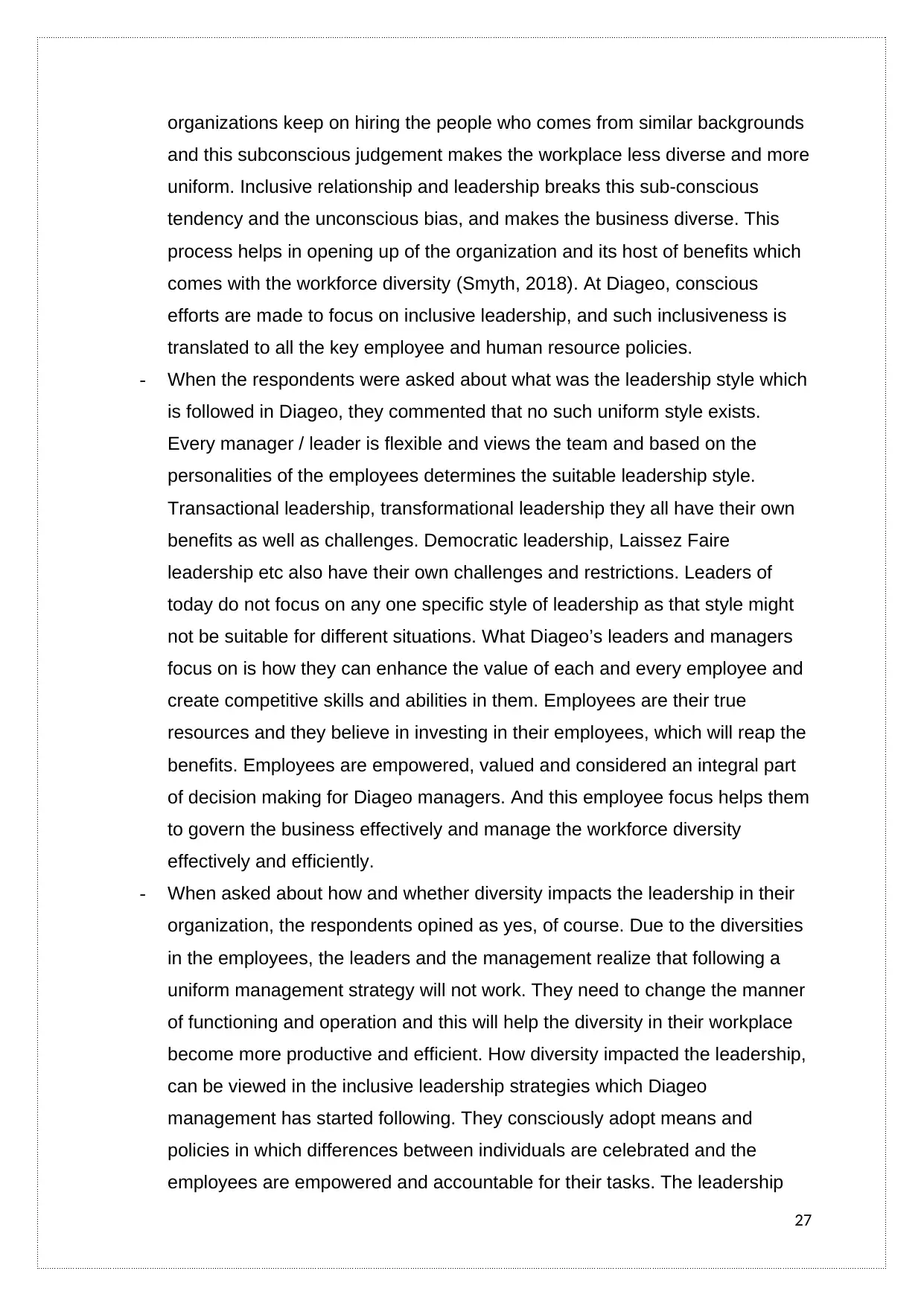
organizations keep on hiring the people who comes from similar backgrounds
and this subconscious judgement makes the workplace less diverse and more
uniform. Inclusive relationship and leadership breaks this sub-conscious
tendency and the unconscious bias, and makes the business diverse. This
process helps in opening up of the organization and its host of benefits which
comes with the workforce diversity (Smyth, 2018). At Diageo, conscious
efforts are made to focus on inclusive leadership, and such inclusiveness is
translated to all the key employee and human resource policies.
- When the respondents were asked about what was the leadership style which
is followed in Diageo, they commented that no such uniform style exists.
Every manager / leader is flexible and views the team and based on the
personalities of the employees determines the suitable leadership style.
Transactional leadership, transformational leadership they all have their own
benefits as well as challenges. Democratic leadership, Laissez Faire
leadership etc also have their own challenges and restrictions. Leaders of
today do not focus on any one specific style of leadership as that style might
not be suitable for different situations. What Diageo’s leaders and managers
focus on is how they can enhance the value of each and every employee and
create competitive skills and abilities in them. Employees are their true
resources and they believe in investing in their employees, which will reap the
benefits. Employees are empowered, valued and considered an integral part
of decision making for Diageo managers. And this employee focus helps them
to govern the business effectively and manage the workforce diversity
effectively and efficiently.
- When asked about how and whether diversity impacts the leadership in their
organization, the respondents opined as yes, of course. Due to the diversities
in the employees, the leaders and the management realize that following a
uniform management strategy will not work. They need to change the manner
of functioning and operation and this will help the diversity in their workplace
become more productive and efficient. How diversity impacted the leadership,
can be viewed in the inclusive leadership strategies which Diageo
management has started following. They consciously adopt means and
policies in which differences between individuals are celebrated and the
employees are empowered and accountable for their tasks. The leadership
27
and this subconscious judgement makes the workplace less diverse and more
uniform. Inclusive relationship and leadership breaks this sub-conscious
tendency and the unconscious bias, and makes the business diverse. This
process helps in opening up of the organization and its host of benefits which
comes with the workforce diversity (Smyth, 2018). At Diageo, conscious
efforts are made to focus on inclusive leadership, and such inclusiveness is
translated to all the key employee and human resource policies.
- When the respondents were asked about what was the leadership style which
is followed in Diageo, they commented that no such uniform style exists.
Every manager / leader is flexible and views the team and based on the
personalities of the employees determines the suitable leadership style.
Transactional leadership, transformational leadership they all have their own
benefits as well as challenges. Democratic leadership, Laissez Faire
leadership etc also have their own challenges and restrictions. Leaders of
today do not focus on any one specific style of leadership as that style might
not be suitable for different situations. What Diageo’s leaders and managers
focus on is how they can enhance the value of each and every employee and
create competitive skills and abilities in them. Employees are their true
resources and they believe in investing in their employees, which will reap the
benefits. Employees are empowered, valued and considered an integral part
of decision making for Diageo managers. And this employee focus helps them
to govern the business effectively and manage the workforce diversity
effectively and efficiently.
- When asked about how and whether diversity impacts the leadership in their
organization, the respondents opined as yes, of course. Due to the diversities
in the employees, the leaders and the management realize that following a
uniform management strategy will not work. They need to change the manner
of functioning and operation and this will help the diversity in their workplace
become more productive and efficient. How diversity impacted the leadership,
can be viewed in the inclusive leadership strategies which Diageo
management has started following. They consciously adopt means and
policies in which differences between individuals are celebrated and the
employees are empowered and accountable for their tasks. The leadership
27
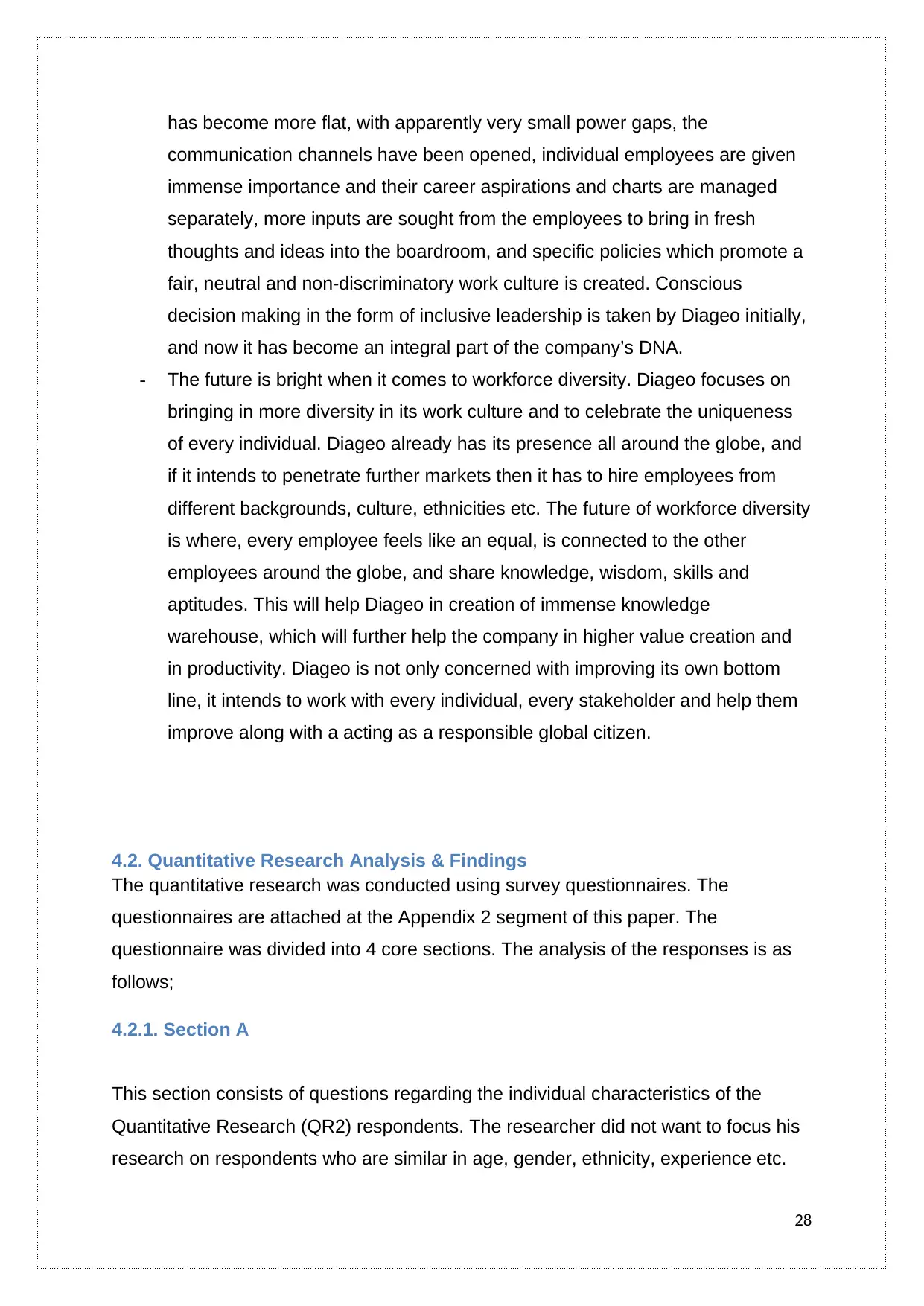
has become more flat, with apparently very small power gaps, the
communication channels have been opened, individual employees are given
immense importance and their career aspirations and charts are managed
separately, more inputs are sought from the employees to bring in fresh
thoughts and ideas into the boardroom, and specific policies which promote a
fair, neutral and non-discriminatory work culture is created. Conscious
decision making in the form of inclusive leadership is taken by Diageo initially,
and now it has become an integral part of the company’s DNA.
- The future is bright when it comes to workforce diversity. Diageo focuses on
bringing in more diversity in its work culture and to celebrate the uniqueness
of every individual. Diageo already has its presence all around the globe, and
if it intends to penetrate further markets then it has to hire employees from
different backgrounds, culture, ethnicities etc. The future of workforce diversity
is where, every employee feels like an equal, is connected to the other
employees around the globe, and share knowledge, wisdom, skills and
aptitudes. This will help Diageo in creation of immense knowledge
warehouse, which will further help the company in higher value creation and
in productivity. Diageo is not only concerned with improving its own bottom
line, it intends to work with every individual, every stakeholder and help them
improve along with a acting as a responsible global citizen.
4.2. Quantitative Research Analysis & Findings
The quantitative research was conducted using survey questionnaires. The
questionnaires are attached at the Appendix 2 segment of this paper. The
questionnaire was divided into 4 core sections. The analysis of the responses is as
follows;
4.2.1. Section A
This section consists of questions regarding the individual characteristics of the
Quantitative Research (QR2) respondents. The researcher did not want to focus his
research on respondents who are similar in age, gender, ethnicity, experience etc.
28
communication channels have been opened, individual employees are given
immense importance and their career aspirations and charts are managed
separately, more inputs are sought from the employees to bring in fresh
thoughts and ideas into the boardroom, and specific policies which promote a
fair, neutral and non-discriminatory work culture is created. Conscious
decision making in the form of inclusive leadership is taken by Diageo initially,
and now it has become an integral part of the company’s DNA.
- The future is bright when it comes to workforce diversity. Diageo focuses on
bringing in more diversity in its work culture and to celebrate the uniqueness
of every individual. Diageo already has its presence all around the globe, and
if it intends to penetrate further markets then it has to hire employees from
different backgrounds, culture, ethnicities etc. The future of workforce diversity
is where, every employee feels like an equal, is connected to the other
employees around the globe, and share knowledge, wisdom, skills and
aptitudes. This will help Diageo in creation of immense knowledge
warehouse, which will further help the company in higher value creation and
in productivity. Diageo is not only concerned with improving its own bottom
line, it intends to work with every individual, every stakeholder and help them
improve along with a acting as a responsible global citizen.
4.2. Quantitative Research Analysis & Findings
The quantitative research was conducted using survey questionnaires. The
questionnaires are attached at the Appendix 2 segment of this paper. The
questionnaire was divided into 4 core sections. The analysis of the responses is as
follows;
4.2.1. Section A
This section consists of questions regarding the individual characteristics of the
Quantitative Research (QR2) respondents. The researcher did not want to focus his
research on respondents who are similar in age, gender, ethnicity, experience etc.
28
Secure Best Marks with AI Grader
Need help grading? Try our AI Grader for instant feedback on your assignments.

Hence, the first segment of this questionnaire was to understand about the
specifications of these respondents to ensure that some diversity is achieved.
Otherwise the responses available from them will not be neutral and biased.
56%34%
10%
Gender Distribution of the QR2 Respondents
Male Female No Comments
Figure 1 - Gender Distribution of the QR2 Respondents
Out of the 50 respondents, 56% were male and 34% were female with the
rest respondents did not choose any gender. This gender division was suitable for
conducting this research paper.
38%
56%
6%
Age Distribution of the QR2 Respondents
26 to 30 years 30 to 35 years 36 to 40 years 40 years and abive
Figure 2 - Age Distribution of the QR2 Respondents
29
specifications of these respondents to ensure that some diversity is achieved.
Otherwise the responses available from them will not be neutral and biased.
56%34%
10%
Gender Distribution of the QR2 Respondents
Male Female No Comments
Figure 1 - Gender Distribution of the QR2 Respondents
Out of the 50 respondents, 56% were male and 34% were female with the
rest respondents did not choose any gender. This gender division was suitable for
conducting this research paper.
38%
56%
6%
Age Distribution of the QR2 Respondents
26 to 30 years 30 to 35 years 36 to 40 years 40 years and abive
Figure 2 - Age Distribution of the QR2 Respondents
29
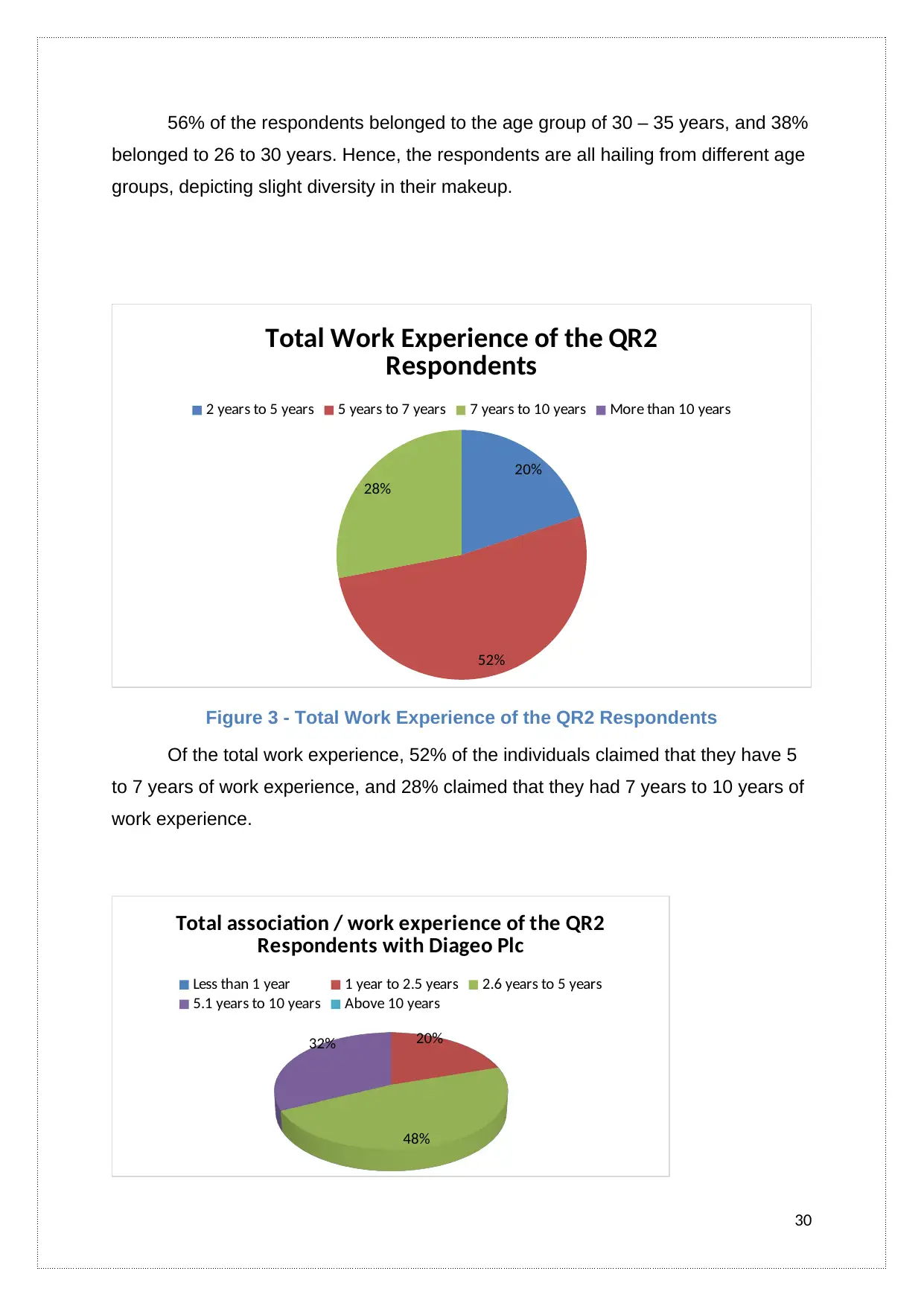
56% of the respondents belonged to the age group of 30 – 35 years, and 38%
belonged to 26 to 30 years. Hence, the respondents are all hailing from different age
groups, depicting slight diversity in their makeup.
20%
52%
28%
Total Work Experience of the QR2
Respondents
2 years to 5 years 5 years to 7 years 7 years to 10 years More than 10 years
Figure 3 - Total Work Experience of the QR2 Respondents
Of the total work experience, 52% of the individuals claimed that they have 5
to 7 years of work experience, and 28% claimed that they had 7 years to 10 years of
work experience.
20%
48%
32%
Total association / work experience of the QR2
Respondents with Diageo Plc
Less than 1 year 1 year to 2.5 years 2.6 years to 5 years
5.1 years to 10 years Above 10 years
30
belonged to 26 to 30 years. Hence, the respondents are all hailing from different age
groups, depicting slight diversity in their makeup.
20%
52%
28%
Total Work Experience of the QR2
Respondents
2 years to 5 years 5 years to 7 years 7 years to 10 years More than 10 years
Figure 3 - Total Work Experience of the QR2 Respondents
Of the total work experience, 52% of the individuals claimed that they have 5
to 7 years of work experience, and 28% claimed that they had 7 years to 10 years of
work experience.
20%
48%
32%
Total association / work experience of the QR2
Respondents with Diageo Plc
Less than 1 year 1 year to 2.5 years 2.6 years to 5 years
5.1 years to 10 years Above 10 years
30
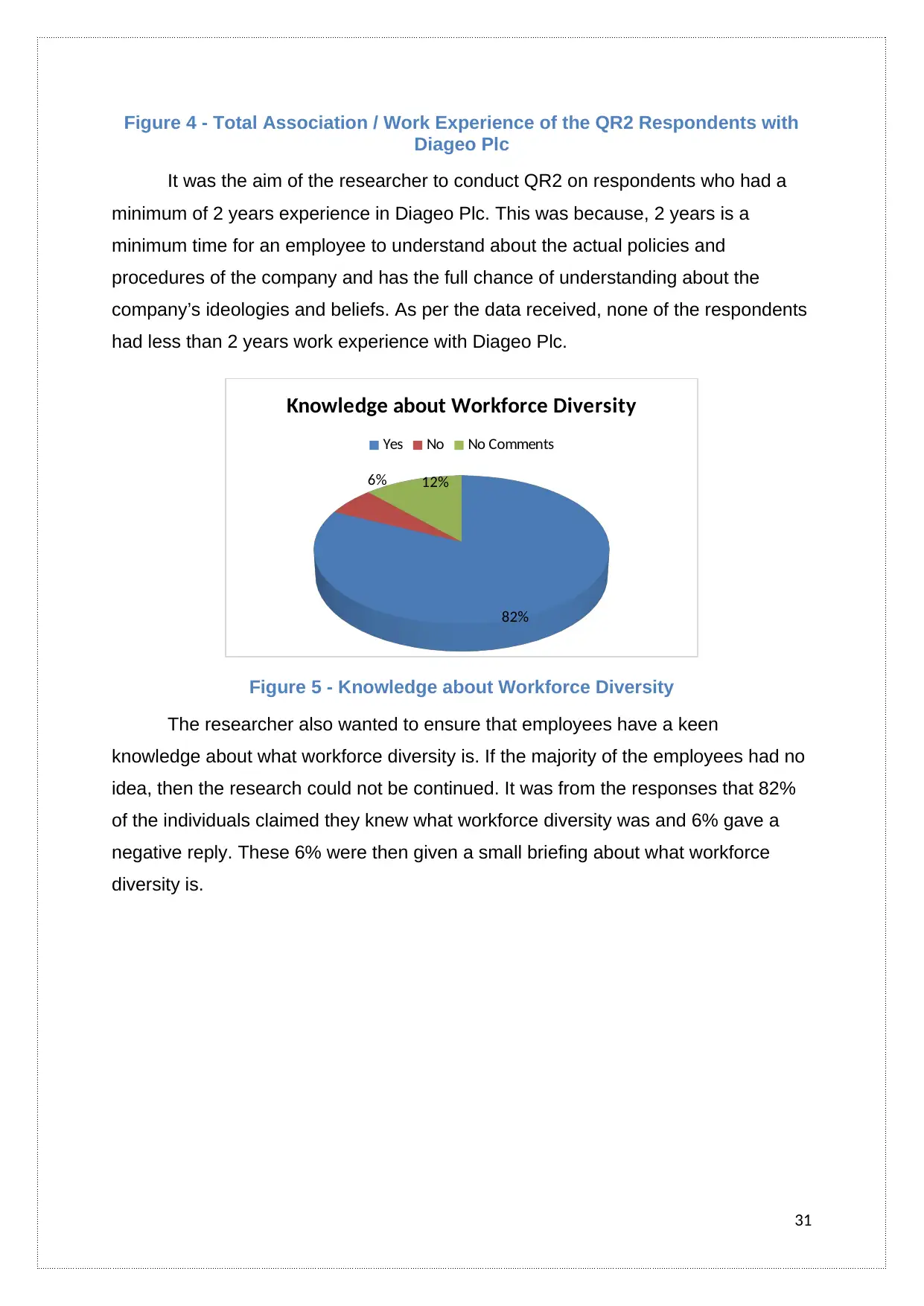
Figure 4 - Total Association / Work Experience of the QR2 Respondents with
Diageo Plc
It was the aim of the researcher to conduct QR2 on respondents who had a
minimum of 2 years experience in Diageo Plc. This was because, 2 years is a
minimum time for an employee to understand about the actual policies and
procedures of the company and has the full chance of understanding about the
company’s ideologies and beliefs. As per the data received, none of the respondents
had less than 2 years work experience with Diageo Plc.
82%
6% 12%
Knowledge about Workforce Diversity
Yes No No Comments
Figure 5 - Knowledge about Workforce Diversity
The researcher also wanted to ensure that employees have a keen
knowledge about what workforce diversity is. If the majority of the employees had no
idea, then the research could not be continued. It was from the responses that 82%
of the individuals claimed they knew what workforce diversity was and 6% gave a
negative reply. These 6% were then given a small briefing about what workforce
diversity is.
31
Diageo Plc
It was the aim of the researcher to conduct QR2 on respondents who had a
minimum of 2 years experience in Diageo Plc. This was because, 2 years is a
minimum time for an employee to understand about the actual policies and
procedures of the company and has the full chance of understanding about the
company’s ideologies and beliefs. As per the data received, none of the respondents
had less than 2 years work experience with Diageo Plc.
82%
6% 12%
Knowledge about Workforce Diversity
Yes No No Comments
Figure 5 - Knowledge about Workforce Diversity
The researcher also wanted to ensure that employees have a keen
knowledge about what workforce diversity is. If the majority of the employees had no
idea, then the research could not be continued. It was from the responses that 82%
of the individuals claimed they knew what workforce diversity was and 6% gave a
negative reply. These 6% were then given a small briefing about what workforce
diversity is.
31
Paraphrase This Document
Need a fresh take? Get an instant paraphrase of this document with our AI Paraphraser
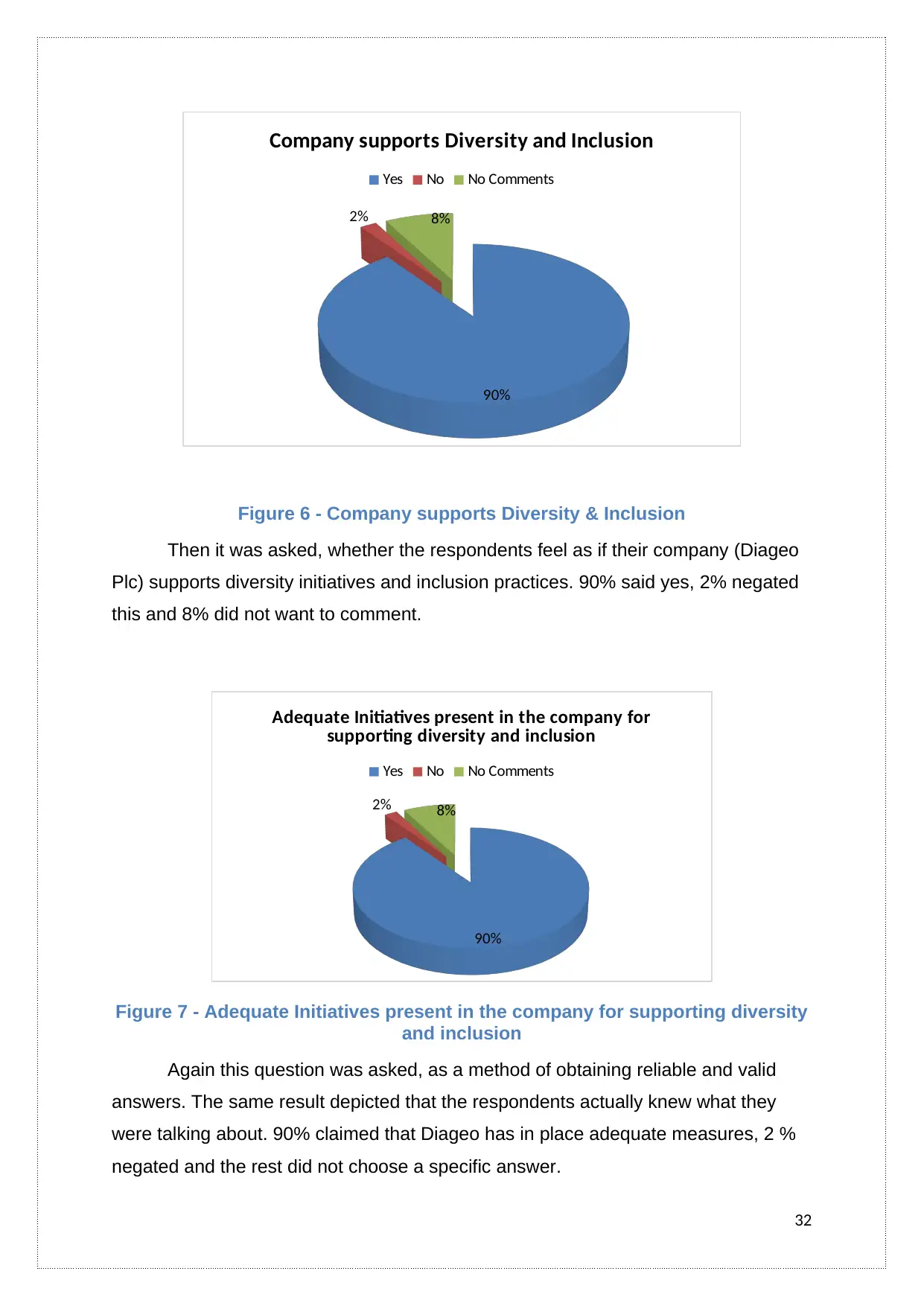
90%
2% 8%
Company supports Diversity and Inclusion
Yes No No Comments
Figure 6 - Company supports Diversity & Inclusion
Then it was asked, whether the respondents feel as if their company (Diageo
Plc) supports diversity initiatives and inclusion practices. 90% said yes, 2% negated
this and 8% did not want to comment.
90%
2% 8%
Adequate Initiatives present in the company for
supporting diversity and inclusion
Yes No No Comments
Figure 7 - Adequate Initiatives present in the company for supporting diversity
and inclusion
Again this question was asked, as a method of obtaining reliable and valid
answers. The same result depicted that the respondents actually knew what they
were talking about. 90% claimed that Diageo has in place adequate measures, 2 %
negated and the rest did not choose a specific answer.
32
2% 8%
Company supports Diversity and Inclusion
Yes No No Comments
Figure 6 - Company supports Diversity & Inclusion
Then it was asked, whether the respondents feel as if their company (Diageo
Plc) supports diversity initiatives and inclusion practices. 90% said yes, 2% negated
this and 8% did not want to comment.
90%
2% 8%
Adequate Initiatives present in the company for
supporting diversity and inclusion
Yes No No Comments
Figure 7 - Adequate Initiatives present in the company for supporting diversity
and inclusion
Again this question was asked, as a method of obtaining reliable and valid
answers. The same result depicted that the respondents actually knew what they
were talking about. 90% claimed that Diageo has in place adequate measures, 2 %
negated and the rest did not choose a specific answer.
32
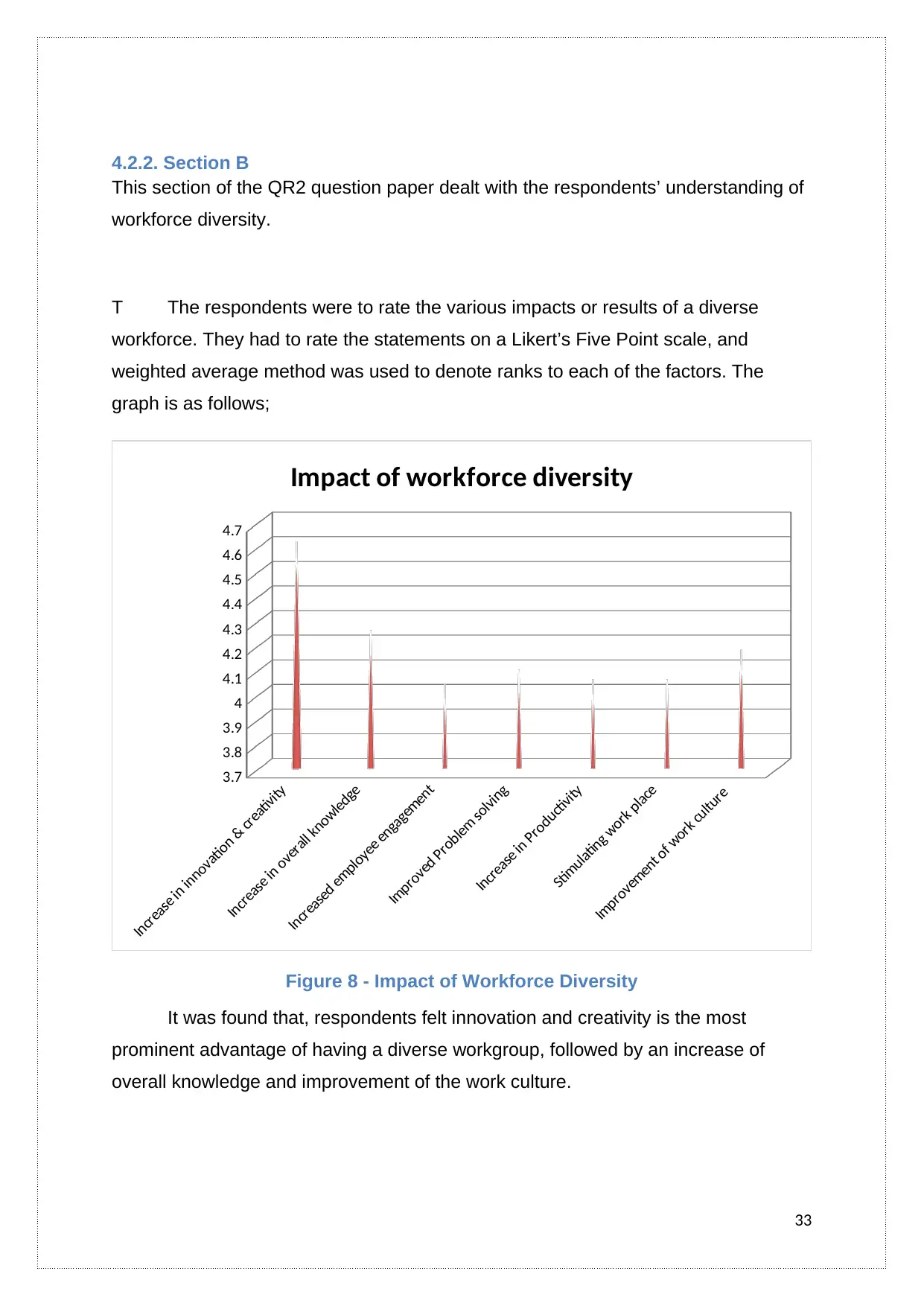
4.2.2. Section B
This section of the QR2 question paper dealt with the respondents’ understanding of
workforce diversity.
T The respondents were to rate the various impacts or results of a diverse
workforce. They had to rate the statements on a Likert’s Five Point scale, and
weighted average method was used to denote ranks to each of the factors. The
graph is as follows;
Increase in innovation & creativity
Increase in overall knowledge
Increased employee engagement
Improved Problem solving
Increase in Productivity
Stimulating work place
Improvement of work culture
3.7
3.8
3.9
4
4.1
4.2
4.3
4.4
4.5
4.6
4.7
Impact of workforce diversity
Figure 8 - Impact of Workforce Diversity
It was found that, respondents felt innovation and creativity is the most
prominent advantage of having a diverse workgroup, followed by an increase of
overall knowledge and improvement of the work culture.
33
This section of the QR2 question paper dealt with the respondents’ understanding of
workforce diversity.
T The respondents were to rate the various impacts or results of a diverse
workforce. They had to rate the statements on a Likert’s Five Point scale, and
weighted average method was used to denote ranks to each of the factors. The
graph is as follows;
Increase in innovation & creativity
Increase in overall knowledge
Increased employee engagement
Improved Problem solving
Increase in Productivity
Stimulating work place
Improvement of work culture
3.7
3.8
3.9
4
4.1
4.2
4.3
4.4
4.5
4.6
4.7
Impact of workforce diversity
Figure 8 - Impact of Workforce Diversity
It was found that, respondents felt innovation and creativity is the most
prominent advantage of having a diverse workgroup, followed by an increase of
overall knowledge and improvement of the work culture.
33
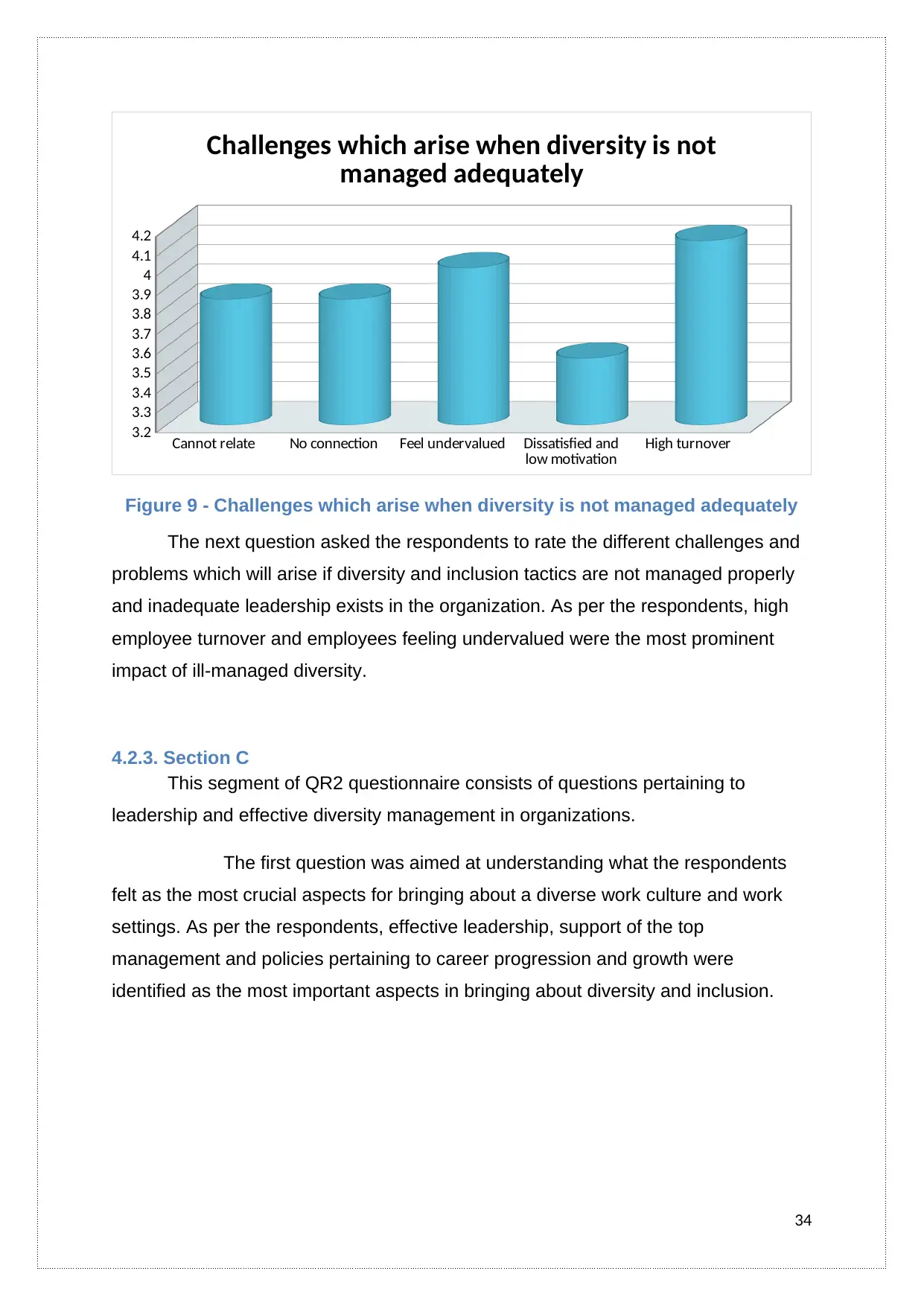
Cannot relate No connection Feel undervalued Dissatisfied and
low motivation High turnover
3.2
3.3
3.4
3.5
3.6
3.7
3.8
3.9
4
4.1
4.2
Challenges which arise when diversity is not
managed adequately
Figure 9 - Challenges which arise when diversity is not managed adequately
The next question asked the respondents to rate the different challenges and
problems which will arise if diversity and inclusion tactics are not managed properly
and inadequate leadership exists in the organization. As per the respondents, high
employee turnover and employees feeling undervalued were the most prominent
impact of ill-managed diversity.
4.2.3. Section C
This segment of QR2 questionnaire consists of questions pertaining to
leadership and effective diversity management in organizations.
The first question was aimed at understanding what the respondents
felt as the most crucial aspects for bringing about a diverse work culture and work
settings. As per the respondents, effective leadership, support of the top
management and policies pertaining to career progression and growth were
identified as the most important aspects in bringing about diversity and inclusion.
34
low motivation High turnover
3.2
3.3
3.4
3.5
3.6
3.7
3.8
3.9
4
4.1
4.2
Challenges which arise when diversity is not
managed adequately
Figure 9 - Challenges which arise when diversity is not managed adequately
The next question asked the respondents to rate the different challenges and
problems which will arise if diversity and inclusion tactics are not managed properly
and inadequate leadership exists in the organization. As per the respondents, high
employee turnover and employees feeling undervalued were the most prominent
impact of ill-managed diversity.
4.2.3. Section C
This segment of QR2 questionnaire consists of questions pertaining to
leadership and effective diversity management in organizations.
The first question was aimed at understanding what the respondents
felt as the most crucial aspects for bringing about a diverse work culture and work
settings. As per the respondents, effective leadership, support of the top
management and policies pertaining to career progression and growth were
identified as the most important aspects in bringing about diversity and inclusion.
34
Secure Best Marks with AI Grader
Need help grading? Try our AI Grader for instant feedback on your assignments.

Support from the
top management Effective
Leadership Transparent and
equal employee
policies
Effective
recruitment &
selection
Career
management &
growth scope
3.5
3.6
3.7
3.8
3.9
4
4.1
4.2
4.3
4.4
4.5
Important aspects of organization to bring
about diversity and inclusion
Figure 10 -Important aspects of organization to bring about diversity and
inclusion
When asked whether their company has adequate policies supporting
Diversity in its work settings, 94% said yes, and 6 % did not want to communicate
any specific reply.
94%
6%
Diageo Plc has adequate diversity
policies
Yes No No Comments
Figure 11 - Diageo Plc has adequate diversity policies
35
top management Effective
Leadership Transparent and
equal employee
policies
Effective
recruitment &
selection
Career
management &
growth scope
3.5
3.6
3.7
3.8
3.9
4
4.1
4.2
4.3
4.4
4.5
Important aspects of organization to bring
about diversity and inclusion
Figure 10 -Important aspects of organization to bring about diversity and
inclusion
When asked whether their company has adequate policies supporting
Diversity in its work settings, 94% said yes, and 6 % did not want to communicate
any specific reply.
94%
6%
Diageo Plc has adequate diversity
policies
Yes No No Comments
Figure 11 - Diageo Plc has adequate diversity policies
35
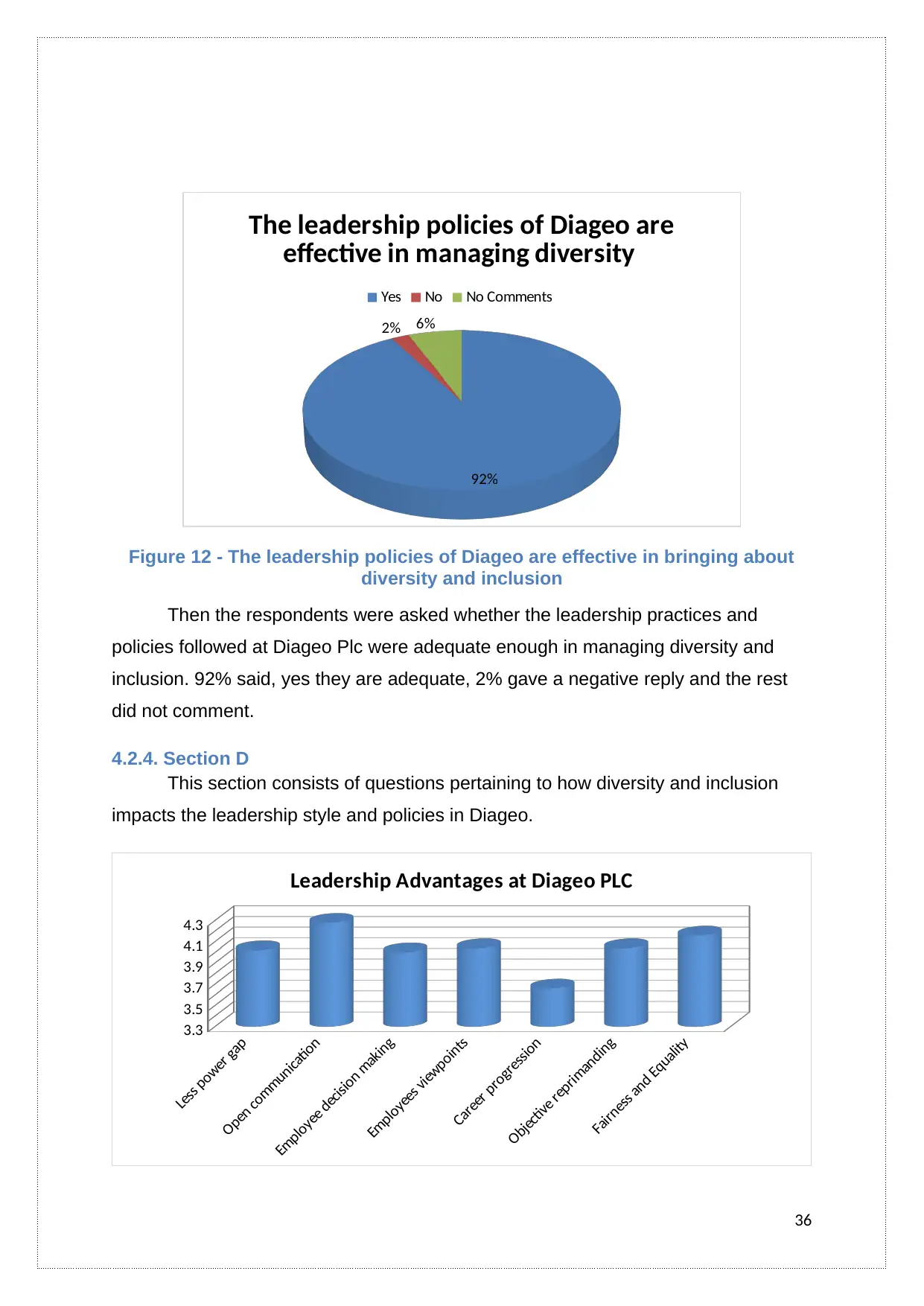
92%
2% 6%
The leadership policies of Diageo are
effective in managing diversity
Yes No No Comments
Figure 12 - The leadership policies of Diageo are effective in bringing about
diversity and inclusion
Then the respondents were asked whether the leadership practices and
policies followed at Diageo Plc were adequate enough in managing diversity and
inclusion. 92% said, yes they are adequate, 2% gave a negative reply and the rest
did not comment.
4.2.4. Section D
This section consists of questions pertaining to how diversity and inclusion
impacts the leadership style and policies in Diageo.
Less power gap
Open communication
Employee decision making
Employees viewpoints
Career progression
Objective reprimanding
Fairness and Equality
3.3
3.5
3.7
3.9
4.1
4.3
Leadership Advantages at Diageo PLC
36
2% 6%
The leadership policies of Diageo are
effective in managing diversity
Yes No No Comments
Figure 12 - The leadership policies of Diageo are effective in bringing about
diversity and inclusion
Then the respondents were asked whether the leadership practices and
policies followed at Diageo Plc were adequate enough in managing diversity and
inclusion. 92% said, yes they are adequate, 2% gave a negative reply and the rest
did not comment.
4.2.4. Section D
This section consists of questions pertaining to how diversity and inclusion
impacts the leadership style and policies in Diageo.
Less power gap
Open communication
Employee decision making
Employees viewpoints
Career progression
Objective reprimanding
Fairness and Equality
3.3
3.5
3.7
3.9
4.1
4.3
Leadership Advantages at Diageo PLC
36
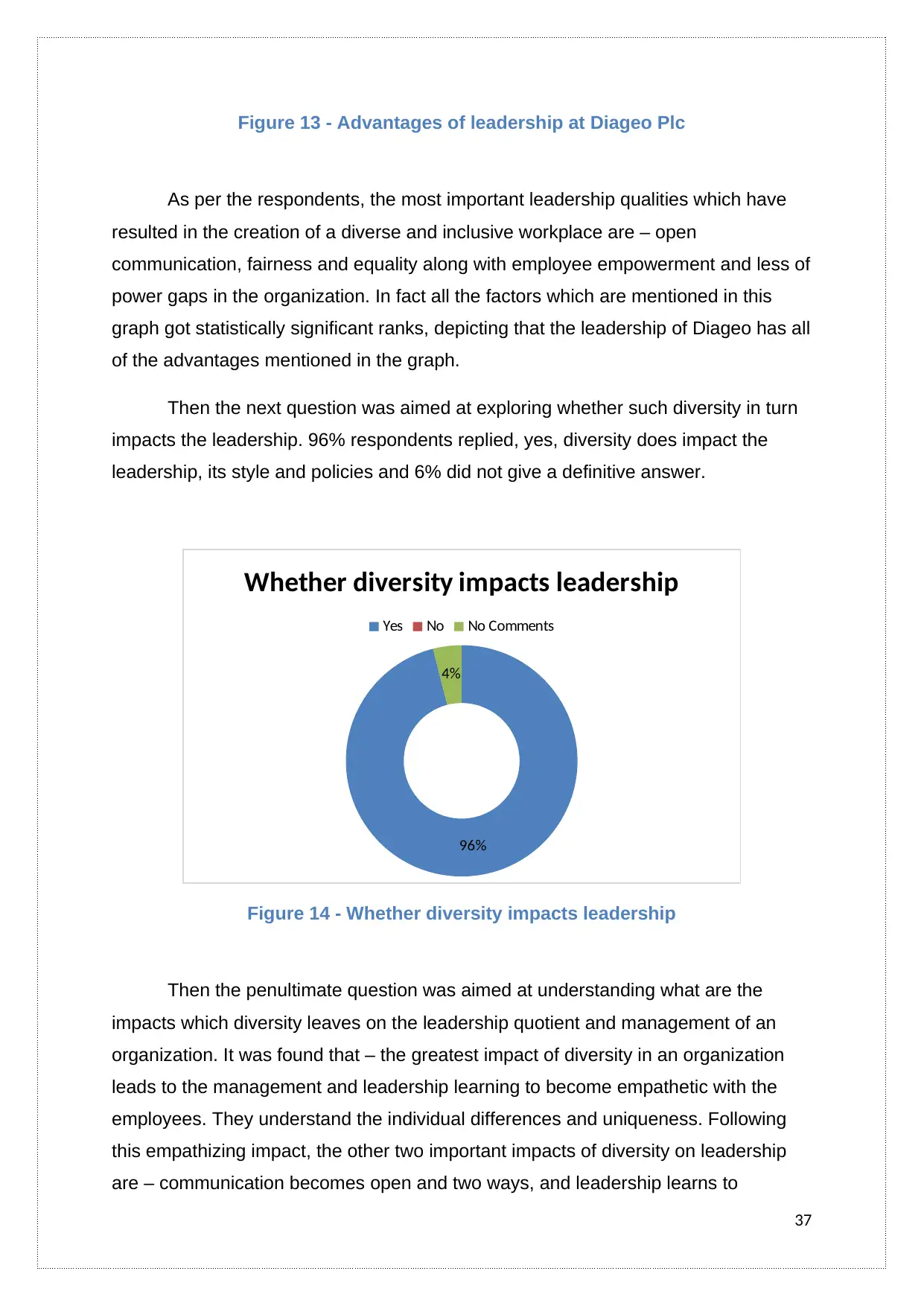
Figure 13 - Advantages of leadership at Diageo Plc
As per the respondents, the most important leadership qualities which have
resulted in the creation of a diverse and inclusive workplace are – open
communication, fairness and equality along with employee empowerment and less of
power gaps in the organization. In fact all the factors which are mentioned in this
graph got statistically significant ranks, depicting that the leadership of Diageo has all
of the advantages mentioned in the graph.
Then the next question was aimed at exploring whether such diversity in turn
impacts the leadership. 96% respondents replied, yes, diversity does impact the
leadership, its style and policies and 6% did not give a definitive answer.
96%
4%
Whether diversity impacts leadership
Yes No No Comments
Figure 14 - Whether diversity impacts leadership
Then the penultimate question was aimed at understanding what are the
impacts which diversity leaves on the leadership quotient and management of an
organization. It was found that – the greatest impact of diversity in an organization
leads to the management and leadership learning to become empathetic with the
employees. They understand the individual differences and uniqueness. Following
this empathizing impact, the other two important impacts of diversity on leadership
are – communication becomes open and two ways, and leadership learns to
37
As per the respondents, the most important leadership qualities which have
resulted in the creation of a diverse and inclusive workplace are – open
communication, fairness and equality along with employee empowerment and less of
power gaps in the organization. In fact all the factors which are mentioned in this
graph got statistically significant ranks, depicting that the leadership of Diageo has all
of the advantages mentioned in the graph.
Then the next question was aimed at exploring whether such diversity in turn
impacts the leadership. 96% respondents replied, yes, diversity does impact the
leadership, its style and policies and 6% did not give a definitive answer.
96%
4%
Whether diversity impacts leadership
Yes No No Comments
Figure 14 - Whether diversity impacts leadership
Then the penultimate question was aimed at understanding what are the
impacts which diversity leaves on the leadership quotient and management of an
organization. It was found that – the greatest impact of diversity in an organization
leads to the management and leadership learning to become empathetic with the
employees. They understand the individual differences and uniqueness. Following
this empathizing impact, the other two important impacts of diversity on leadership
are – communication becomes open and two ways, and leadership learns to
37
Paraphrase This Document
Need a fresh take? Get an instant paraphrase of this document with our AI Paraphraser

empower the employees and the latter’s value and vision are taken into account.
Along with this, diversity impacts leadership in creating a very equal, transparent and
fair workplace where every individual is valued for her knowledge, skills and attitudes
and not discriminated based on any factor.
Leaders empathize
Open communication is promoted
Understand empowerment
Enhanced empowerment & knowledge management
Leaders promote career progression
Leaders create fair and neutral employee policies
Equal and fair work culture
3.8
3.9
4
4.1
4.2
4.3
4.4
4.5
4.6
Impact of diversity on leadership aspects
Figure 15 - Impact of Diversity on Leadership
The last question of QR2 aimed at asking the respondents whether Diageo needs
any improvement of leadership. 92% said no, no improvement is required. 8%
responded neither yes nor no.
38
Along with this, diversity impacts leadership in creating a very equal, transparent and
fair workplace where every individual is valued for her knowledge, skills and attitudes
and not discriminated based on any factor.
Leaders empathize
Open communication is promoted
Understand empowerment
Enhanced empowerment & knowledge management
Leaders promote career progression
Leaders create fair and neutral employee policies
Equal and fair work culture
3.8
3.9
4
4.1
4.2
4.3
4.4
4.5
4.6
Impact of diversity on leadership aspects
Figure 15 - Impact of Diversity on Leadership
The last question of QR2 aimed at asking the respondents whether Diageo needs
any improvement of leadership. 92% said no, no improvement is required. 8%
responded neither yes nor no.
38
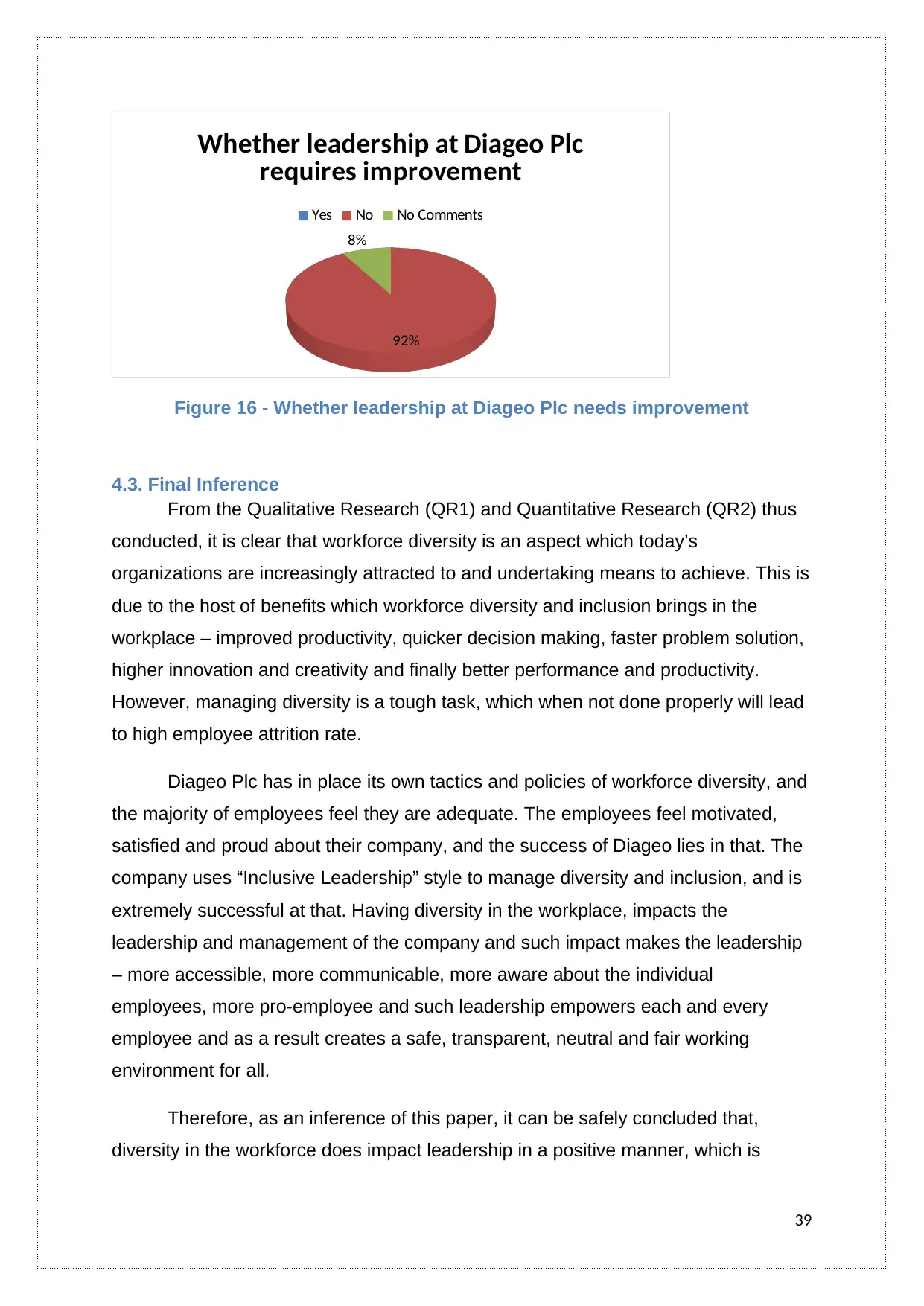
92%
8%
Whether leadership at Diageo Plc
requires improvement
Yes No No Comments
Figure 16 - Whether leadership at Diageo Plc needs improvement
4.3. Final Inference
From the Qualitative Research (QR1) and Quantitative Research (QR2) thus
conducted, it is clear that workforce diversity is an aspect which today’s
organizations are increasingly attracted to and undertaking means to achieve. This is
due to the host of benefits which workforce diversity and inclusion brings in the
workplace – improved productivity, quicker decision making, faster problem solution,
higher innovation and creativity and finally better performance and productivity.
However, managing diversity is a tough task, which when not done properly will lead
to high employee attrition rate.
Diageo Plc has in place its own tactics and policies of workforce diversity, and
the majority of employees feel they are adequate. The employees feel motivated,
satisfied and proud about their company, and the success of Diageo lies in that. The
company uses “Inclusive Leadership” style to manage diversity and inclusion, and is
extremely successful at that. Having diversity in the workplace, impacts the
leadership and management of the company and such impact makes the leadership
– more accessible, more communicable, more aware about the individual
employees, more pro-employee and such leadership empowers each and every
employee and as a result creates a safe, transparent, neutral and fair working
environment for all.
Therefore, as an inference of this paper, it can be safely concluded that,
diversity in the workforce does impact leadership in a positive manner, which is
39
8%
Whether leadership at Diageo Plc
requires improvement
Yes No No Comments
Figure 16 - Whether leadership at Diageo Plc needs improvement
4.3. Final Inference
From the Qualitative Research (QR1) and Quantitative Research (QR2) thus
conducted, it is clear that workforce diversity is an aspect which today’s
organizations are increasingly attracted to and undertaking means to achieve. This is
due to the host of benefits which workforce diversity and inclusion brings in the
workplace – improved productivity, quicker decision making, faster problem solution,
higher innovation and creativity and finally better performance and productivity.
However, managing diversity is a tough task, which when not done properly will lead
to high employee attrition rate.
Diageo Plc has in place its own tactics and policies of workforce diversity, and
the majority of employees feel they are adequate. The employees feel motivated,
satisfied and proud about their company, and the success of Diageo lies in that. The
company uses “Inclusive Leadership” style to manage diversity and inclusion, and is
extremely successful at that. Having diversity in the workplace, impacts the
leadership and management of the company and such impact makes the leadership
– more accessible, more communicable, more aware about the individual
employees, more pro-employee and such leadership empowers each and every
employee and as a result creates a safe, transparent, neutral and fair working
environment for all.
Therefore, as an inference of this paper, it can be safely concluded that,
diversity in the workforce does impact leadership in a positive manner, which is
39
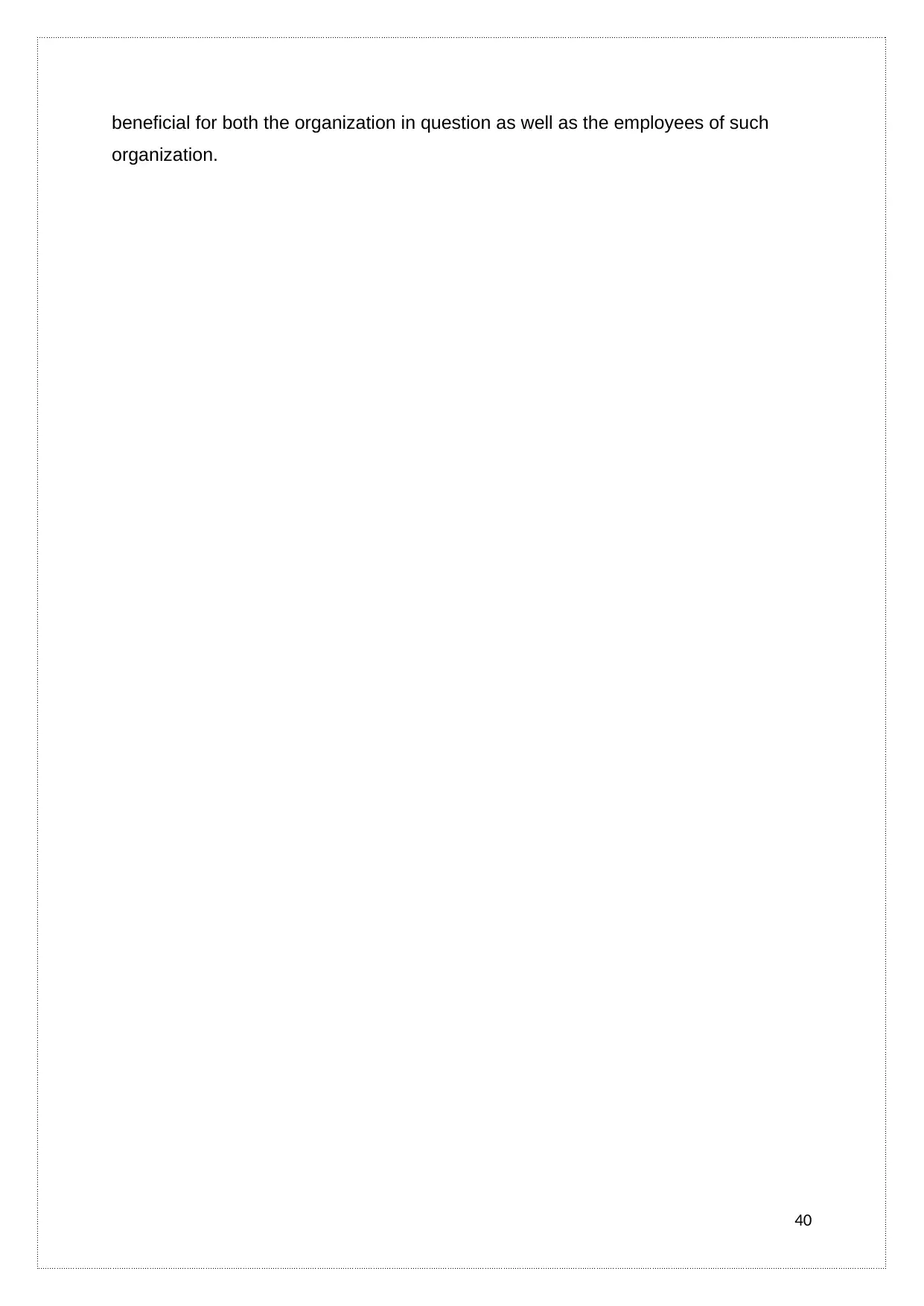
beneficial for both the organization in question as well as the employees of such
organization.
40
organization.
40
Secure Best Marks with AI Grader
Need help grading? Try our AI Grader for instant feedback on your assignments.

Chapter 5. Conclusion & Recommendations
This is the final chapter of this dissertation and will consist of the following –
summarization of the findings, a list of recommendation strategies which will further
help in improving the existing leadership of Diageo, an account on construct validity,
assumptions and limitations and the scope for further research.
5.1. Findings
The list of findings is as follows;
- Workforce diversity is an aspect which is aimed to be achieved by a number
of today’s organizations due to the host of benefits associated with it – higher
innovation and creativity, knowledge management, open communication,
quick decision making and problem solving etc.
- Management of diversity in the workforce is challenging and inadequate
management can lead to high employee attrition
- Diageo follows inclusive leadership and aims to empower each and every
employee irrespective of her/his background, social and economic strata,
ethnicity etc
- Diageo employees identified, innovation and creativity improvement as a
result of workforce diversity, and also identified increase in overall knowledge
and improvement of work culture
- Diageo employees identified high employee turnover and employees feeling
undervalued when diversity is not management effectively
- It was found that for an organization to bring in and manage effective diversity
in its midst, it must have effective leadership and support from the top
management. Along with this, presenting career growth prospects for every
employee also is attractive for maintaining and managing diversity in the
workplace
- The employees feel that Diageo has effective diversity policies and leadership
policies which promote diversity in its workplace
- The respondents of QR2 identified as the following features being
characteristics of their leadership – open communication, low power gap,
fairness and equality, employee decision making etc.
41
This is the final chapter of this dissertation and will consist of the following –
summarization of the findings, a list of recommendation strategies which will further
help in improving the existing leadership of Diageo, an account on construct validity,
assumptions and limitations and the scope for further research.
5.1. Findings
The list of findings is as follows;
- Workforce diversity is an aspect which is aimed to be achieved by a number
of today’s organizations due to the host of benefits associated with it – higher
innovation and creativity, knowledge management, open communication,
quick decision making and problem solving etc.
- Management of diversity in the workforce is challenging and inadequate
management can lead to high employee attrition
- Diageo follows inclusive leadership and aims to empower each and every
employee irrespective of her/his background, social and economic strata,
ethnicity etc
- Diageo employees identified, innovation and creativity improvement as a
result of workforce diversity, and also identified increase in overall knowledge
and improvement of work culture
- Diageo employees identified high employee turnover and employees feeling
undervalued when diversity is not management effectively
- It was found that for an organization to bring in and manage effective diversity
in its midst, it must have effective leadership and support from the top
management. Along with this, presenting career growth prospects for every
employee also is attractive for maintaining and managing diversity in the
workplace
- The employees feel that Diageo has effective diversity policies and leadership
policies which promote diversity in its workplace
- The respondents of QR2 identified as the following features being
characteristics of their leadership – open communication, low power gap,
fairness and equality, employee decision making etc.
41

- 96% of the respondents of Quantitative Research highlighted that workforce
diversity and overall diversity within the organization does impact the
leadership of such company.
- Such impact comes in the form of the leadership being more empathetic,
inclusive, promotes a fair work culture, provides employee empowerment and
enhances knowledge management etc.
Therefore as a final inference it can be mentioned that, diversity in the workforce
impacts the organizational leadership into becoming more open and more
empowering and inclusive. And having effective organizational inclusive leadership
also impacts in having a well managed employee diversity in the workforce.
5.2. Recommendations
Though from the findings it was identified that Diageo Plc is extremely
effective in handling diverse employee groups and its leadership styles and actions
are such, that such diversity is promoted in the work settings. Still a number of
recommendation strategies are mentioned which will help Diageo or any other
company to align its leadership and functions to meet with the objective of promoting
further diversity and inclusion in their work environment.
- Inclusive leadership must be aimed to be built in the work setting (Smyth,
2018)
- Organizations must aim at creating, nurturing and support diversity
- Open channels of communication must be encouraged and feedback
channels must be constructed
- Leaders must embrace the diversity in the workplace by giving efforts in
knowing the detail of his/her employees and gaining information about them
- Organizations must ensure that, every employee has opportunities to take an
active part in the decision making (Lim, Cho, & Curry, 2009)
- Collective lunch programs can be arranged which will help employees’ share
food and this shall create an opportunity for them to know about each other’s
cultures
42
diversity and overall diversity within the organization does impact the
leadership of such company.
- Such impact comes in the form of the leadership being more empathetic,
inclusive, promotes a fair work culture, provides employee empowerment and
enhances knowledge management etc.
Therefore as a final inference it can be mentioned that, diversity in the workforce
impacts the organizational leadership into becoming more open and more
empowering and inclusive. And having effective organizational inclusive leadership
also impacts in having a well managed employee diversity in the workforce.
5.2. Recommendations
Though from the findings it was identified that Diageo Plc is extremely
effective in handling diverse employee groups and its leadership styles and actions
are such, that such diversity is promoted in the work settings. Still a number of
recommendation strategies are mentioned which will help Diageo or any other
company to align its leadership and functions to meet with the objective of promoting
further diversity and inclusion in their work environment.
- Inclusive leadership must be aimed to be built in the work setting (Smyth,
2018)
- Organizations must aim at creating, nurturing and support diversity
- Open channels of communication must be encouraged and feedback
channels must be constructed
- Leaders must embrace the diversity in the workplace by giving efforts in
knowing the detail of his/her employees and gaining information about them
- Organizations must ensure that, every employee has opportunities to take an
active part in the decision making (Lim, Cho, & Curry, 2009)
- Collective lunch programs can be arranged which will help employees’ share
food and this shall create an opportunity for them to know about each other’s
cultures
42

- Acknowledgement of special days of the employees, namely, culture days,
independent days, celebration of international day for individuals with
disabilities, gay pride celebrations must be recognized which will help the
employees to feel valued (Thomas, 2018)
- Organizations can create multicultural calendars to ensure that days of
important meetings do not fall on different significant cultural holidays
- Acknowledgement of all the employees, their differences, their uniqueness etc
is a must for creating a diverse and inclusive workforce (HR Council, 2018).
5.3. Construct Validity
Construct validity is said to be achieved, when the research objectives
created at the start of the project are efficiently met with by the findings of the
research. Four objectives were created at the start of this paper, and each of them
has been met with. The primary objective was to know about the concept of
workforce diversity, secondly, it was to understand how such impacts the leadership
aspects in a work environment and thirdly, it was to find out the suitable leadership
styles in managing the workplace and lastly a set of recommendation strategies were
to be formed. Based on the findings, all the research objectives have been met with
and knowledge pertaining to all of them has been presented in the Findings segment
of this paper. Therefore, it can be inferred that construct validity has been met with.
5.4. Assumptions & Limitations
The assumptions which are considered to be as facts by the researcher for
this dissertation are;
- The respondents of qualitative research and experts in knowing about the
implications of workforce diversity and the management practices of Diageo,
and they have given information in the best of their knowledge
- The information provided by the respondents are correct and they have not
manipulated in any way to improve the reputation and image of their
company.
The limitations of this research were;
43
independent days, celebration of international day for individuals with
disabilities, gay pride celebrations must be recognized which will help the
employees to feel valued (Thomas, 2018)
- Organizations can create multicultural calendars to ensure that days of
important meetings do not fall on different significant cultural holidays
- Acknowledgement of all the employees, their differences, their uniqueness etc
is a must for creating a diverse and inclusive workforce (HR Council, 2018).
5.3. Construct Validity
Construct validity is said to be achieved, when the research objectives
created at the start of the project are efficiently met with by the findings of the
research. Four objectives were created at the start of this paper, and each of them
has been met with. The primary objective was to know about the concept of
workforce diversity, secondly, it was to understand how such impacts the leadership
aspects in a work environment and thirdly, it was to find out the suitable leadership
styles in managing the workplace and lastly a set of recommendation strategies were
to be formed. Based on the findings, all the research objectives have been met with
and knowledge pertaining to all of them has been presented in the Findings segment
of this paper. Therefore, it can be inferred that construct validity has been met with.
5.4. Assumptions & Limitations
The assumptions which are considered to be as facts by the researcher for
this dissertation are;
- The respondents of qualitative research and experts in knowing about the
implications of workforce diversity and the management practices of Diageo,
and they have given information in the best of their knowledge
- The information provided by the respondents are correct and they have not
manipulated in any way to improve the reputation and image of their
company.
The limitations of this research were;
43
Paraphrase This Document
Need a fresh take? Get an instant paraphrase of this document with our AI Paraphraser
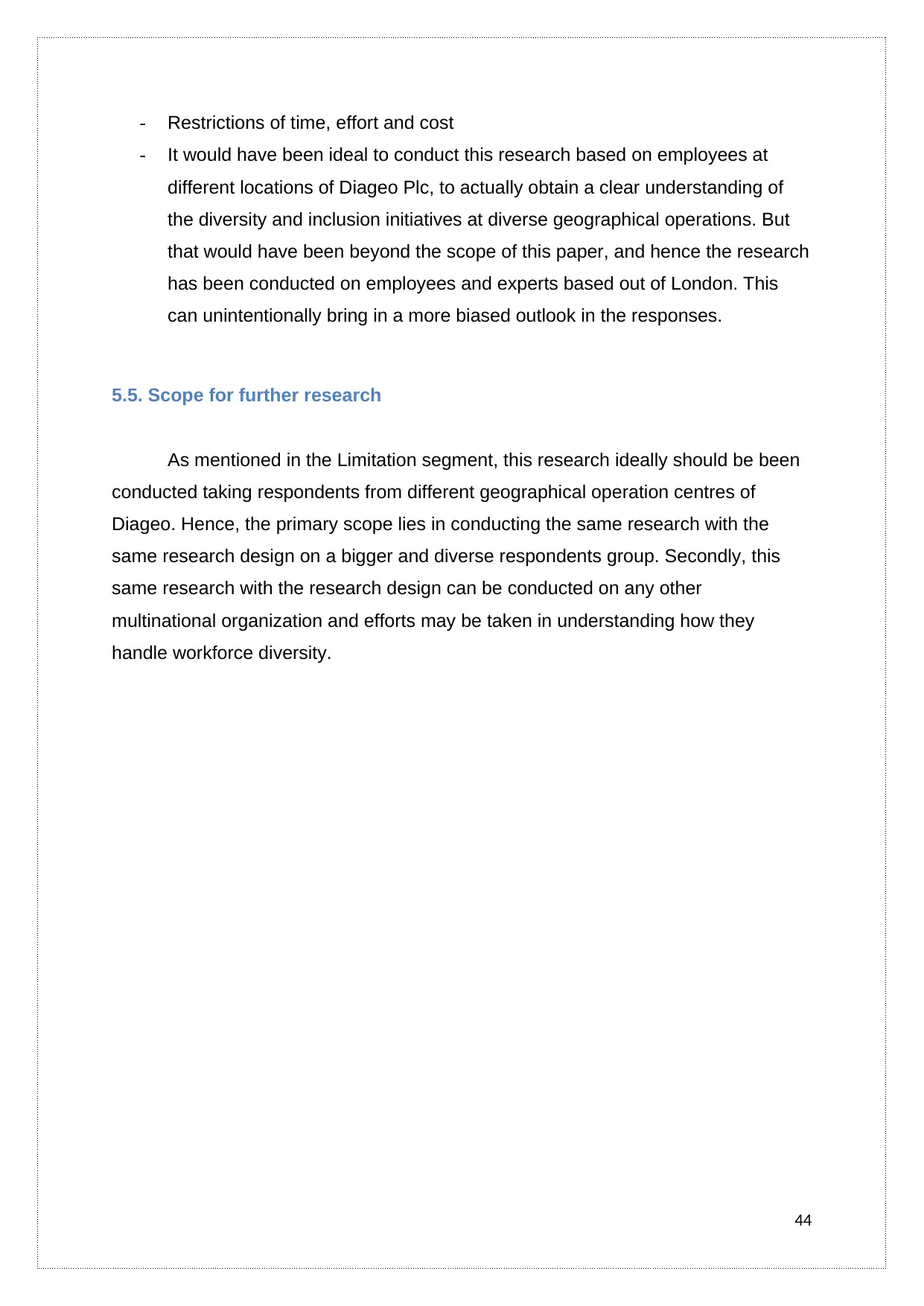
- Restrictions of time, effort and cost
- It would have been ideal to conduct this research based on employees at
different locations of Diageo Plc, to actually obtain a clear understanding of
the diversity and inclusion initiatives at diverse geographical operations. But
that would have been beyond the scope of this paper, and hence the research
has been conducted on employees and experts based out of London. This
can unintentionally bring in a more biased outlook in the responses.
5.5. Scope for further research
As mentioned in the Limitation segment, this research ideally should be been
conducted taking respondents from different geographical operation centres of
Diageo. Hence, the primary scope lies in conducting the same research with the
same research design on a bigger and diverse respondents group. Secondly, this
same research with the research design can be conducted on any other
multinational organization and efforts may be taken in understanding how they
handle workforce diversity.
44
- It would have been ideal to conduct this research based on employees at
different locations of Diageo Plc, to actually obtain a clear understanding of
the diversity and inclusion initiatives at diverse geographical operations. But
that would have been beyond the scope of this paper, and hence the research
has been conducted on employees and experts based out of London. This
can unintentionally bring in a more biased outlook in the responses.
5.5. Scope for further research
As mentioned in the Limitation segment, this research ideally should be been
conducted taking respondents from different geographical operation centres of
Diageo. Hence, the primary scope lies in conducting the same research with the
same research design on a bigger and diverse respondents group. Secondly, this
same research with the research design can be conducted on any other
multinational organization and efforts may be taken in understanding how they
handle workforce diversity.
44
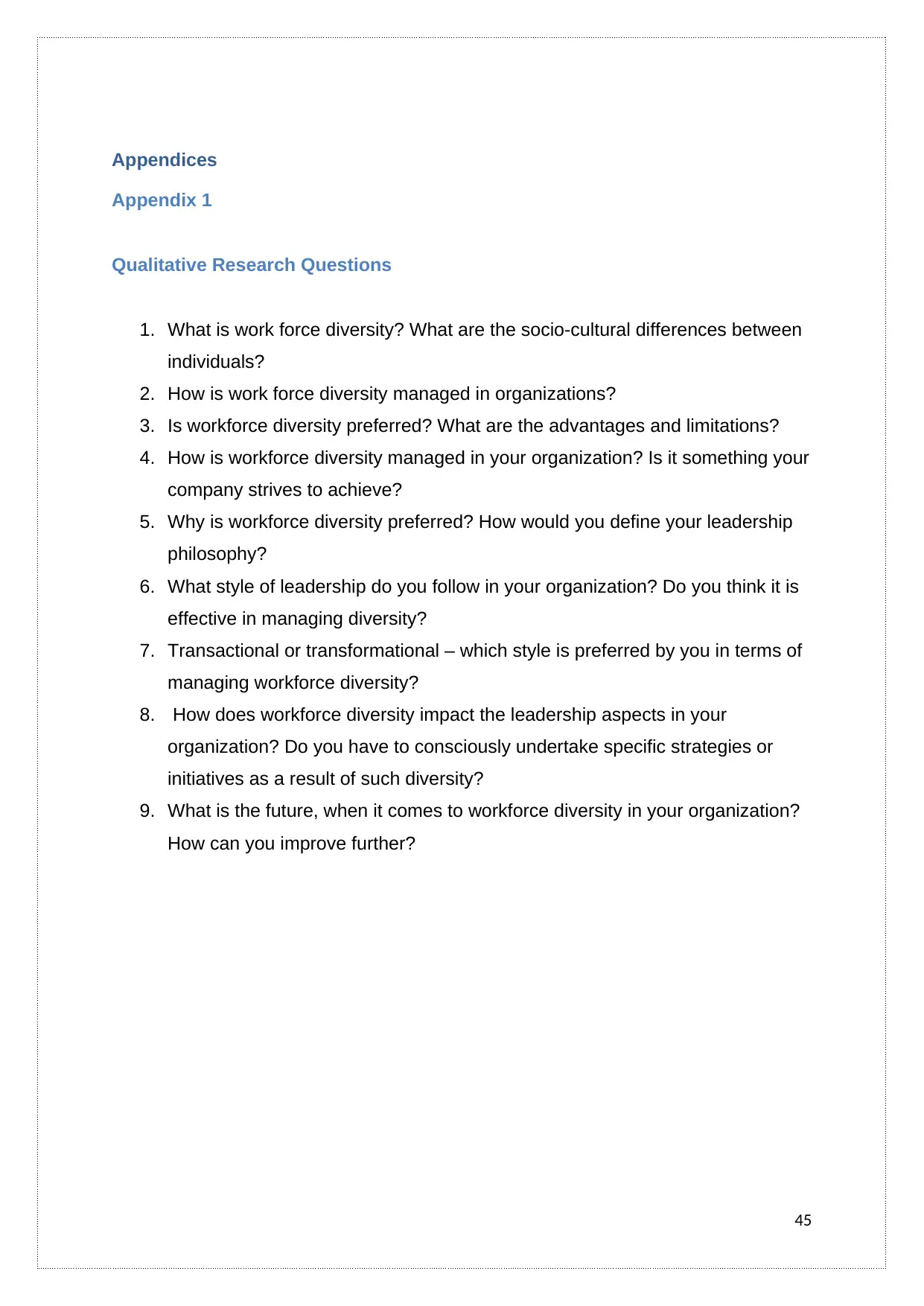
Appendices
Appendix 1
Qualitative Research Questions
1. What is work force diversity? What are the socio-cultural differences between
individuals?
2. How is work force diversity managed in organizations?
3. Is workforce diversity preferred? What are the advantages and limitations?
4. How is workforce diversity managed in your organization? Is it something your
company strives to achieve?
5. Why is workforce diversity preferred? How would you define your leadership
philosophy?
6. What style of leadership do you follow in your organization? Do you think it is
effective in managing diversity?
7. Transactional or transformational – which style is preferred by you in terms of
managing workforce diversity?
8. How does workforce diversity impact the leadership aspects in your
organization? Do you have to consciously undertake specific strategies or
initiatives as a result of such diversity?
9. What is the future, when it comes to workforce diversity in your organization?
How can you improve further?
45
Appendix 1
Qualitative Research Questions
1. What is work force diversity? What are the socio-cultural differences between
individuals?
2. How is work force diversity managed in organizations?
3. Is workforce diversity preferred? What are the advantages and limitations?
4. How is workforce diversity managed in your organization? Is it something your
company strives to achieve?
5. Why is workforce diversity preferred? How would you define your leadership
philosophy?
6. What style of leadership do you follow in your organization? Do you think it is
effective in managing diversity?
7. Transactional or transformational – which style is preferred by you in terms of
managing workforce diversity?
8. How does workforce diversity impact the leadership aspects in your
organization? Do you have to consciously undertake specific strategies or
initiatives as a result of such diversity?
9. What is the future, when it comes to workforce diversity in your organization?
How can you improve further?
45

Appendix 2
Quantitative Research Questionnaire
Section A
(This section consists of questions all aimed at understanding the general
characteristics of the respondents)
1. Please tick your gender
Male
Female
No Comments
2. Please tick the appropriate box denoting your age
26 to 30 years
30 to 35 years
36 to 40 years
40 years and above
3. What is your over all work experience?
2 years to 5 years
5 years to 7 years
7 years to 10 years
More than 10 years
4. How long have you been working in Diageo Plc?
Less than 1 year
1 year to 2.5 years
2.6 to 5 years
5.1 to 10 years
Above 10 years
5. Do you know what workforce diversity is?
Yes
No
No Comments
6. Do you feel your company supports diversity and inclusiveness?
Yes
No
46
Quantitative Research Questionnaire
Section A
(This section consists of questions all aimed at understanding the general
characteristics of the respondents)
1. Please tick your gender
Male
Female
No Comments
2. Please tick the appropriate box denoting your age
26 to 30 years
30 to 35 years
36 to 40 years
40 years and above
3. What is your over all work experience?
2 years to 5 years
5 years to 7 years
7 years to 10 years
More than 10 years
4. How long have you been working in Diageo Plc?
Less than 1 year
1 year to 2.5 years
2.6 to 5 years
5.1 to 10 years
Above 10 years
5. Do you know what workforce diversity is?
Yes
No
No Comments
6. Do you feel your company supports diversity and inclusiveness?
Yes
No
46
Secure Best Marks with AI Grader
Need help grading? Try our AI Grader for instant feedback on your assignments.
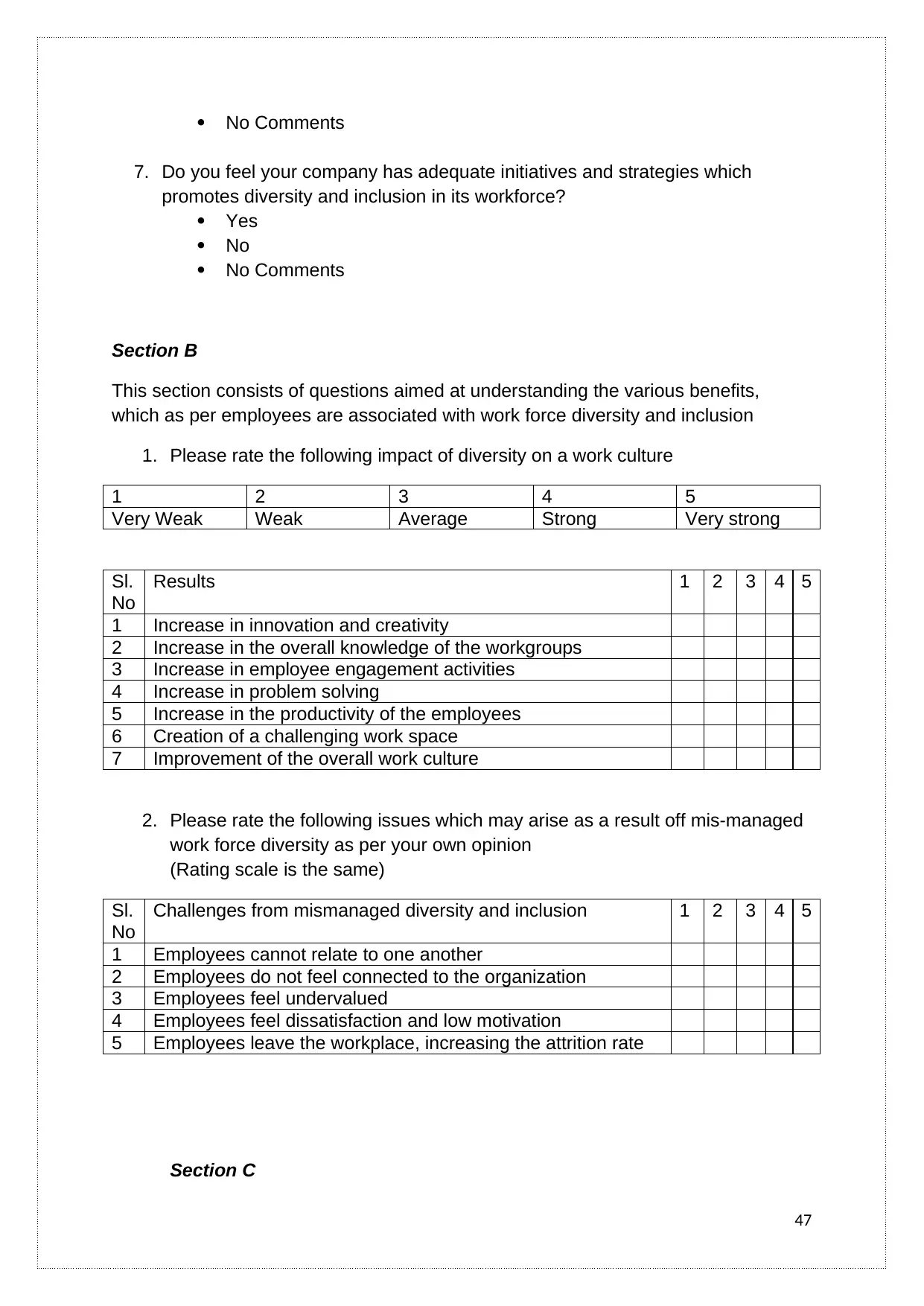
No Comments
7. Do you feel your company has adequate initiatives and strategies which
promotes diversity and inclusion in its workforce?
Yes
No
No Comments
Section B
This section consists of questions aimed at understanding the various benefits,
which as per employees are associated with work force diversity and inclusion
1. Please rate the following impact of diversity on a work culture
1 2 3 4 5
Very Weak Weak Average Strong Very strong
Sl.
No
Results 1 2 3 4 5
1 Increase in innovation and creativity
2 Increase in the overall knowledge of the workgroups
3 Increase in employee engagement activities
4 Increase in problem solving
5 Increase in the productivity of the employees
6 Creation of a challenging work space
7 Improvement of the overall work culture
2. Please rate the following issues which may arise as a result off mis-managed
work force diversity as per your own opinion
(Rating scale is the same)
Sl.
No
Challenges from mismanaged diversity and inclusion 1 2 3 4 5
1 Employees cannot relate to one another
2 Employees do not feel connected to the organization
3 Employees feel undervalued
4 Employees feel dissatisfaction and low motivation
5 Employees leave the workplace, increasing the attrition rate
Section C
47
7. Do you feel your company has adequate initiatives and strategies which
promotes diversity and inclusion in its workforce?
Yes
No
No Comments
Section B
This section consists of questions aimed at understanding the various benefits,
which as per employees are associated with work force diversity and inclusion
1. Please rate the following impact of diversity on a work culture
1 2 3 4 5
Very Weak Weak Average Strong Very strong
Sl.
No
Results 1 2 3 4 5
1 Increase in innovation and creativity
2 Increase in the overall knowledge of the workgroups
3 Increase in employee engagement activities
4 Increase in problem solving
5 Increase in the productivity of the employees
6 Creation of a challenging work space
7 Improvement of the overall work culture
2. Please rate the following issues which may arise as a result off mis-managed
work force diversity as per your own opinion
(Rating scale is the same)
Sl.
No
Challenges from mismanaged diversity and inclusion 1 2 3 4 5
1 Employees cannot relate to one another
2 Employees do not feel connected to the organization
3 Employees feel undervalued
4 Employees feel dissatisfaction and low motivation
5 Employees leave the workplace, increasing the attrition rate
Section C
47
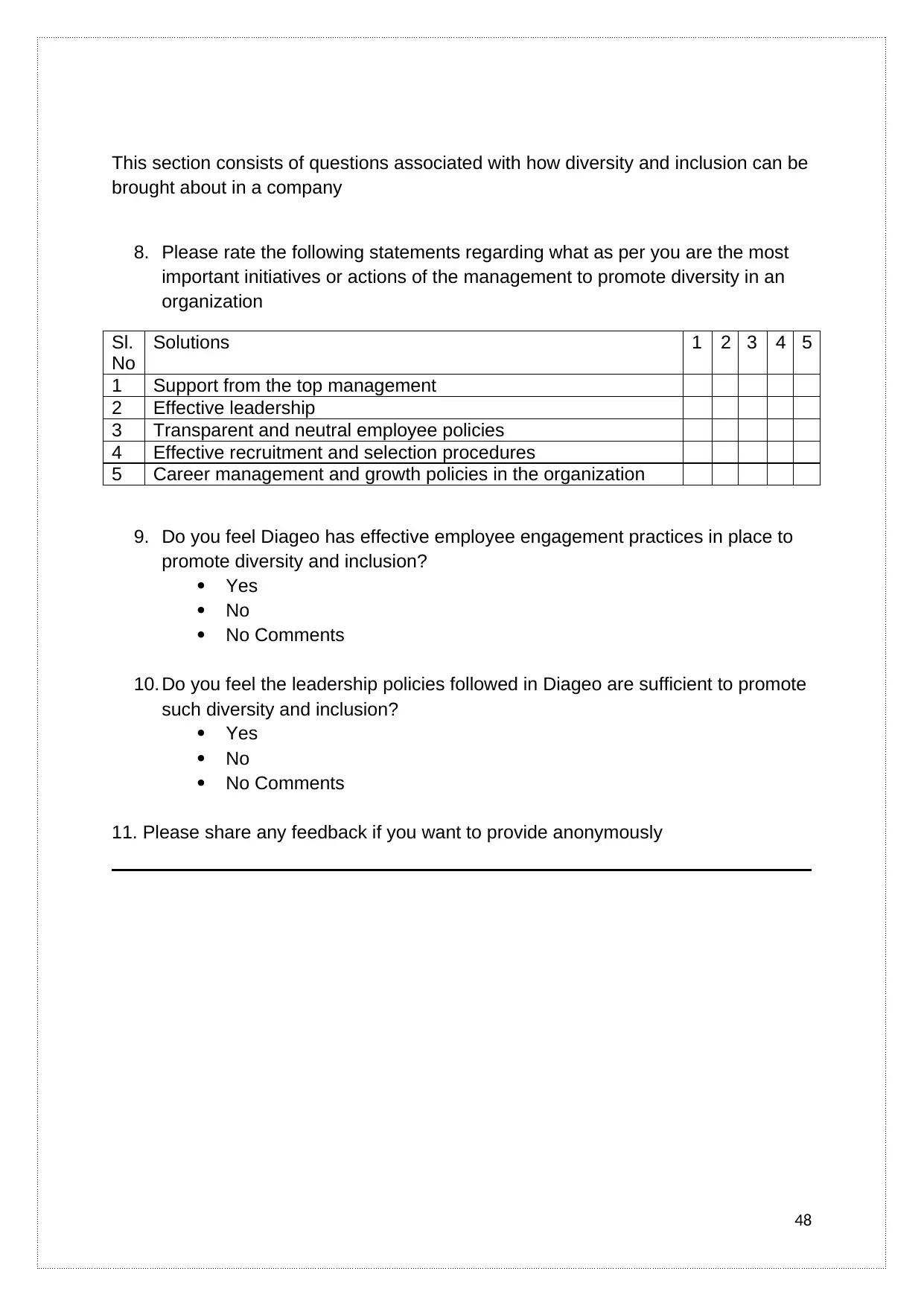
This section consists of questions associated with how diversity and inclusion can be
brought about in a company
8. Please rate the following statements regarding what as per you are the most
important initiatives or actions of the management to promote diversity in an
organization
Sl.
No
Solutions 1 2 3 4 5
1 Support from the top management
2 Effective leadership
3 Transparent and neutral employee policies
4 Effective recruitment and selection procedures
5 Career management and growth policies in the organization
9. Do you feel Diageo has effective employee engagement practices in place to
promote diversity and inclusion?
Yes
No
No Comments
10. Do you feel the leadership policies followed in Diageo are sufficient to promote
such diversity and inclusion?
Yes
No
No Comments
11. Please share any feedback if you want to provide anonymously
48
brought about in a company
8. Please rate the following statements regarding what as per you are the most
important initiatives or actions of the management to promote diversity in an
organization
Sl.
No
Solutions 1 2 3 4 5
1 Support from the top management
2 Effective leadership
3 Transparent and neutral employee policies
4 Effective recruitment and selection procedures
5 Career management and growth policies in the organization
9. Do you feel Diageo has effective employee engagement practices in place to
promote diversity and inclusion?
Yes
No
No Comments
10. Do you feel the leadership policies followed in Diageo are sufficient to promote
such diversity and inclusion?
Yes
No
No Comments
11. Please share any feedback if you want to provide anonymously
48
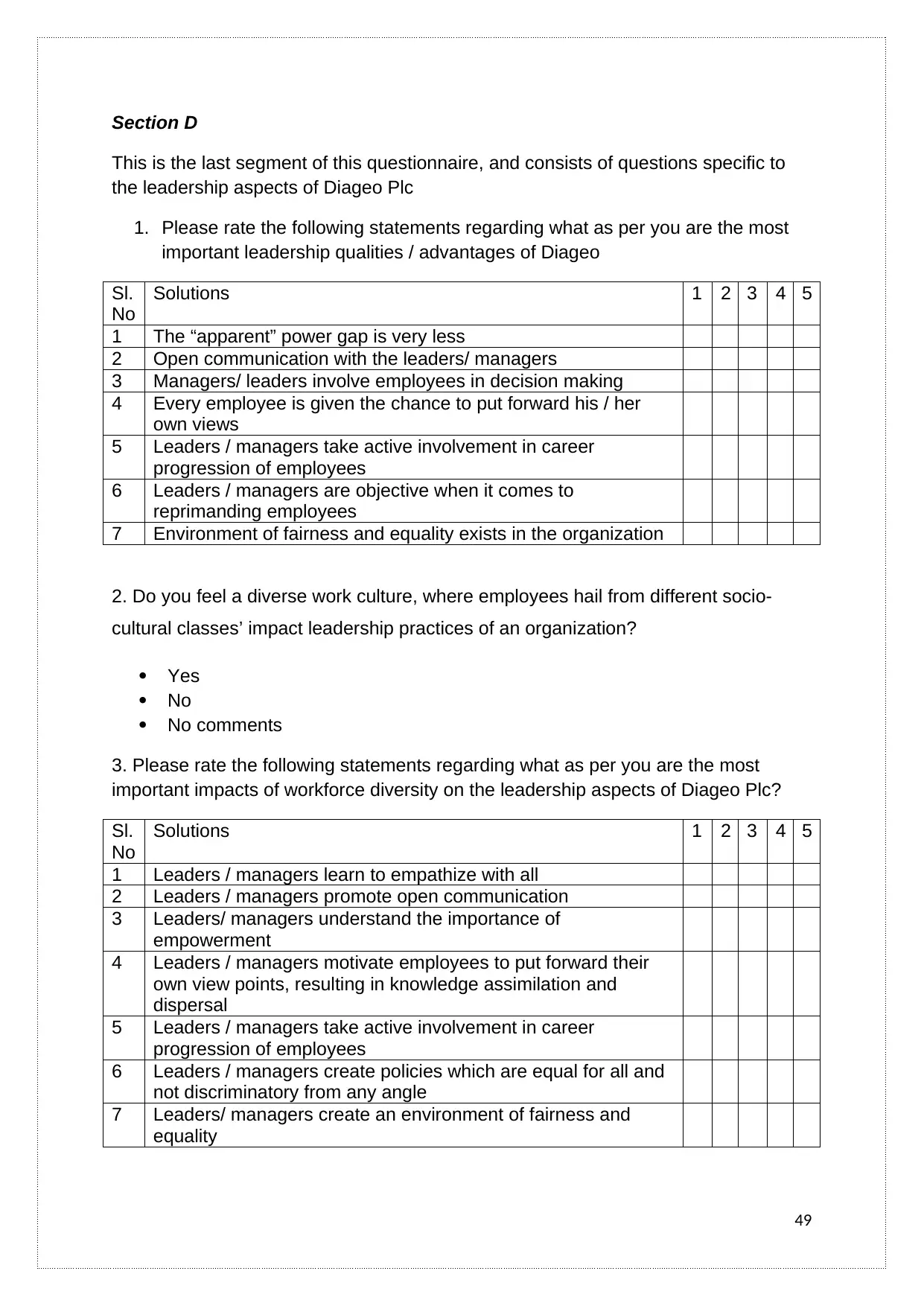
Section D
This is the last segment of this questionnaire, and consists of questions specific to
the leadership aspects of Diageo Plc
1. Please rate the following statements regarding what as per you are the most
important leadership qualities / advantages of Diageo
Sl.
No
Solutions 1 2 3 4 5
1 The “apparent” power gap is very less
2 Open communication with the leaders/ managers
3 Managers/ leaders involve employees in decision making
4 Every employee is given the chance to put forward his / her
own views
5 Leaders / managers take active involvement in career
progression of employees
6 Leaders / managers are objective when it comes to
reprimanding employees
7 Environment of fairness and equality exists in the organization
2. Do you feel a diverse work culture, where employees hail from different socio-
cultural classes’ impact leadership practices of an organization?
Yes
No
No comments
3. Please rate the following statements regarding what as per you are the most
important impacts of workforce diversity on the leadership aspects of Diageo Plc?
Sl.
No
Solutions 1 2 3 4 5
1 Leaders / managers learn to empathize with all
2 Leaders / managers promote open communication
3 Leaders/ managers understand the importance of
empowerment
4 Leaders / managers motivate employees to put forward their
own view points, resulting in knowledge assimilation and
dispersal
5 Leaders / managers take active involvement in career
progression of employees
6 Leaders / managers create policies which are equal for all and
not discriminatory from any angle
7 Leaders/ managers create an environment of fairness and
equality
49
This is the last segment of this questionnaire, and consists of questions specific to
the leadership aspects of Diageo Plc
1. Please rate the following statements regarding what as per you are the most
important leadership qualities / advantages of Diageo
Sl.
No
Solutions 1 2 3 4 5
1 The “apparent” power gap is very less
2 Open communication with the leaders/ managers
3 Managers/ leaders involve employees in decision making
4 Every employee is given the chance to put forward his / her
own views
5 Leaders / managers take active involvement in career
progression of employees
6 Leaders / managers are objective when it comes to
reprimanding employees
7 Environment of fairness and equality exists in the organization
2. Do you feel a diverse work culture, where employees hail from different socio-
cultural classes’ impact leadership practices of an organization?
Yes
No
No comments
3. Please rate the following statements regarding what as per you are the most
important impacts of workforce diversity on the leadership aspects of Diageo Plc?
Sl.
No
Solutions 1 2 3 4 5
1 Leaders / managers learn to empathize with all
2 Leaders / managers promote open communication
3 Leaders/ managers understand the importance of
empowerment
4 Leaders / managers motivate employees to put forward their
own view points, resulting in knowledge assimilation and
dispersal
5 Leaders / managers take active involvement in career
progression of employees
6 Leaders / managers create policies which are equal for all and
not discriminatory from any angle
7 Leaders/ managers create an environment of fairness and
equality
49
Paraphrase This Document
Need a fresh take? Get an instant paraphrase of this document with our AI Paraphraser
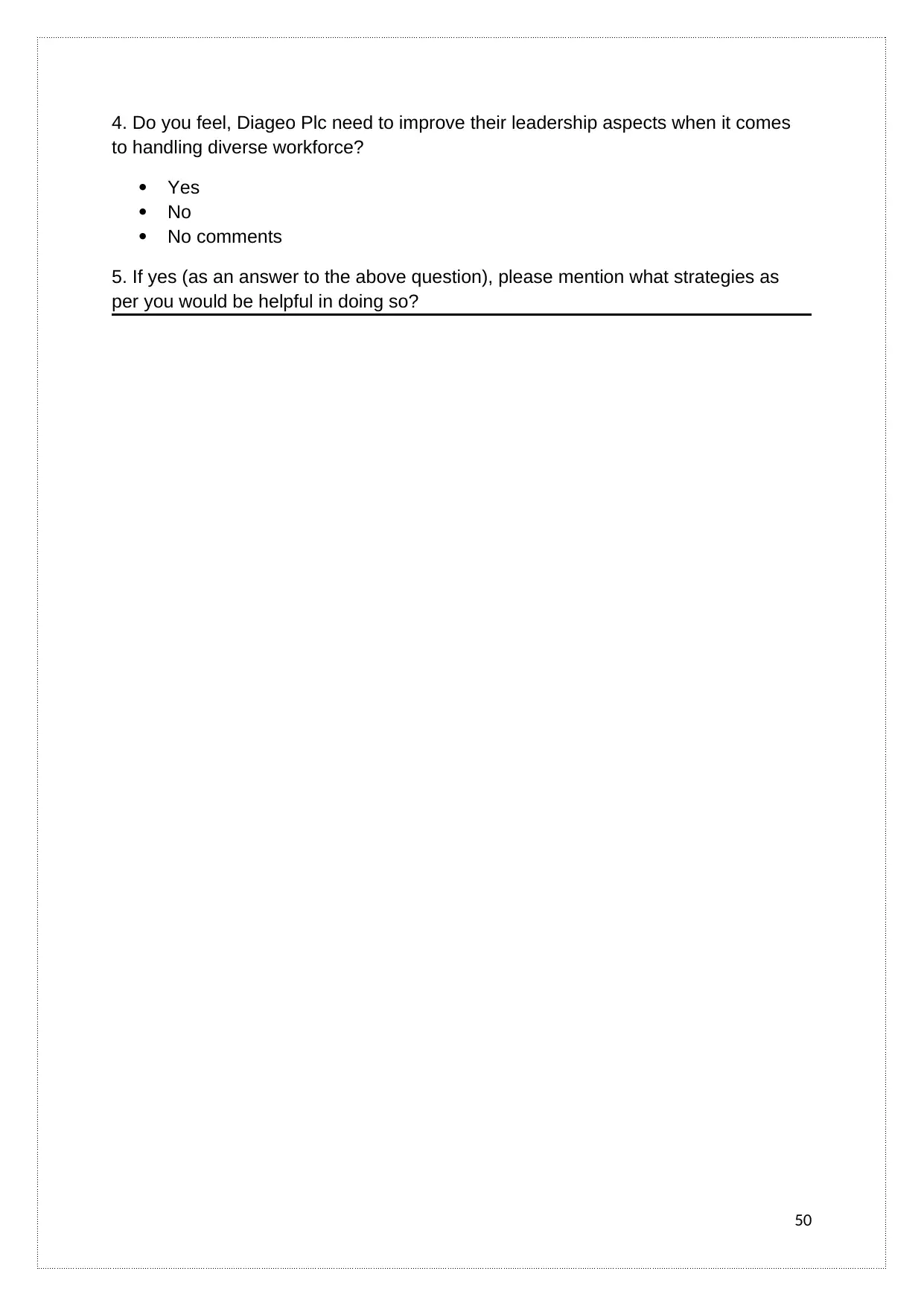
4. Do you feel, Diageo Plc need to improve their leadership aspects when it comes
to handling diverse workforce?
Yes
No
No comments
5. If yes (as an answer to the above question), please mention what strategies as
per you would be helpful in doing so?
50
to handling diverse workforce?
Yes
No
No comments
5. If yes (as an answer to the above question), please mention what strategies as
per you would be helpful in doing so?
50
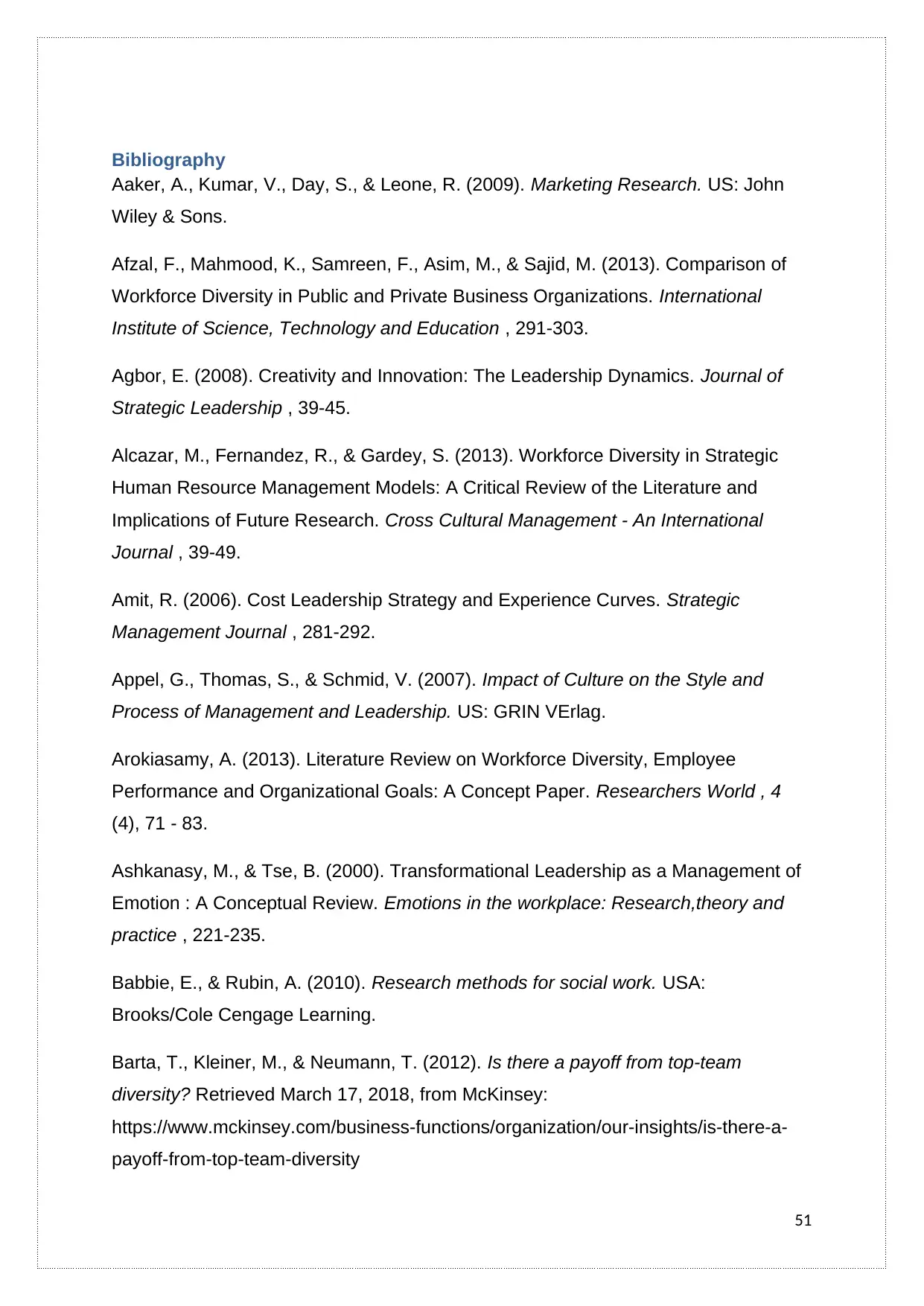
Bibliography
Aaker, A., Kumar, V., Day, S., & Leone, R. (2009). Marketing Research. US: John
Wiley & Sons.
Afzal, F., Mahmood, K., Samreen, F., Asim, M., & Sajid, M. (2013). Comparison of
Workforce Diversity in Public and Private Business Organizations. International
Institute of Science, Technology and Education , 291-303.
Agbor, E. (2008). Creativity and Innovation: The Leadership Dynamics. Journal of
Strategic Leadership , 39-45.
Alcazar, M., Fernandez, R., & Gardey, S. (2013). Workforce Diversity in Strategic
Human Resource Management Models: A Critical Review of the Literature and
Implications of Future Research. Cross Cultural Management - An International
Journal , 39-49.
Amit, R. (2006). Cost Leadership Strategy and Experience Curves. Strategic
Management Journal , 281-292.
Appel, G., Thomas, S., & Schmid, V. (2007). Impact of Culture on the Style and
Process of Management and Leadership. US: GRIN VErlag.
Arokiasamy, A. (2013). Literature Review on Workforce Diversity, Employee
Performance and Organizational Goals: A Concept Paper. Researchers World , 4
(4), 71 - 83.
Ashkanasy, M., & Tse, B. (2000). Transformational Leadership as a Management of
Emotion : A Conceptual Review. Emotions in the workplace: Research,theory and
practice , 221-235.
Babbie, E., & Rubin, A. (2010). Research methods for social work. USA:
Brooks/Cole Cengage Learning.
Barta, T., Kleiner, M., & Neumann, T. (2012). Is there a payoff from top-team
diversity? Retrieved March 17, 2018, from McKinsey:
https://www.mckinsey.com/business-functions/organization/our-insights/is-there-a-
payoff-from-top-team-diversity
51
Aaker, A., Kumar, V., Day, S., & Leone, R. (2009). Marketing Research. US: John
Wiley & Sons.
Afzal, F., Mahmood, K., Samreen, F., Asim, M., & Sajid, M. (2013). Comparison of
Workforce Diversity in Public and Private Business Organizations. International
Institute of Science, Technology and Education , 291-303.
Agbor, E. (2008). Creativity and Innovation: The Leadership Dynamics. Journal of
Strategic Leadership , 39-45.
Alcazar, M., Fernandez, R., & Gardey, S. (2013). Workforce Diversity in Strategic
Human Resource Management Models: A Critical Review of the Literature and
Implications of Future Research. Cross Cultural Management - An International
Journal , 39-49.
Amit, R. (2006). Cost Leadership Strategy and Experience Curves. Strategic
Management Journal , 281-292.
Appel, G., Thomas, S., & Schmid, V. (2007). Impact of Culture on the Style and
Process of Management and Leadership. US: GRIN VErlag.
Arokiasamy, A. (2013). Literature Review on Workforce Diversity, Employee
Performance and Organizational Goals: A Concept Paper. Researchers World , 4
(4), 71 - 83.
Ashkanasy, M., & Tse, B. (2000). Transformational Leadership as a Management of
Emotion : A Conceptual Review. Emotions in the workplace: Research,theory and
practice , 221-235.
Babbie, E., & Rubin, A. (2010). Research methods for social work. USA:
Brooks/Cole Cengage Learning.
Barta, T., Kleiner, M., & Neumann, T. (2012). Is there a payoff from top-team
diversity? Retrieved March 17, 2018, from McKinsey:
https://www.mckinsey.com/business-functions/organization/our-insights/is-there-a-
payoff-from-top-team-diversity
51
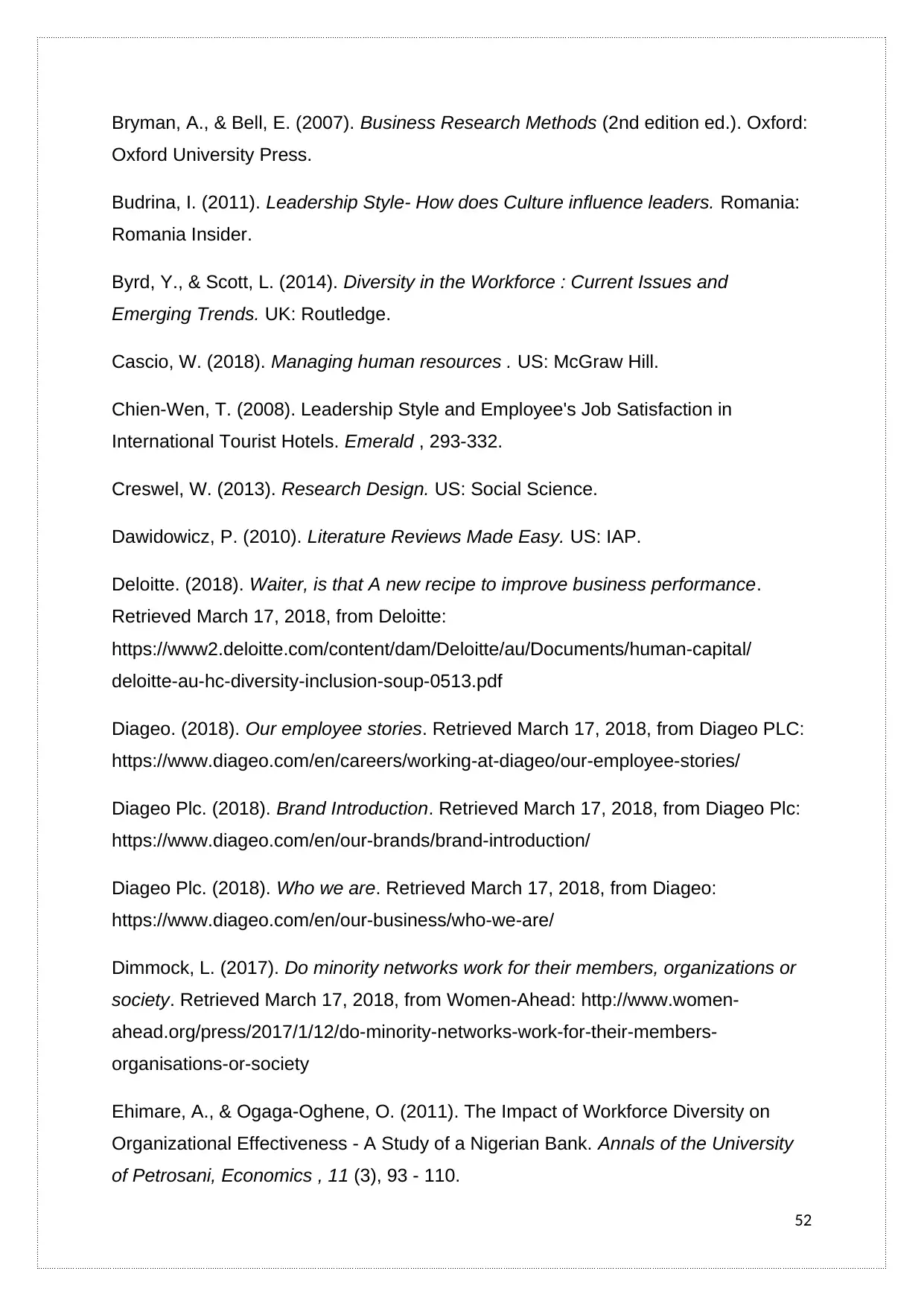
Bryman, A., & Bell, E. (2007). Business Research Methods (2nd edition ed.). Oxford:
Oxford University Press.
Budrina, I. (2011). Leadership Style- How does Culture influence leaders. Romania:
Romania Insider.
Byrd, Y., & Scott, L. (2014). Diversity in the Workforce : Current Issues and
Emerging Trends. UK: Routledge.
Cascio, W. (2018). Managing human resources . US: McGraw Hill.
Chien-Wen, T. (2008). Leadership Style and Employee's Job Satisfaction in
International Tourist Hotels. Emerald , 293-332.
Creswel, W. (2013). Research Design. US: Social Science.
Dawidowicz, P. (2010). Literature Reviews Made Easy. US: IAP.
Deloitte. (2018). Waiter, is that A new recipe to improve business performance.
Retrieved March 17, 2018, from Deloitte:
https://www2.deloitte.com/content/dam/Deloitte/au/Documents/human-capital/
deloitte-au-hc-diversity-inclusion-soup-0513.pdf
Diageo. (2018). Our employee stories. Retrieved March 17, 2018, from Diageo PLC:
https://www.diageo.com/en/careers/working-at-diageo/our-employee-stories/
Diageo Plc. (2018). Brand Introduction. Retrieved March 17, 2018, from Diageo Plc:
https://www.diageo.com/en/our-brands/brand-introduction/
Diageo Plc. (2018). Who we are. Retrieved March 17, 2018, from Diageo:
https://www.diageo.com/en/our-business/who-we-are/
Dimmock, L. (2017). Do minority networks work for their members, organizations or
society. Retrieved March 17, 2018, from Women-Ahead: http://www.women-
ahead.org/press/2017/1/12/do-minority-networks-work-for-their-members-
organisations-or-society
Ehimare, A., & Ogaga-Oghene, O. (2011). The Impact of Workforce Diversity on
Organizational Effectiveness - A Study of a Nigerian Bank. Annals of the University
of Petrosani, Economics , 11 (3), 93 - 110.
52
Oxford University Press.
Budrina, I. (2011). Leadership Style- How does Culture influence leaders. Romania:
Romania Insider.
Byrd, Y., & Scott, L. (2014). Diversity in the Workforce : Current Issues and
Emerging Trends. UK: Routledge.
Cascio, W. (2018). Managing human resources . US: McGraw Hill.
Chien-Wen, T. (2008). Leadership Style and Employee's Job Satisfaction in
International Tourist Hotels. Emerald , 293-332.
Creswel, W. (2013). Research Design. US: Social Science.
Dawidowicz, P. (2010). Literature Reviews Made Easy. US: IAP.
Deloitte. (2018). Waiter, is that A new recipe to improve business performance.
Retrieved March 17, 2018, from Deloitte:
https://www2.deloitte.com/content/dam/Deloitte/au/Documents/human-capital/
deloitte-au-hc-diversity-inclusion-soup-0513.pdf
Diageo. (2018). Our employee stories. Retrieved March 17, 2018, from Diageo PLC:
https://www.diageo.com/en/careers/working-at-diageo/our-employee-stories/
Diageo Plc. (2018). Brand Introduction. Retrieved March 17, 2018, from Diageo Plc:
https://www.diageo.com/en/our-brands/brand-introduction/
Diageo Plc. (2018). Who we are. Retrieved March 17, 2018, from Diageo:
https://www.diageo.com/en/our-business/who-we-are/
Dimmock, L. (2017). Do minority networks work for their members, organizations or
society. Retrieved March 17, 2018, from Women-Ahead: http://www.women-
ahead.org/press/2017/1/12/do-minority-networks-work-for-their-members-
organisations-or-society
Ehimare, A., & Ogaga-Oghene, O. (2011). The Impact of Workforce Diversity on
Organizational Effectiveness - A Study of a Nigerian Bank. Annals of the University
of Petrosani, Economics , 11 (3), 93 - 110.
52
Secure Best Marks with AI Grader
Need help grading? Try our AI Grader for instant feedback on your assignments.
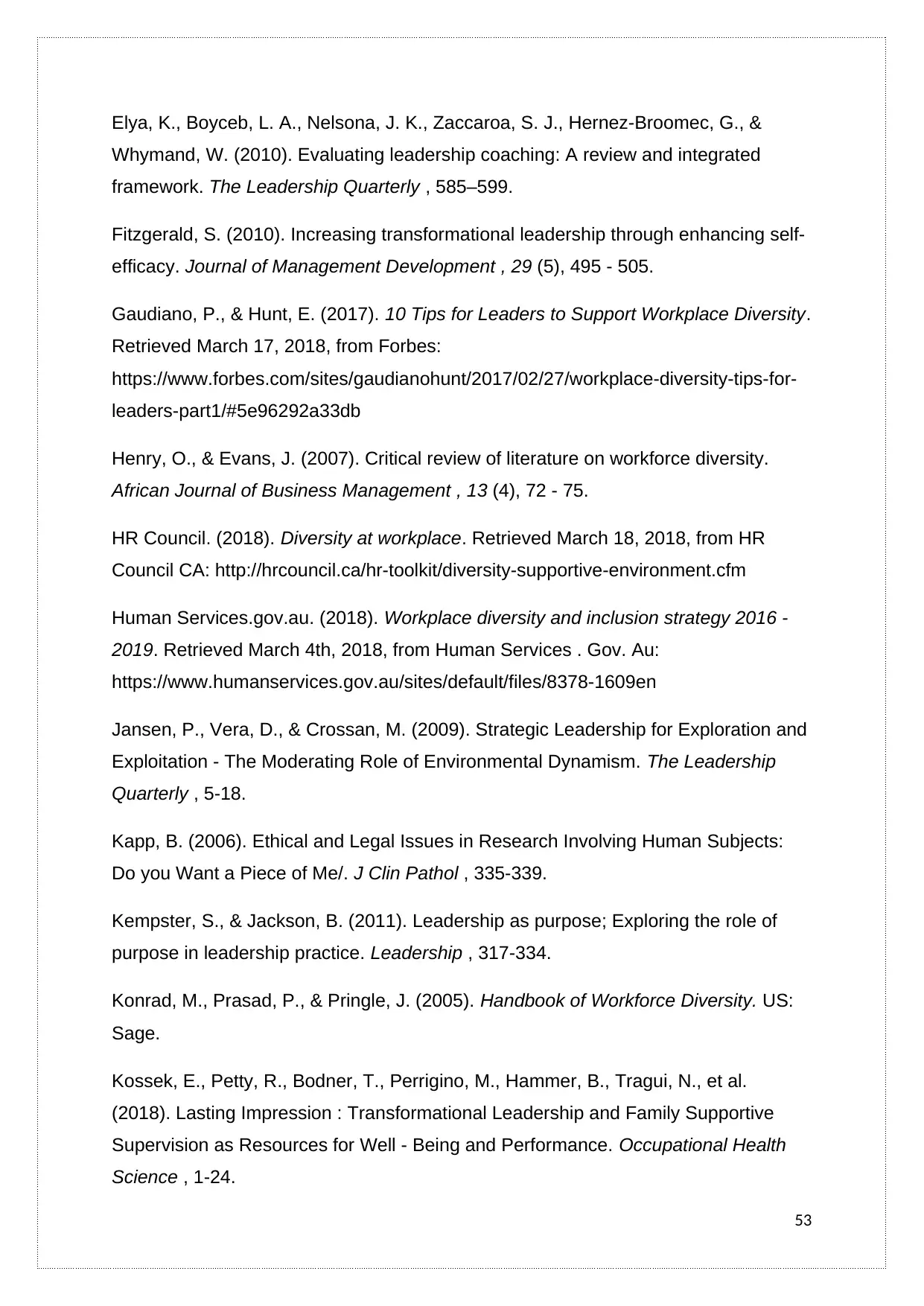
Elya, K., Boyceb, L. A., Nelsona, J. K., Zaccaroa, S. J., Hernez-Broomec, G., &
Whymand, W. (2010). Evaluating leadership coaching: A review and integrated
framework. The Leadership Quarterly , 585–599.
Fitzgerald, S. (2010). Increasing transformational leadership through enhancing self-
efficacy. Journal of Management Development , 29 (5), 495 - 505.
Gaudiano, P., & Hunt, E. (2017). 10 Tips for Leaders to Support Workplace Diversity.
Retrieved March 17, 2018, from Forbes:
https://www.forbes.com/sites/gaudianohunt/2017/02/27/workplace-diversity-tips-for-
leaders-part1/#5e96292a33db
Henry, O., & Evans, J. (2007). Critical review of literature on workforce diversity.
African Journal of Business Management , 13 (4), 72 - 75.
HR Council. (2018). Diversity at workplace. Retrieved March 18, 2018, from HR
Council CA: http://hrcouncil.ca/hr-toolkit/diversity-supportive-environment.cfm
Human Services.gov.au. (2018). Workplace diversity and inclusion strategy 2016 -
2019. Retrieved March 4th, 2018, from Human Services . Gov. Au:
https://www.humanservices.gov.au/sites/default/files/8378-1609en
Jansen, P., Vera, D., & Crossan, M. (2009). Strategic Leadership for Exploration and
Exploitation - The Moderating Role of Environmental Dynamism. The Leadership
Quarterly , 5-18.
Kapp, B. (2006). Ethical and Legal Issues in Research Involving Human Subjects:
Do you Want a Piece of Me/. J Clin Pathol , 335-339.
Kempster, S., & Jackson, B. (2011). Leadership as purpose; Exploring the role of
purpose in leadership practice. Leadership , 317-334.
Konrad, M., Prasad, P., & Pringle, J. (2005). Handbook of Workforce Diversity. US:
Sage.
Kossek, E., Petty, R., Bodner, T., Perrigino, M., Hammer, B., Tragui, N., et al.
(2018). Lasting Impression : Transformational Leadership and Family Supportive
Supervision as Resources for Well - Being and Performance. Occupational Health
Science , 1-24.
53
Whymand, W. (2010). Evaluating leadership coaching: A review and integrated
framework. The Leadership Quarterly , 585–599.
Fitzgerald, S. (2010). Increasing transformational leadership through enhancing self-
efficacy. Journal of Management Development , 29 (5), 495 - 505.
Gaudiano, P., & Hunt, E. (2017). 10 Tips for Leaders to Support Workplace Diversity.
Retrieved March 17, 2018, from Forbes:
https://www.forbes.com/sites/gaudianohunt/2017/02/27/workplace-diversity-tips-for-
leaders-part1/#5e96292a33db
Henry, O., & Evans, J. (2007). Critical review of literature on workforce diversity.
African Journal of Business Management , 13 (4), 72 - 75.
HR Council. (2018). Diversity at workplace. Retrieved March 18, 2018, from HR
Council CA: http://hrcouncil.ca/hr-toolkit/diversity-supportive-environment.cfm
Human Services.gov.au. (2018). Workplace diversity and inclusion strategy 2016 -
2019. Retrieved March 4th, 2018, from Human Services . Gov. Au:
https://www.humanservices.gov.au/sites/default/files/8378-1609en
Jansen, P., Vera, D., & Crossan, M. (2009). Strategic Leadership for Exploration and
Exploitation - The Moderating Role of Environmental Dynamism. The Leadership
Quarterly , 5-18.
Kapp, B. (2006). Ethical and Legal Issues in Research Involving Human Subjects:
Do you Want a Piece of Me/. J Clin Pathol , 335-339.
Kempster, S., & Jackson, B. (2011). Leadership as purpose; Exploring the role of
purpose in leadership practice. Leadership , 317-334.
Konrad, M., Prasad, P., & Pringle, J. (2005). Handbook of Workforce Diversity. US:
Sage.
Kossek, E., Petty, R., Bodner, T., Perrigino, M., Hammer, B., Tragui, N., et al.
(2018). Lasting Impression : Transformational Leadership and Family Supportive
Supervision as Resources for Well - Being and Performance. Occupational Health
Science , 1-24.
53
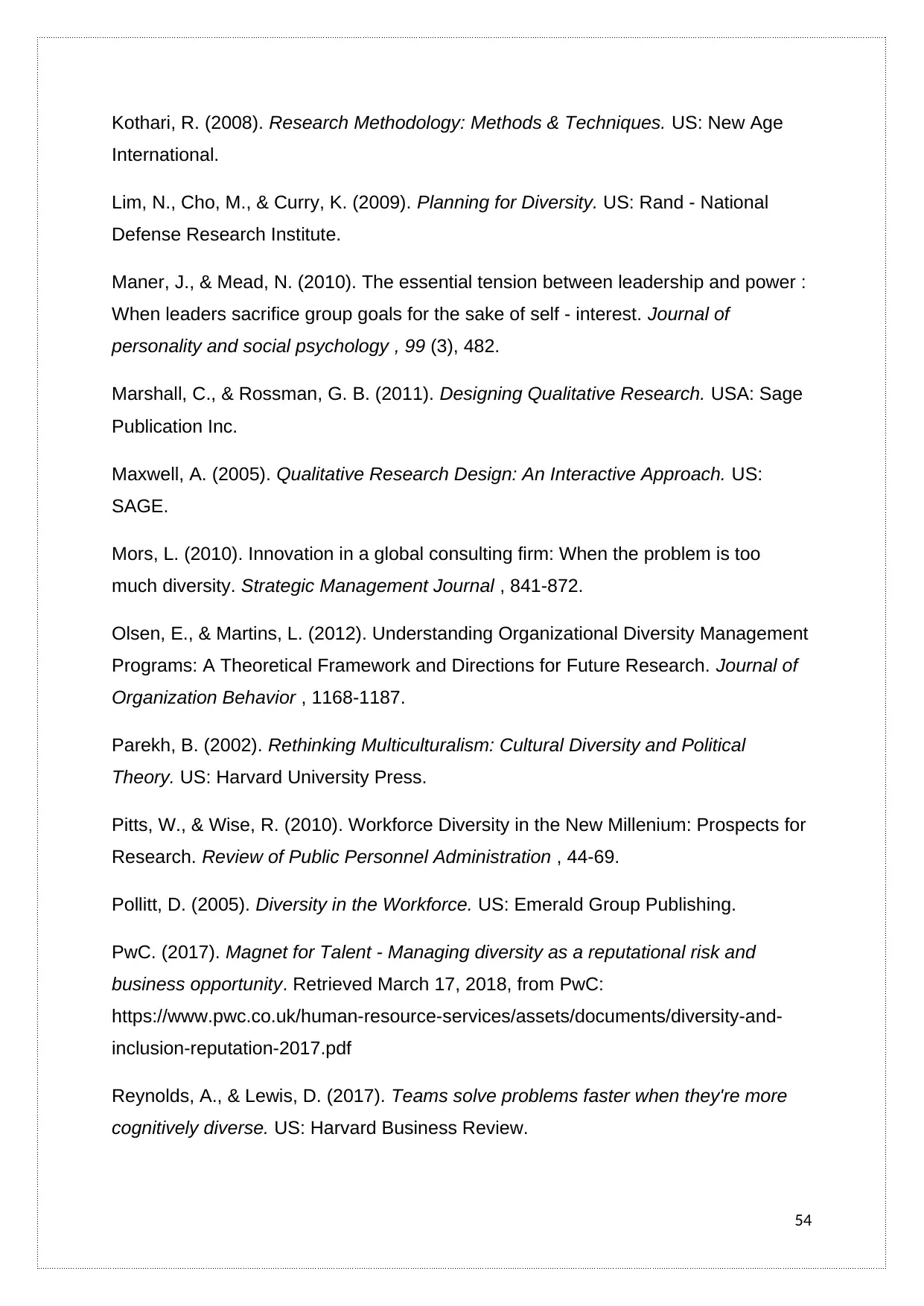
Kothari, R. (2008). Research Methodology: Methods & Techniques. US: New Age
International.
Lim, N., Cho, M., & Curry, K. (2009). Planning for Diversity. US: Rand - National
Defense Research Institute.
Maner, J., & Mead, N. (2010). The essential tension between leadership and power :
When leaders sacrifice group goals for the sake of self - interest. Journal of
personality and social psychology , 99 (3), 482.
Marshall, C., & Rossman, G. B. (2011). Designing Qualitative Research. USA: Sage
Publication Inc.
Maxwell, A. (2005). Qualitative Research Design: An Interactive Approach. US:
SAGE.
Mors, L. (2010). Innovation in a global consulting firm: When the problem is too
much diversity. Strategic Management Journal , 841-872.
Olsen, E., & Martins, L. (2012). Understanding Organizational Diversity Management
Programs: A Theoretical Framework and Directions for Future Research. Journal of
Organization Behavior , 1168-1187.
Parekh, B. (2002). Rethinking Multiculturalism: Cultural Diversity and Political
Theory. US: Harvard University Press.
Pitts, W., & Wise, R. (2010). Workforce Diversity in the New Millenium: Prospects for
Research. Review of Public Personnel Administration , 44-69.
Pollitt, D. (2005). Diversity in the Workforce. US: Emerald Group Publishing.
PwC. (2017). Magnet for Talent - Managing diversity as a reputational risk and
business opportunity. Retrieved March 17, 2018, from PwC:
https://www.pwc.co.uk/human-resource-services/assets/documents/diversity-and-
inclusion-reputation-2017.pdf
Reynolds, A., & Lewis, D. (2017). Teams solve problems faster when they're more
cognitively diverse. US: Harvard Business Review.
54
International.
Lim, N., Cho, M., & Curry, K. (2009). Planning for Diversity. US: Rand - National
Defense Research Institute.
Maner, J., & Mead, N. (2010). The essential tension between leadership and power :
When leaders sacrifice group goals for the sake of self - interest. Journal of
personality and social psychology , 99 (3), 482.
Marshall, C., & Rossman, G. B. (2011). Designing Qualitative Research. USA: Sage
Publication Inc.
Maxwell, A. (2005). Qualitative Research Design: An Interactive Approach. US:
SAGE.
Mors, L. (2010). Innovation in a global consulting firm: When the problem is too
much diversity. Strategic Management Journal , 841-872.
Olsen, E., & Martins, L. (2012). Understanding Organizational Diversity Management
Programs: A Theoretical Framework and Directions for Future Research. Journal of
Organization Behavior , 1168-1187.
Parekh, B. (2002). Rethinking Multiculturalism: Cultural Diversity and Political
Theory. US: Harvard University Press.
Pitts, W., & Wise, R. (2010). Workforce Diversity in the New Millenium: Prospects for
Research. Review of Public Personnel Administration , 44-69.
Pollitt, D. (2005). Diversity in the Workforce. US: Emerald Group Publishing.
PwC. (2017). Magnet for Talent - Managing diversity as a reputational risk and
business opportunity. Retrieved March 17, 2018, from PwC:
https://www.pwc.co.uk/human-resource-services/assets/documents/diversity-and-
inclusion-reputation-2017.pdf
Reynolds, A., & Lewis, D. (2017). Teams solve problems faster when they're more
cognitively diverse. US: Harvard Business Review.
54
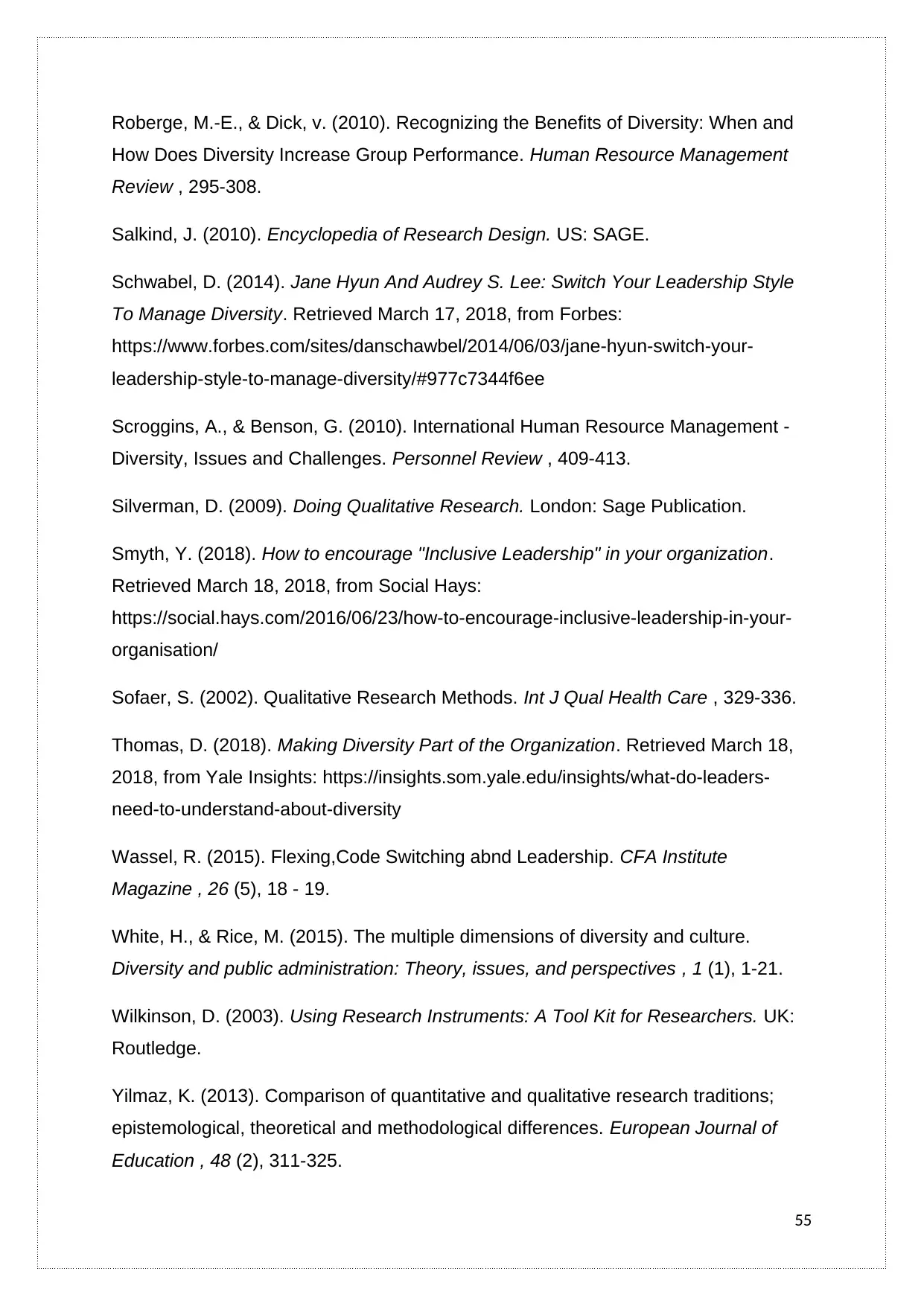
Roberge, M.-E., & Dick, v. (2010). Recognizing the Benefits of Diversity: When and
How Does Diversity Increase Group Performance. Human Resource Management
Review , 295-308.
Salkind, J. (2010). Encyclopedia of Research Design. US: SAGE.
Schwabel, D. (2014). Jane Hyun And Audrey S. Lee: Switch Your Leadership Style
To Manage Diversity. Retrieved March 17, 2018, from Forbes:
https://www.forbes.com/sites/danschawbel/2014/06/03/jane-hyun-switch-your-
leadership-style-to-manage-diversity/#977c7344f6ee
Scroggins, A., & Benson, G. (2010). International Human Resource Management -
Diversity, Issues and Challenges. Personnel Review , 409-413.
Silverman, D. (2009). Doing Qualitative Research. London: Sage Publication.
Smyth, Y. (2018). How to encourage "Inclusive Leadership" in your organization.
Retrieved March 18, 2018, from Social Hays:
https://social.hays.com/2016/06/23/how-to-encourage-inclusive-leadership-in-your-
organisation/
Sofaer, S. (2002). Qualitative Research Methods. Int J Qual Health Care , 329-336.
Thomas, D. (2018). Making Diversity Part of the Organization. Retrieved March 18,
2018, from Yale Insights: https://insights.som.yale.edu/insights/what-do-leaders-
need-to-understand-about-diversity
Wassel, R. (2015). Flexing,Code Switching abnd Leadership. CFA Institute
Magazine , 26 (5), 18 - 19.
White, H., & Rice, M. (2015). The multiple dimensions of diversity and culture.
Diversity and public administration: Theory, issues, and perspectives , 1 (1), 1-21.
Wilkinson, D. (2003). Using Research Instruments: A Tool Kit for Researchers. UK:
Routledge.
Yilmaz, K. (2013). Comparison of quantitative and qualitative research traditions;
epistemological, theoretical and methodological differences. European Journal of
Education , 48 (2), 311-325.
55
How Does Diversity Increase Group Performance. Human Resource Management
Review , 295-308.
Salkind, J. (2010). Encyclopedia of Research Design. US: SAGE.
Schwabel, D. (2014). Jane Hyun And Audrey S. Lee: Switch Your Leadership Style
To Manage Diversity. Retrieved March 17, 2018, from Forbes:
https://www.forbes.com/sites/danschawbel/2014/06/03/jane-hyun-switch-your-
leadership-style-to-manage-diversity/#977c7344f6ee
Scroggins, A., & Benson, G. (2010). International Human Resource Management -
Diversity, Issues and Challenges. Personnel Review , 409-413.
Silverman, D. (2009). Doing Qualitative Research. London: Sage Publication.
Smyth, Y. (2018). How to encourage "Inclusive Leadership" in your organization.
Retrieved March 18, 2018, from Social Hays:
https://social.hays.com/2016/06/23/how-to-encourage-inclusive-leadership-in-your-
organisation/
Sofaer, S. (2002). Qualitative Research Methods. Int J Qual Health Care , 329-336.
Thomas, D. (2018). Making Diversity Part of the Organization. Retrieved March 18,
2018, from Yale Insights: https://insights.som.yale.edu/insights/what-do-leaders-
need-to-understand-about-diversity
Wassel, R. (2015). Flexing,Code Switching abnd Leadership. CFA Institute
Magazine , 26 (5), 18 - 19.
White, H., & Rice, M. (2015). The multiple dimensions of diversity and culture.
Diversity and public administration: Theory, issues, and perspectives , 1 (1), 1-21.
Wilkinson, D. (2003). Using Research Instruments: A Tool Kit for Researchers. UK:
Routledge.
Yilmaz, K. (2013). Comparison of quantitative and qualitative research traditions;
epistemological, theoretical and methodological differences. European Journal of
Education , 48 (2), 311-325.
55
Paraphrase This Document
Need a fresh take? Get an instant paraphrase of this document with our AI Paraphraser

56
1 out of 56
Related Documents
Your All-in-One AI-Powered Toolkit for Academic Success.
+13062052269
info@desklib.com
Available 24*7 on WhatsApp / Email
![[object Object]](/_next/static/media/star-bottom.7253800d.svg)
Unlock your academic potential
© 2024 | Zucol Services PVT LTD | All rights reserved.





